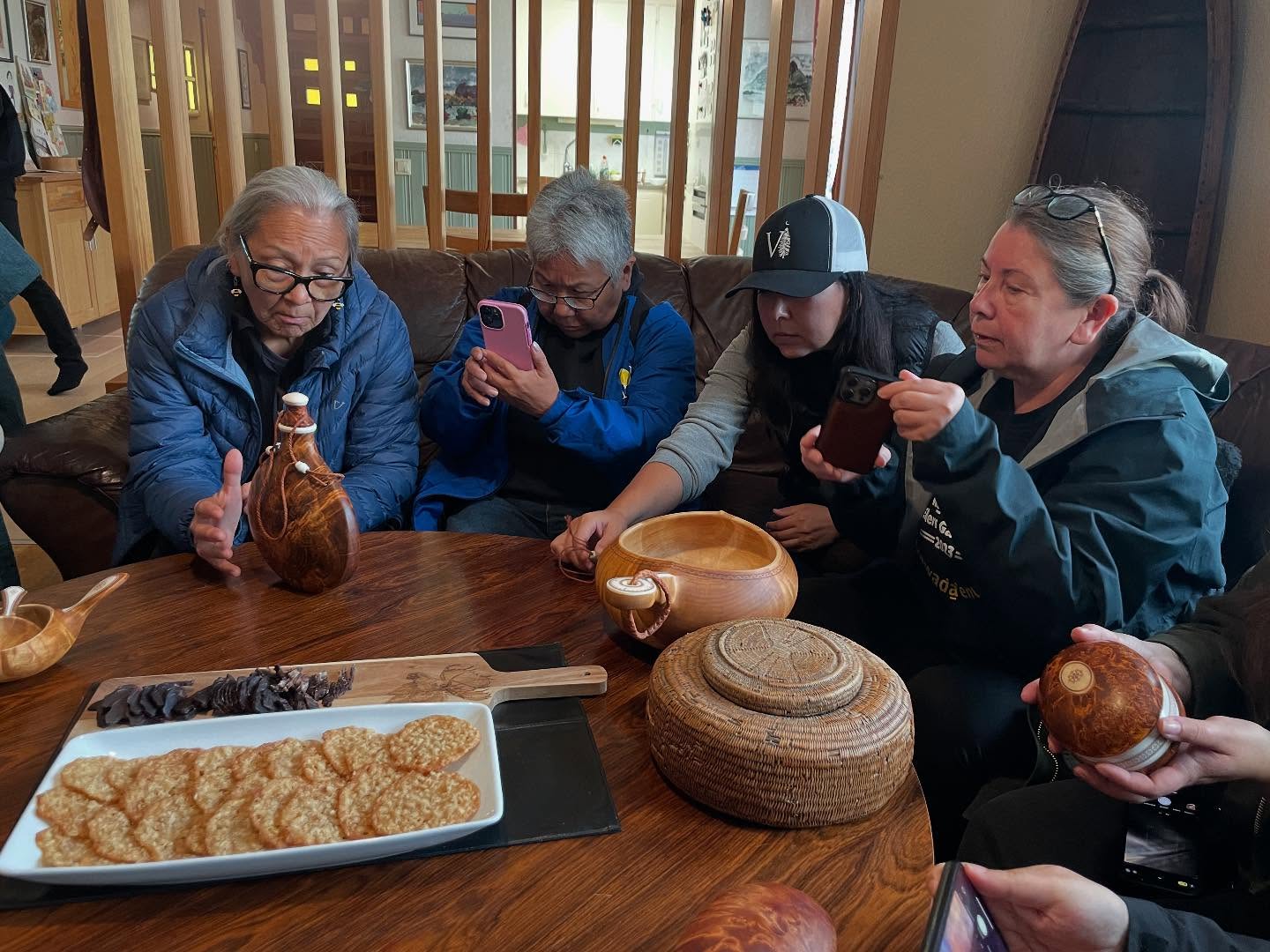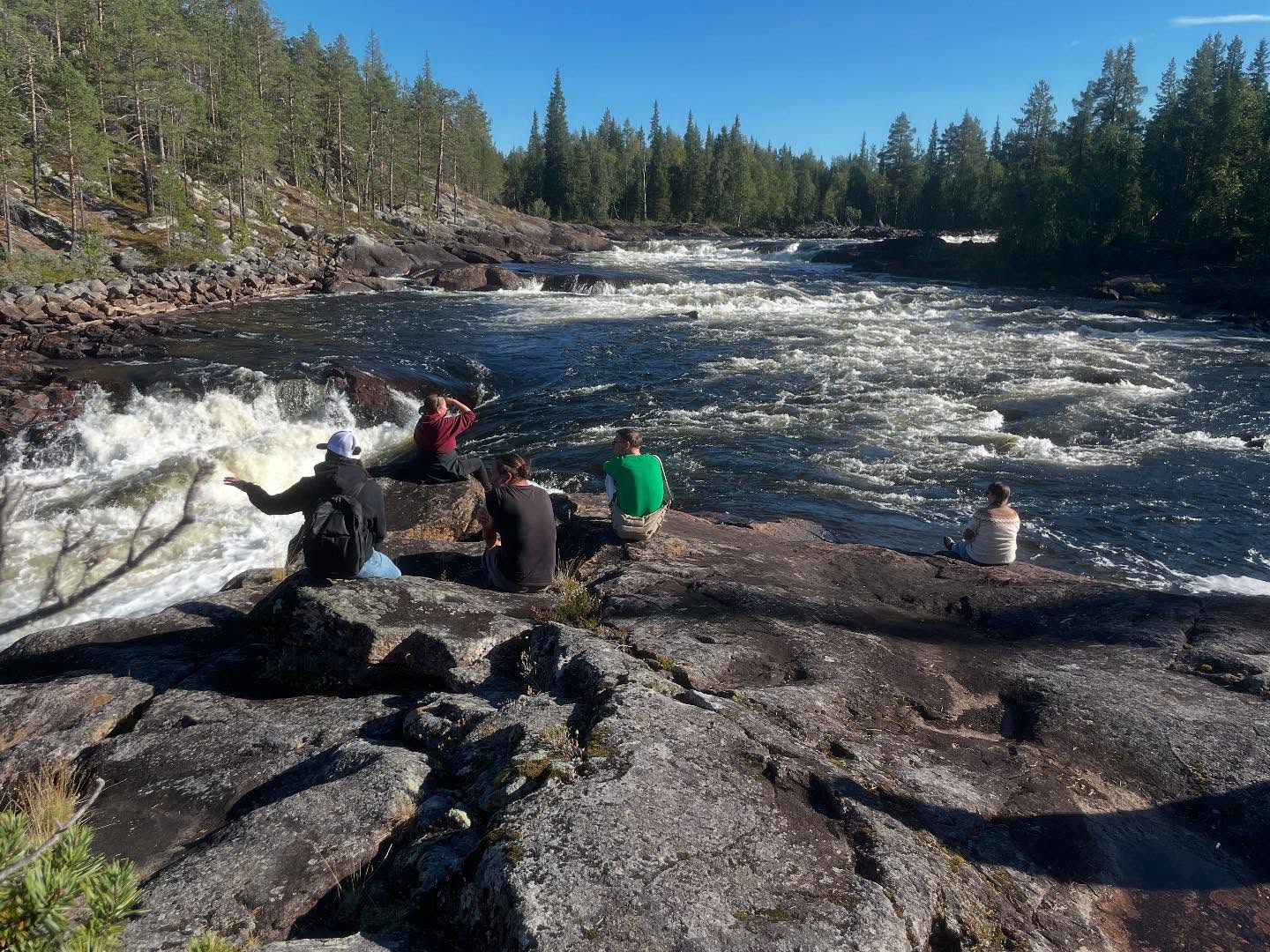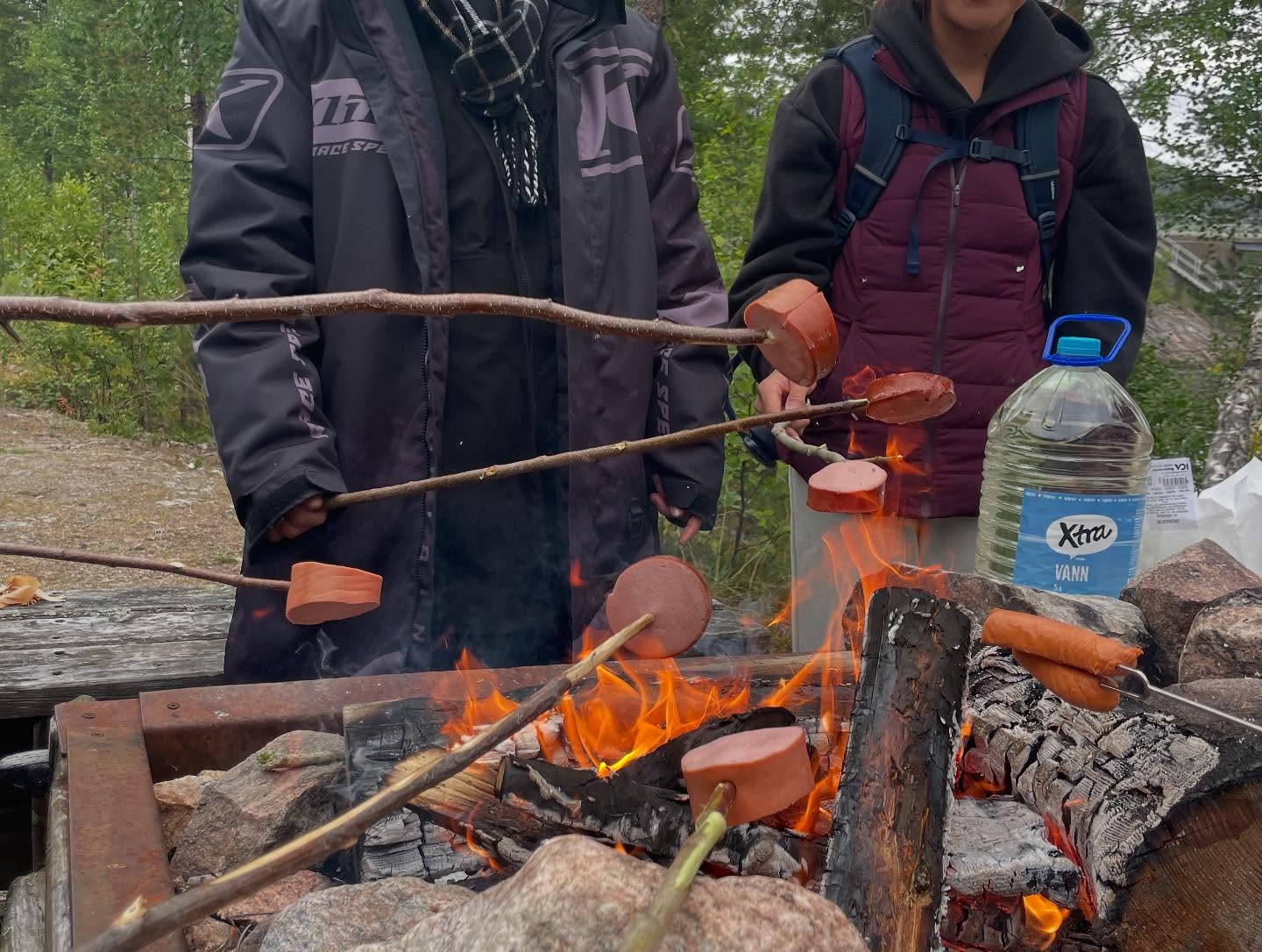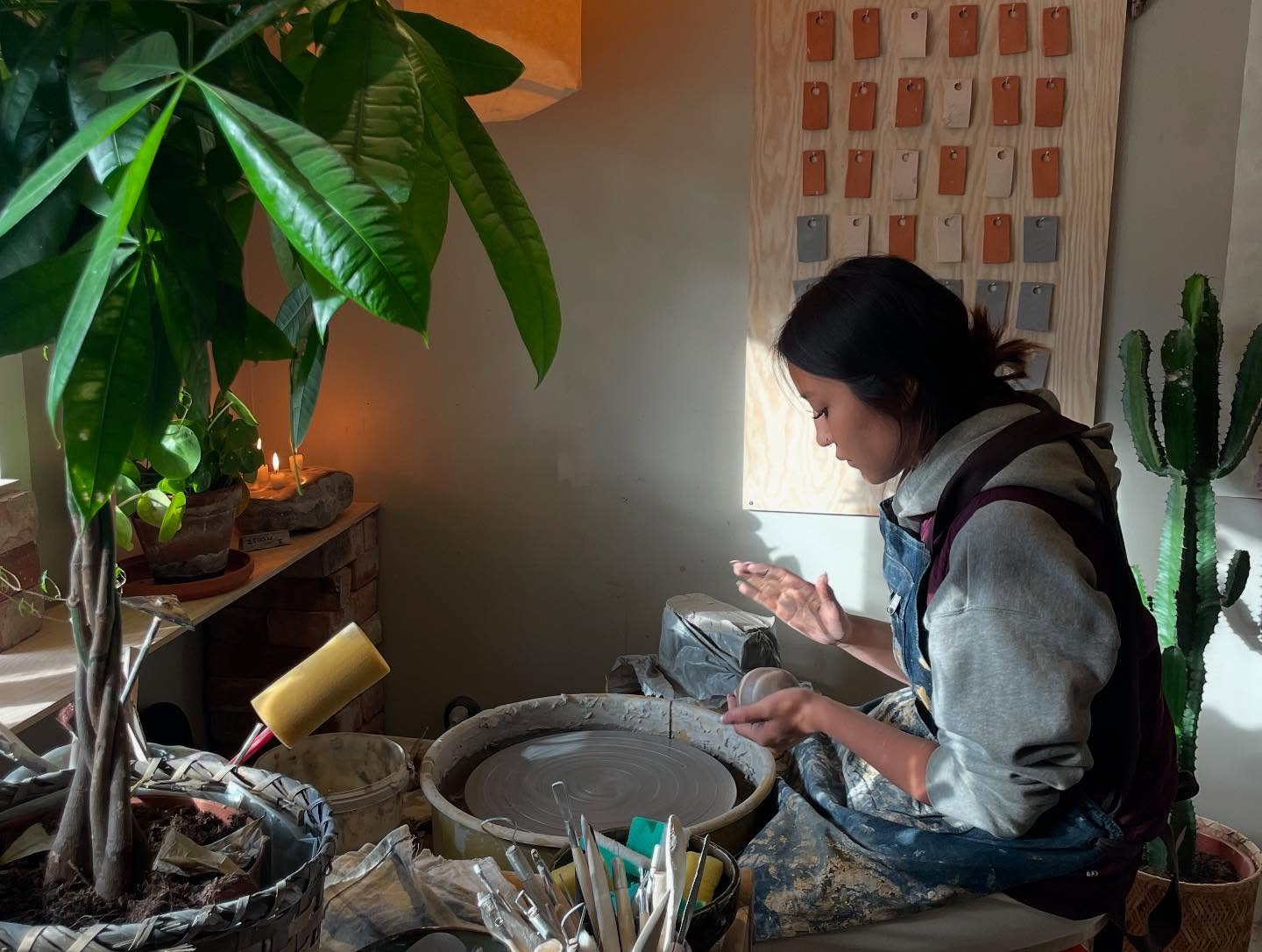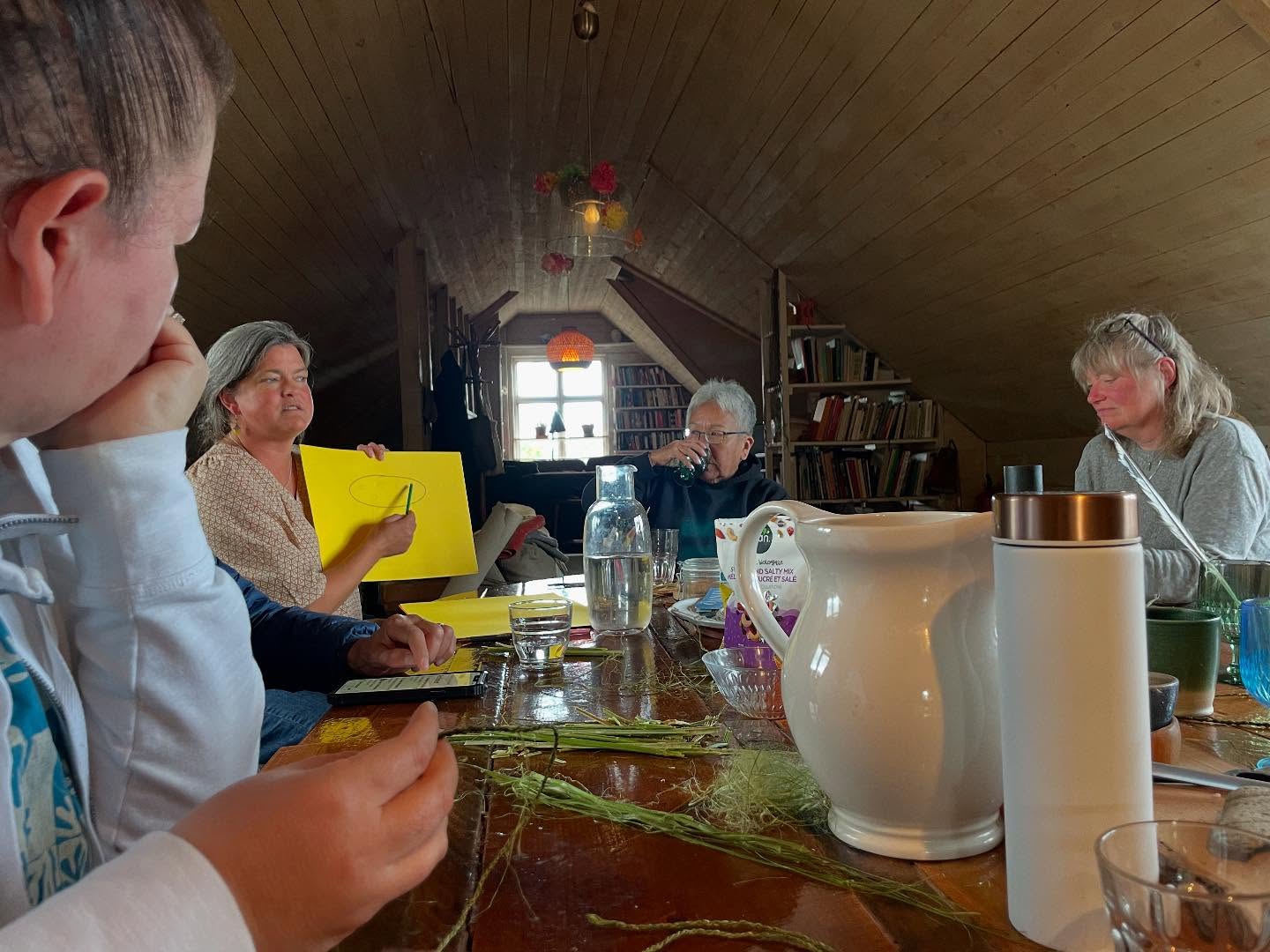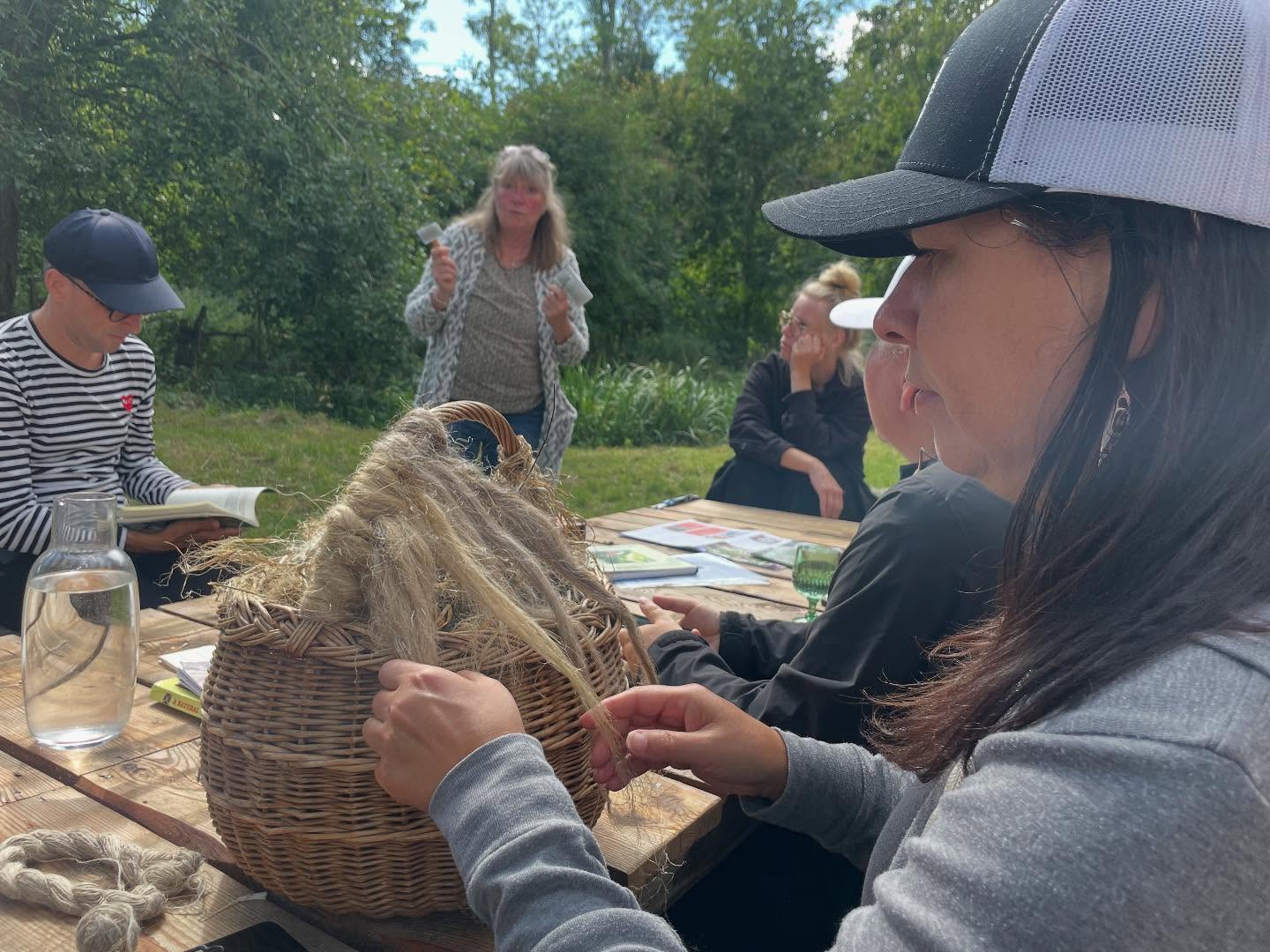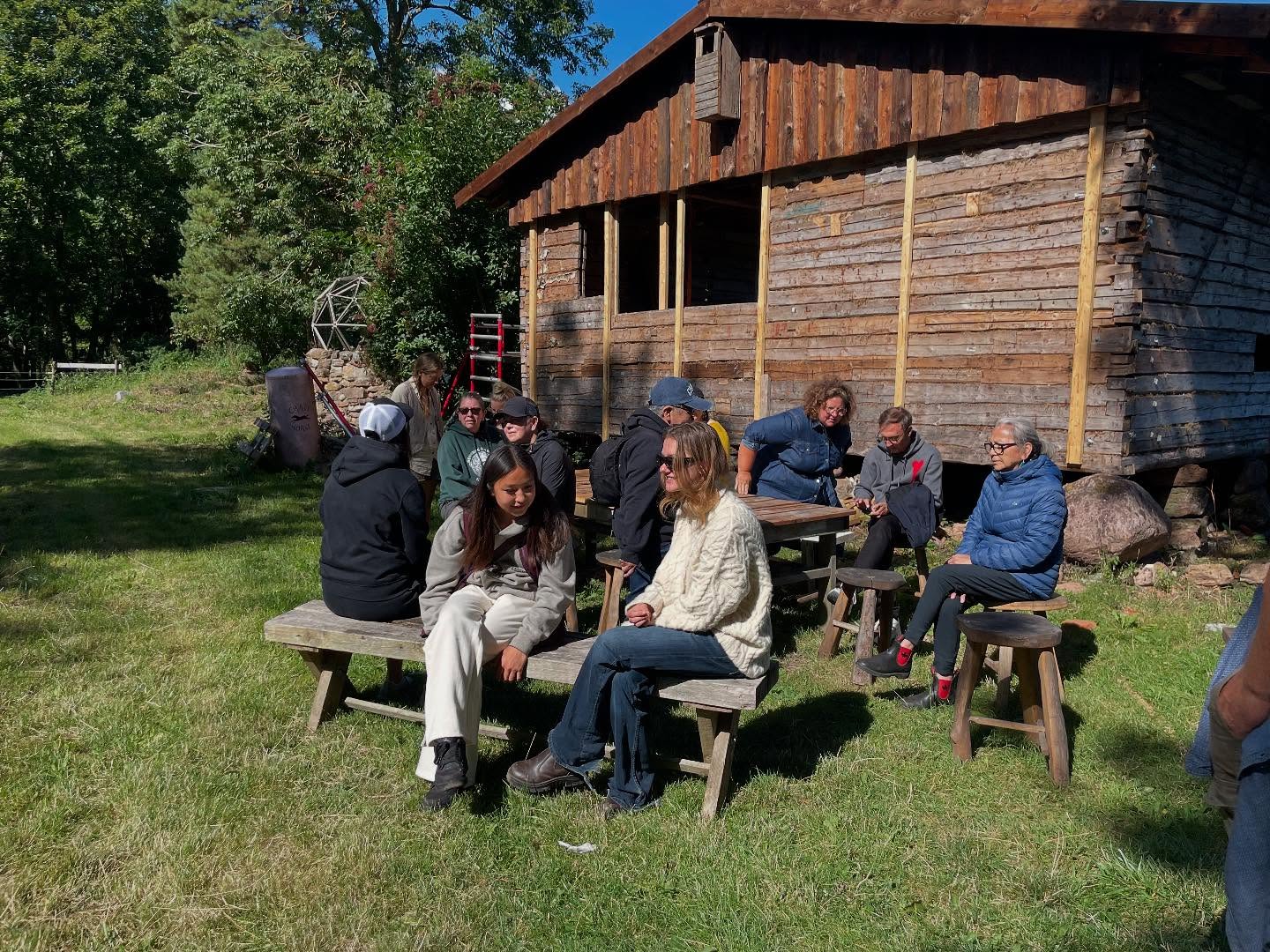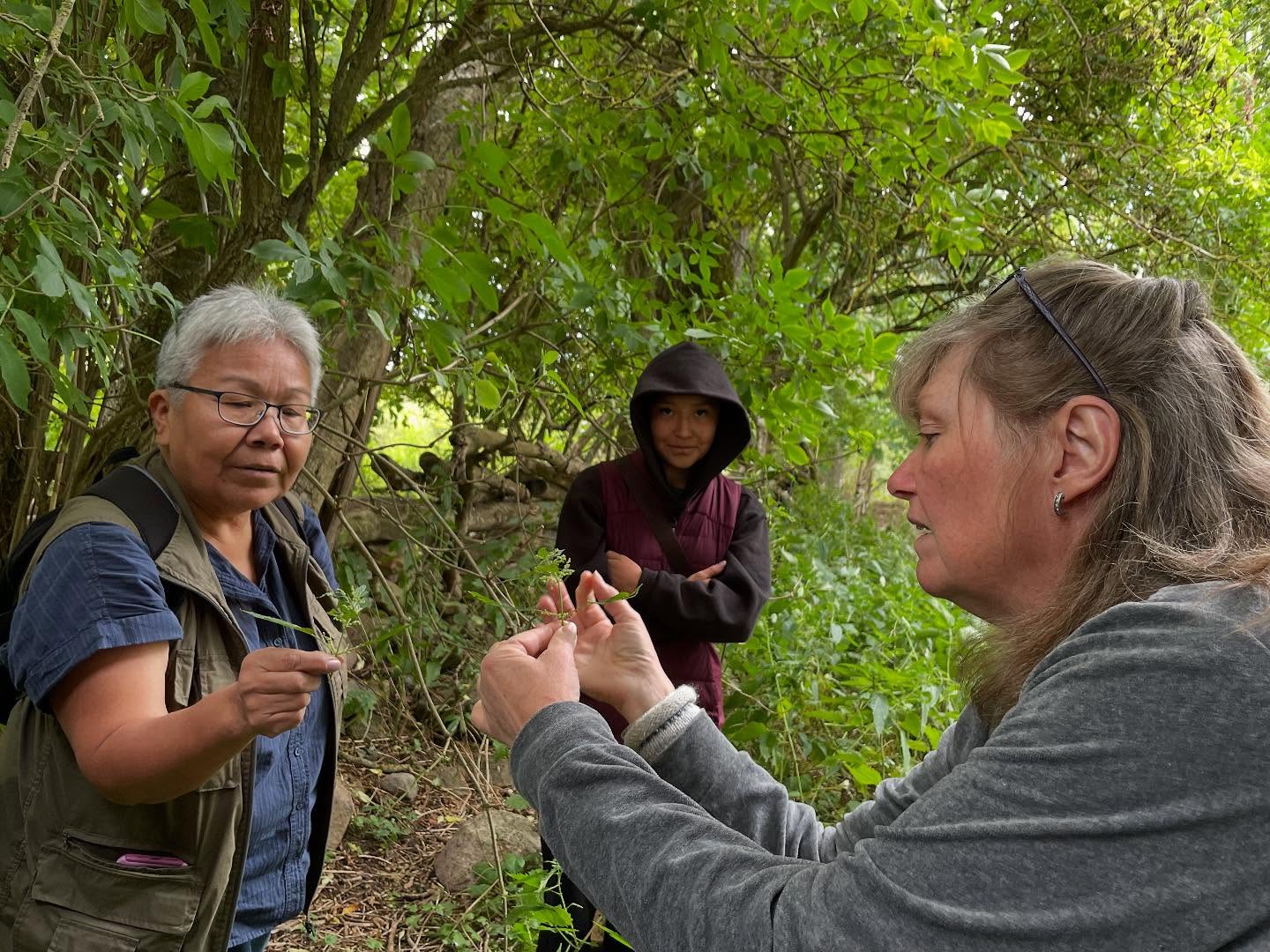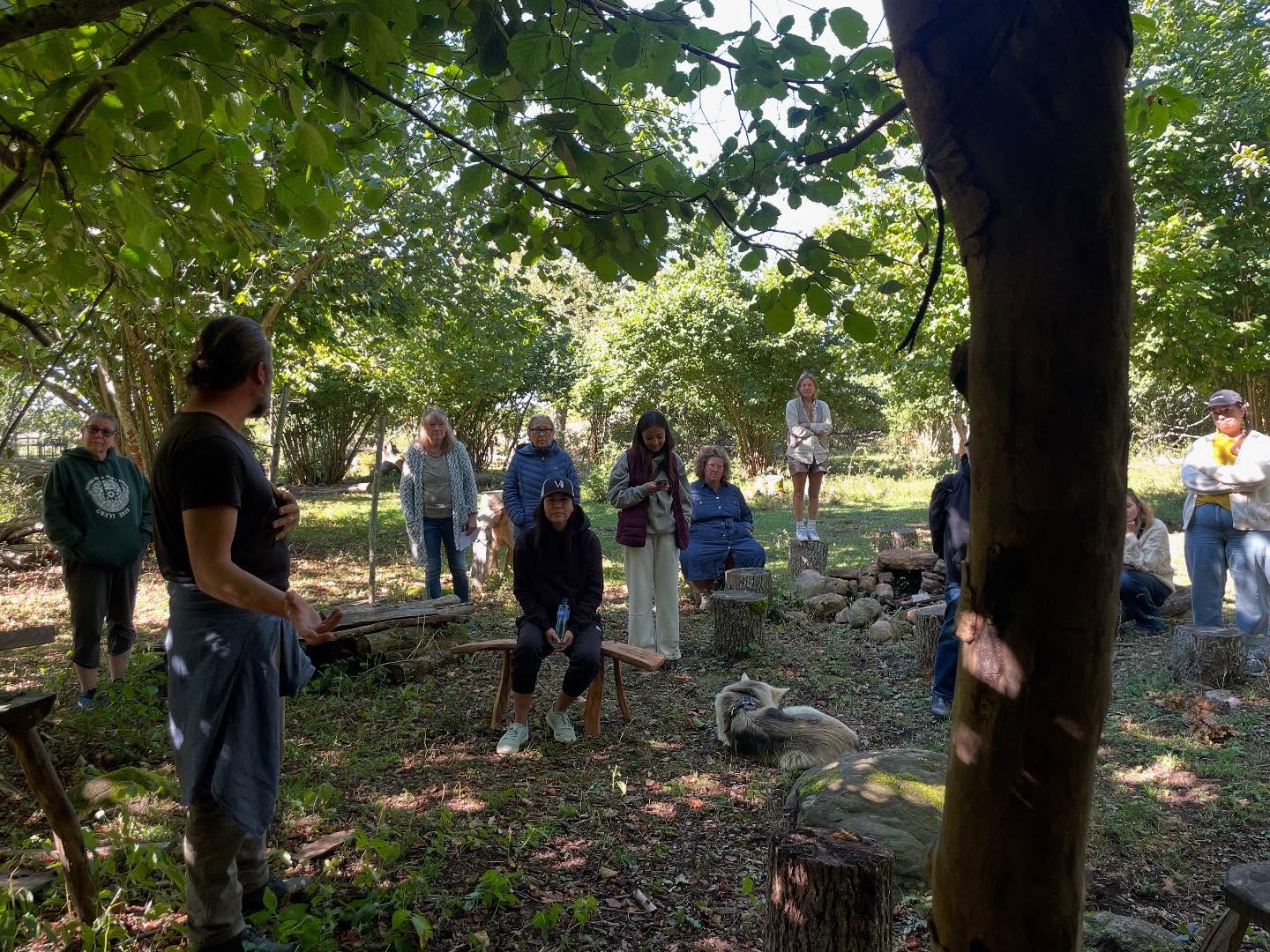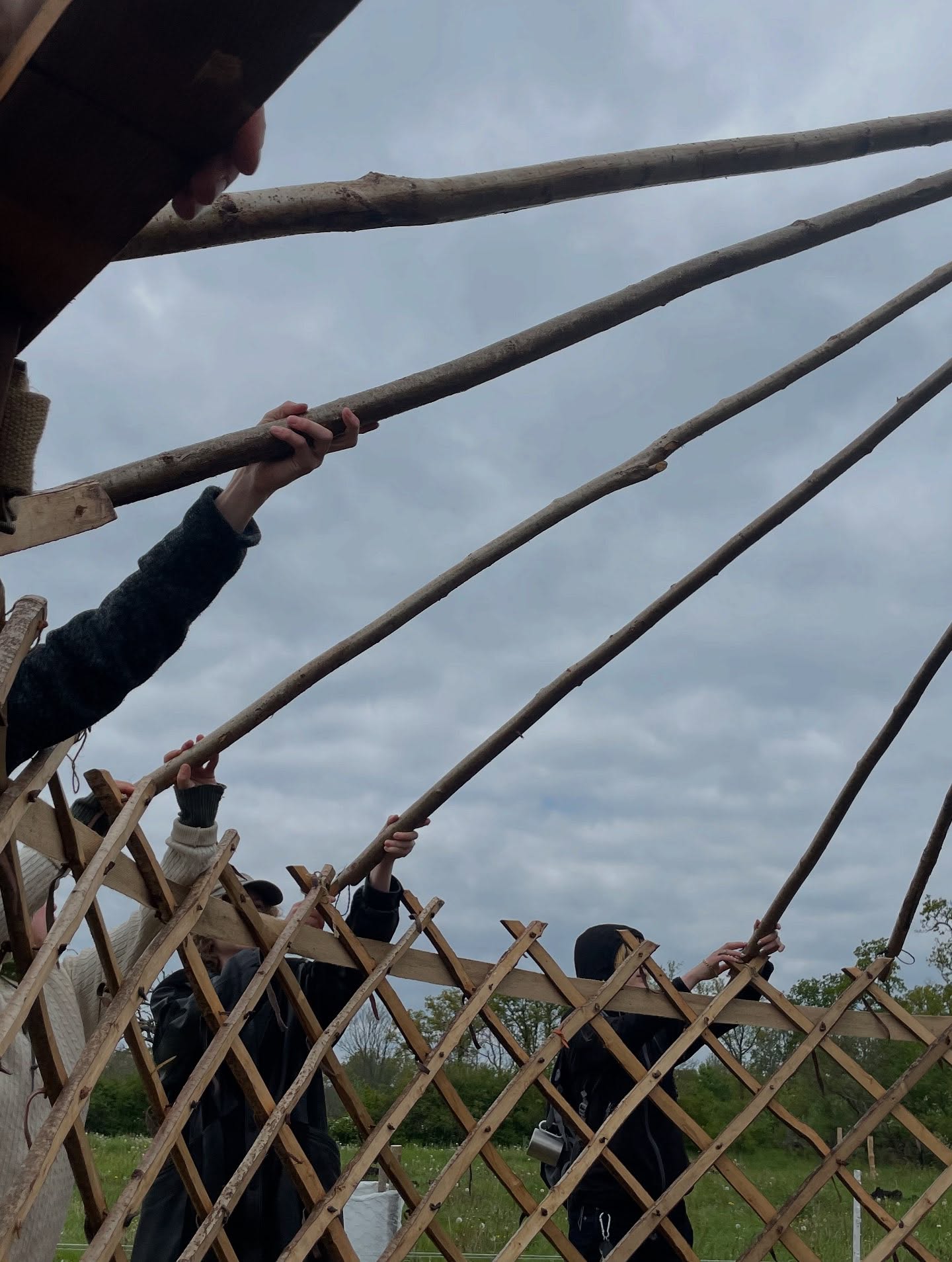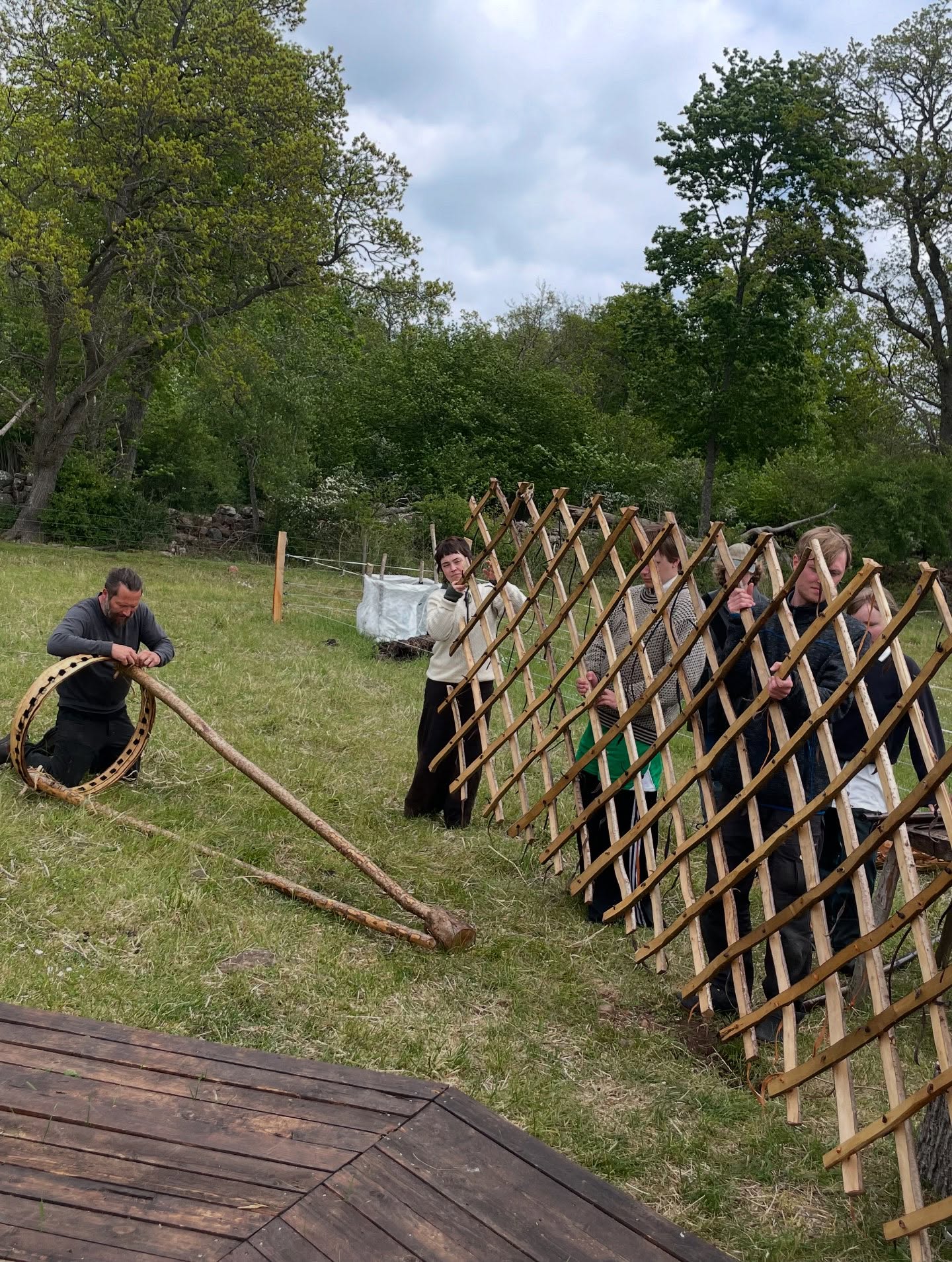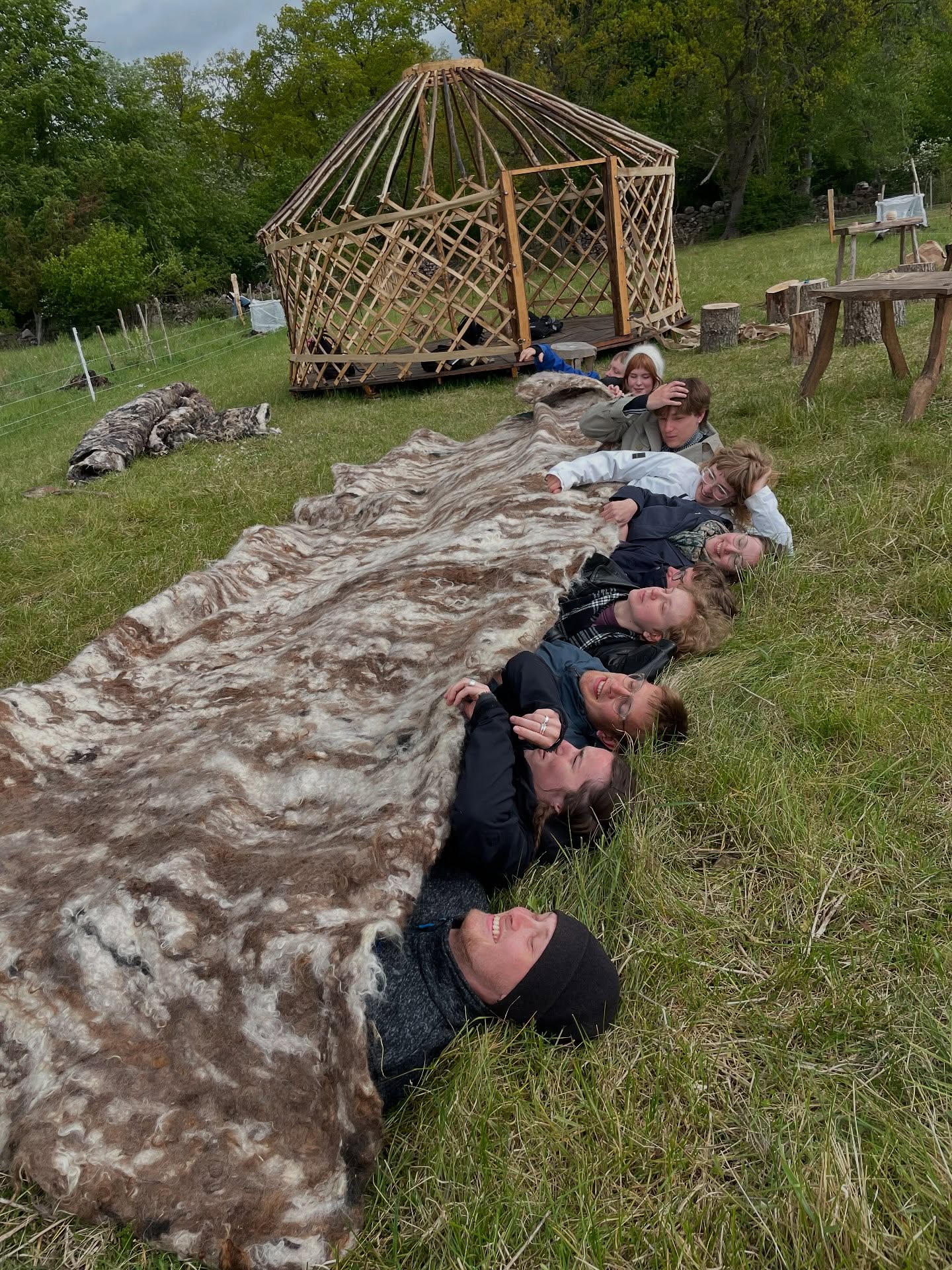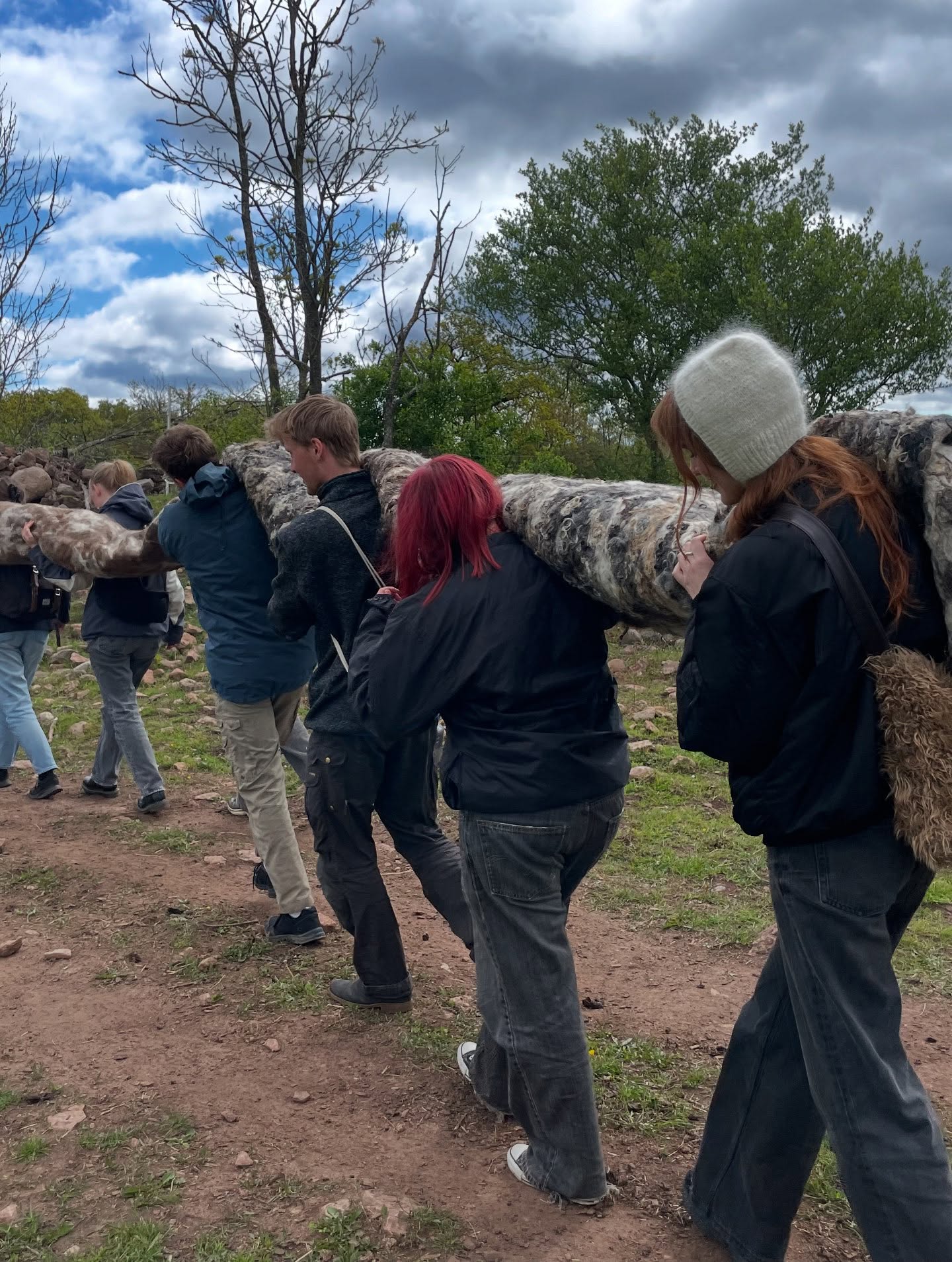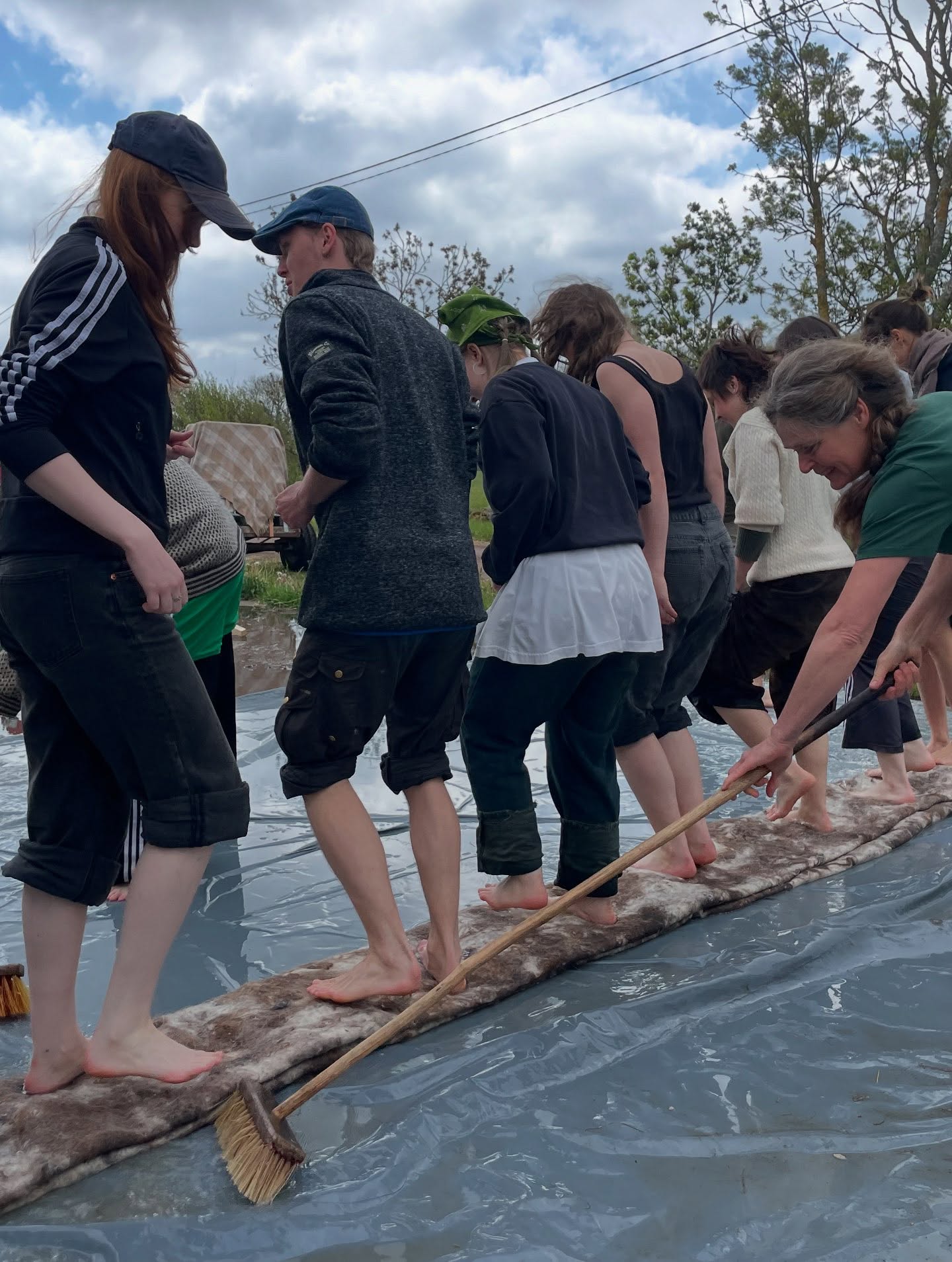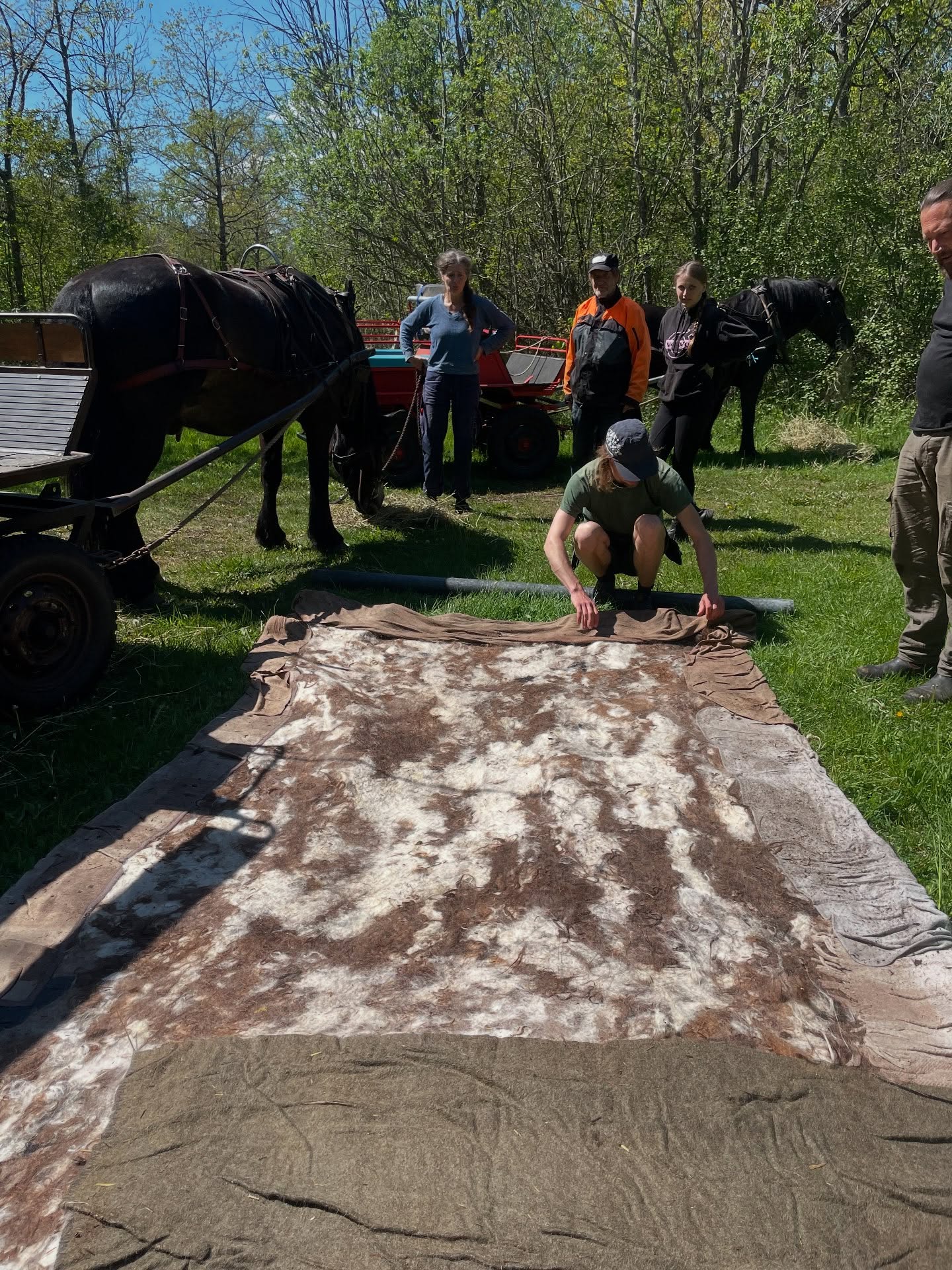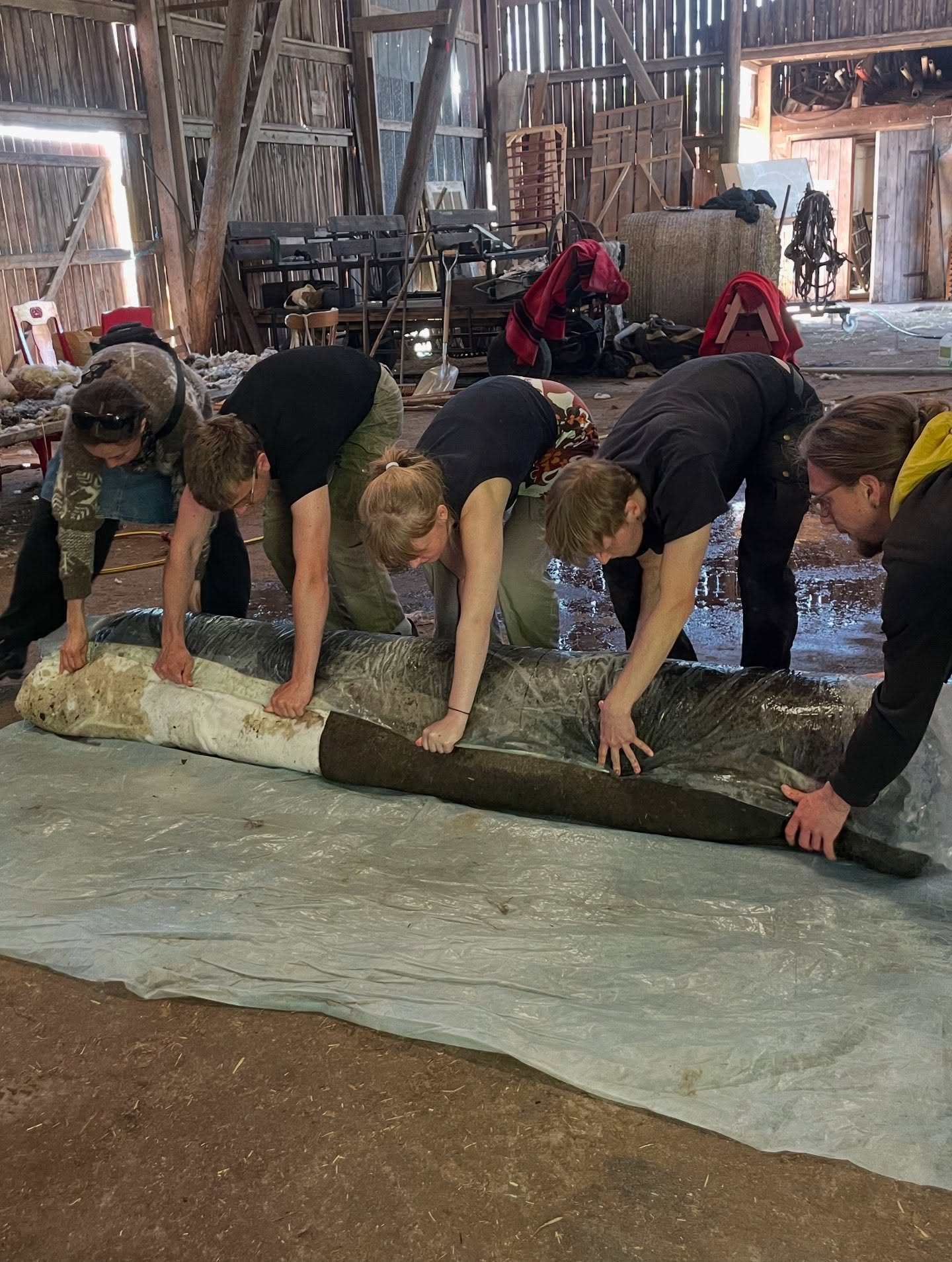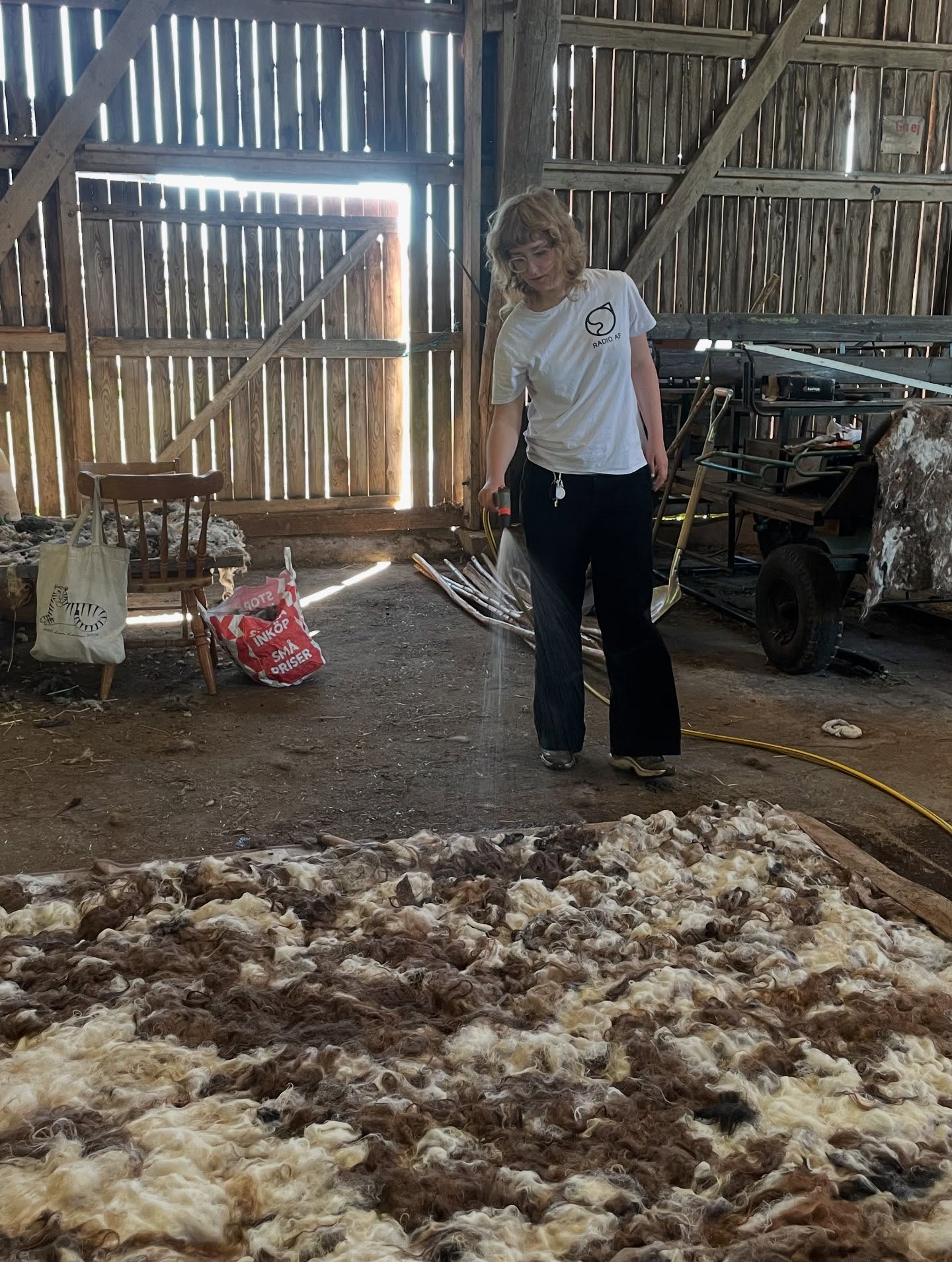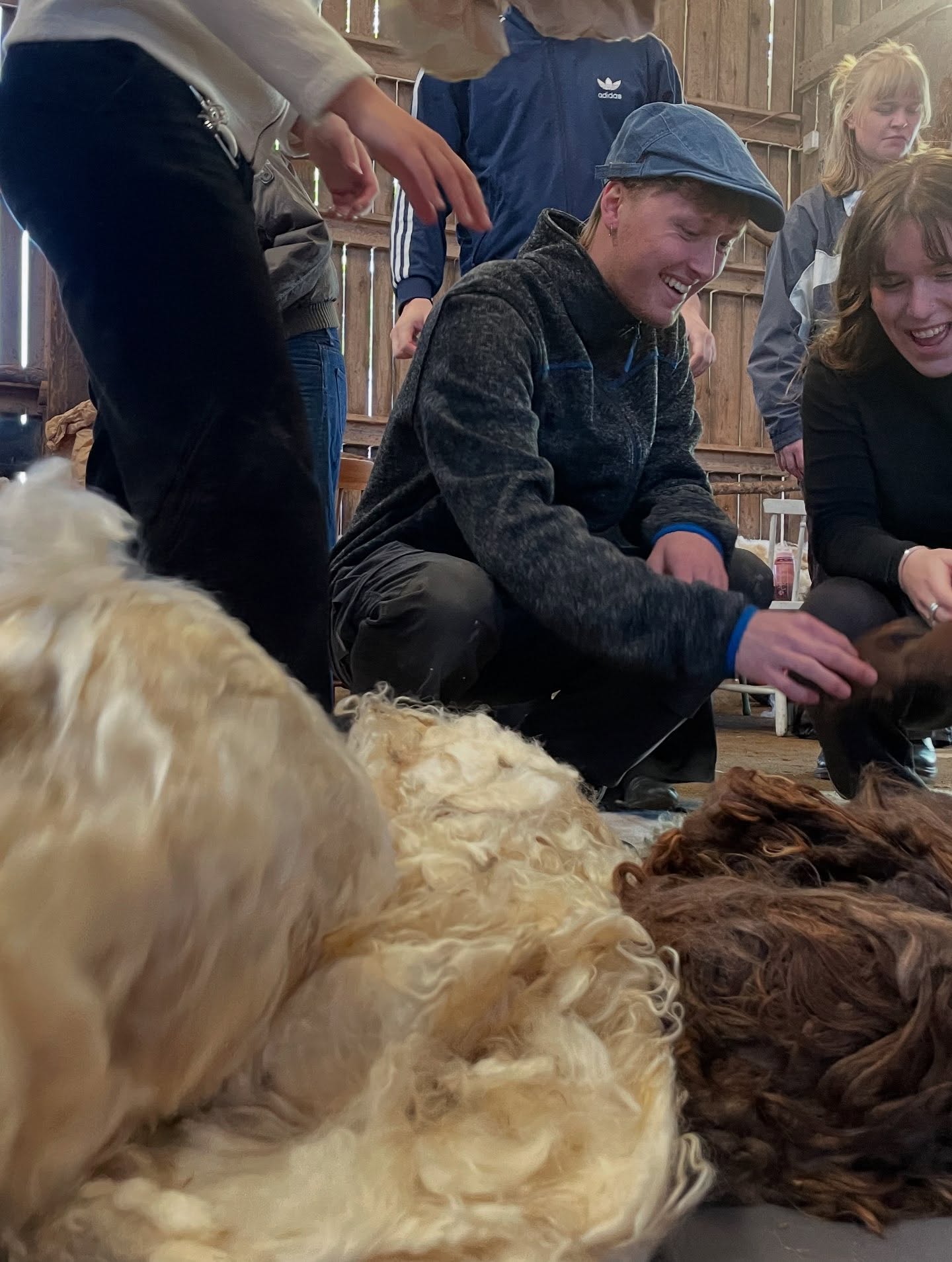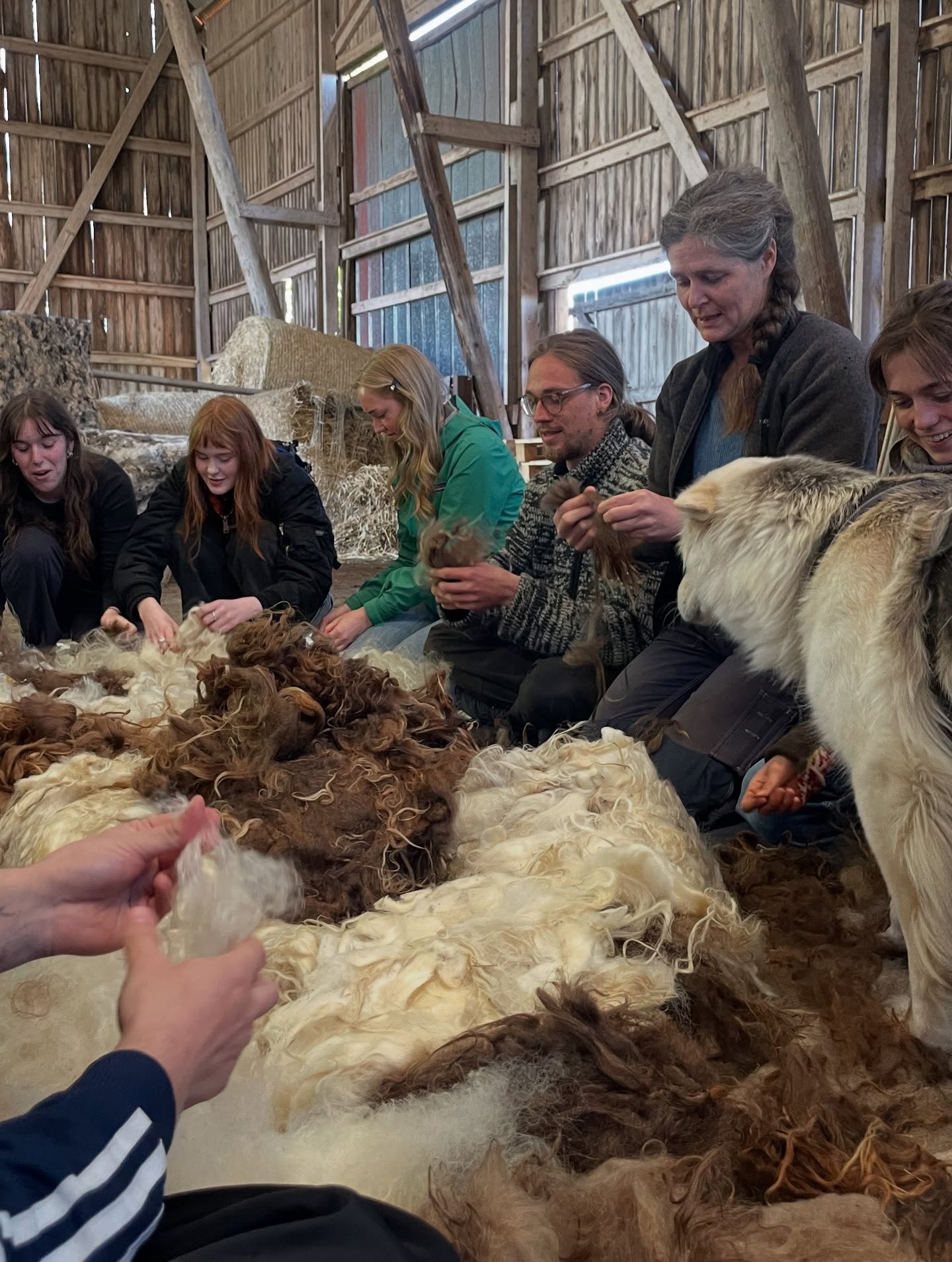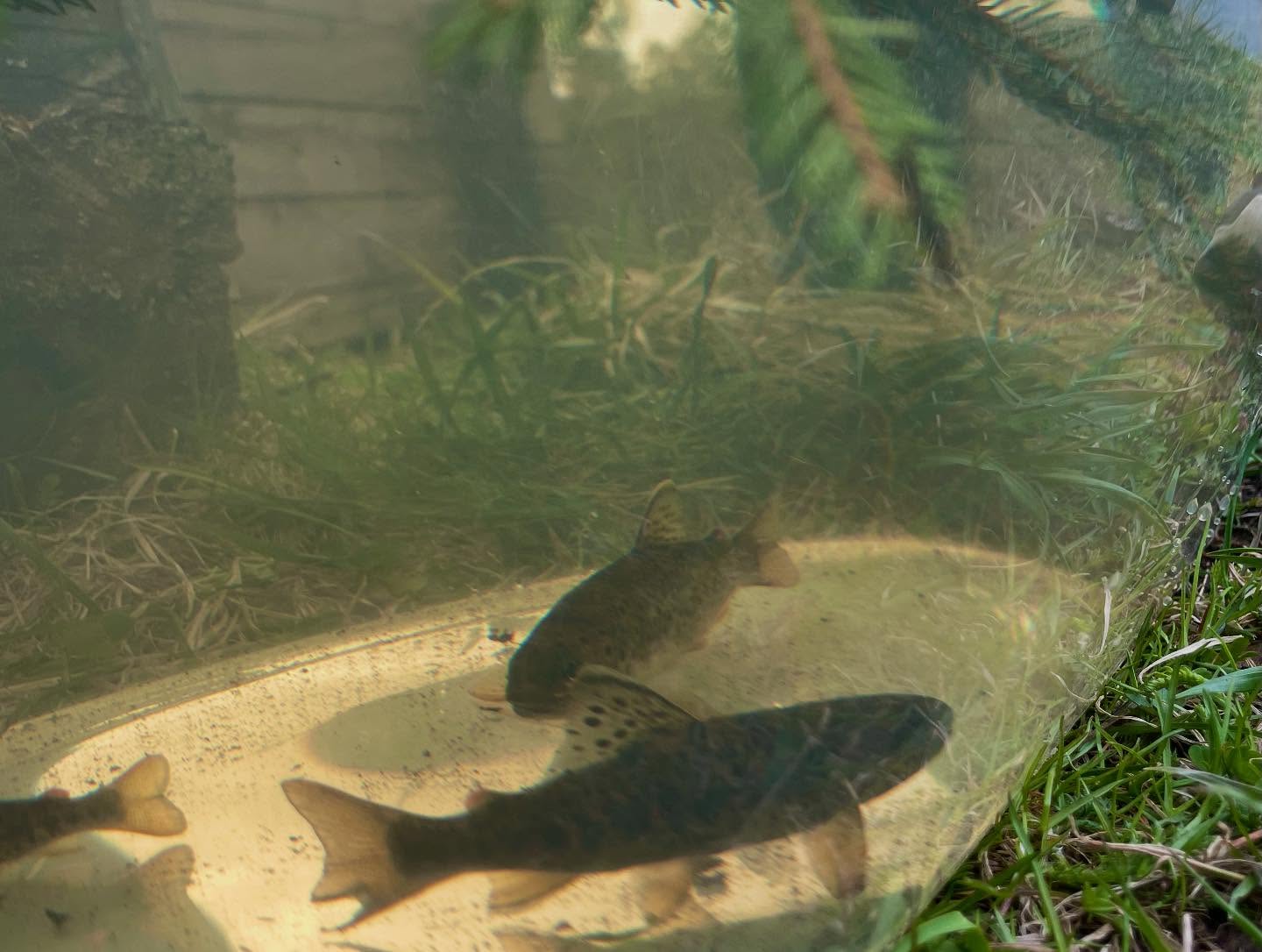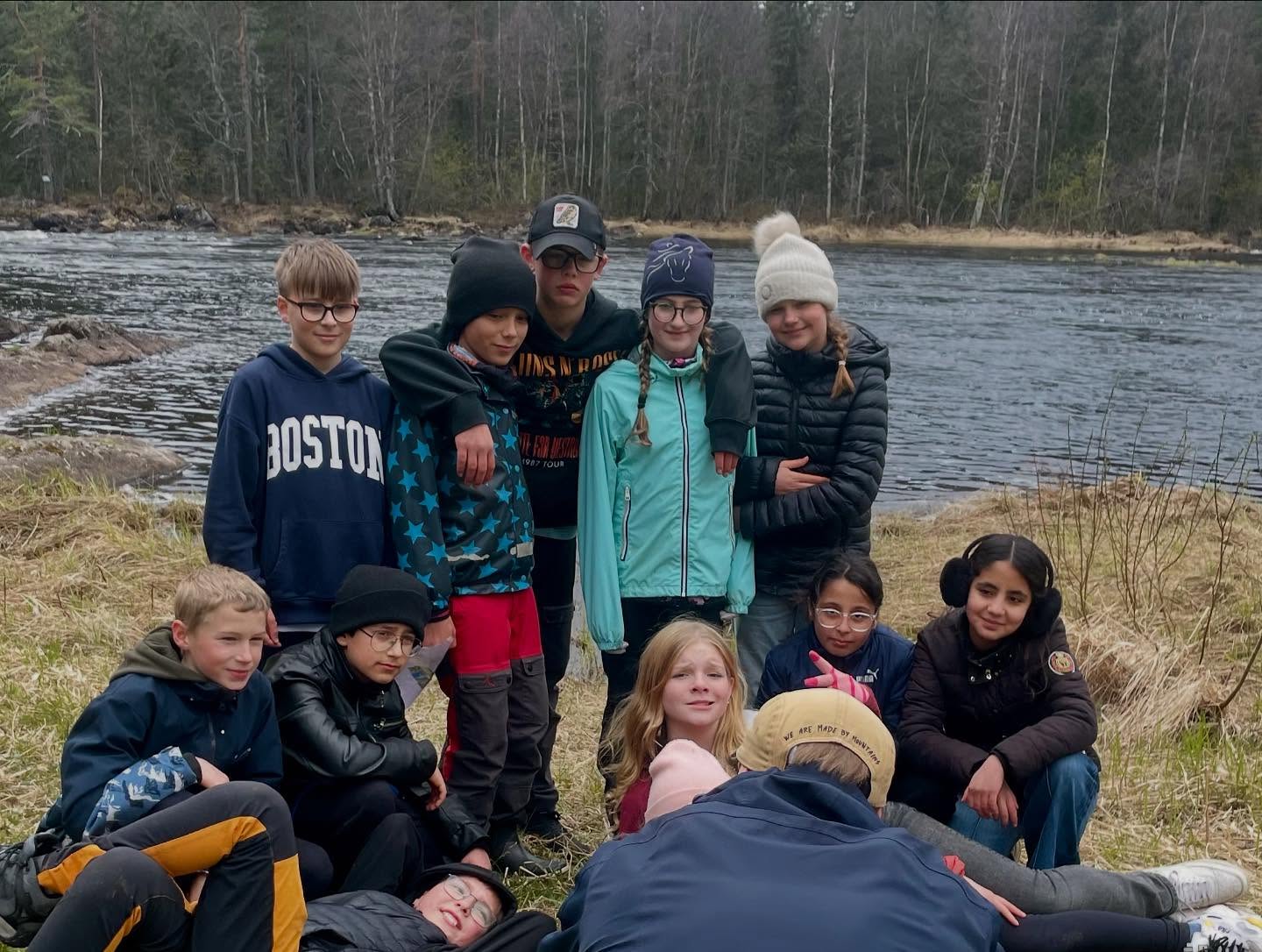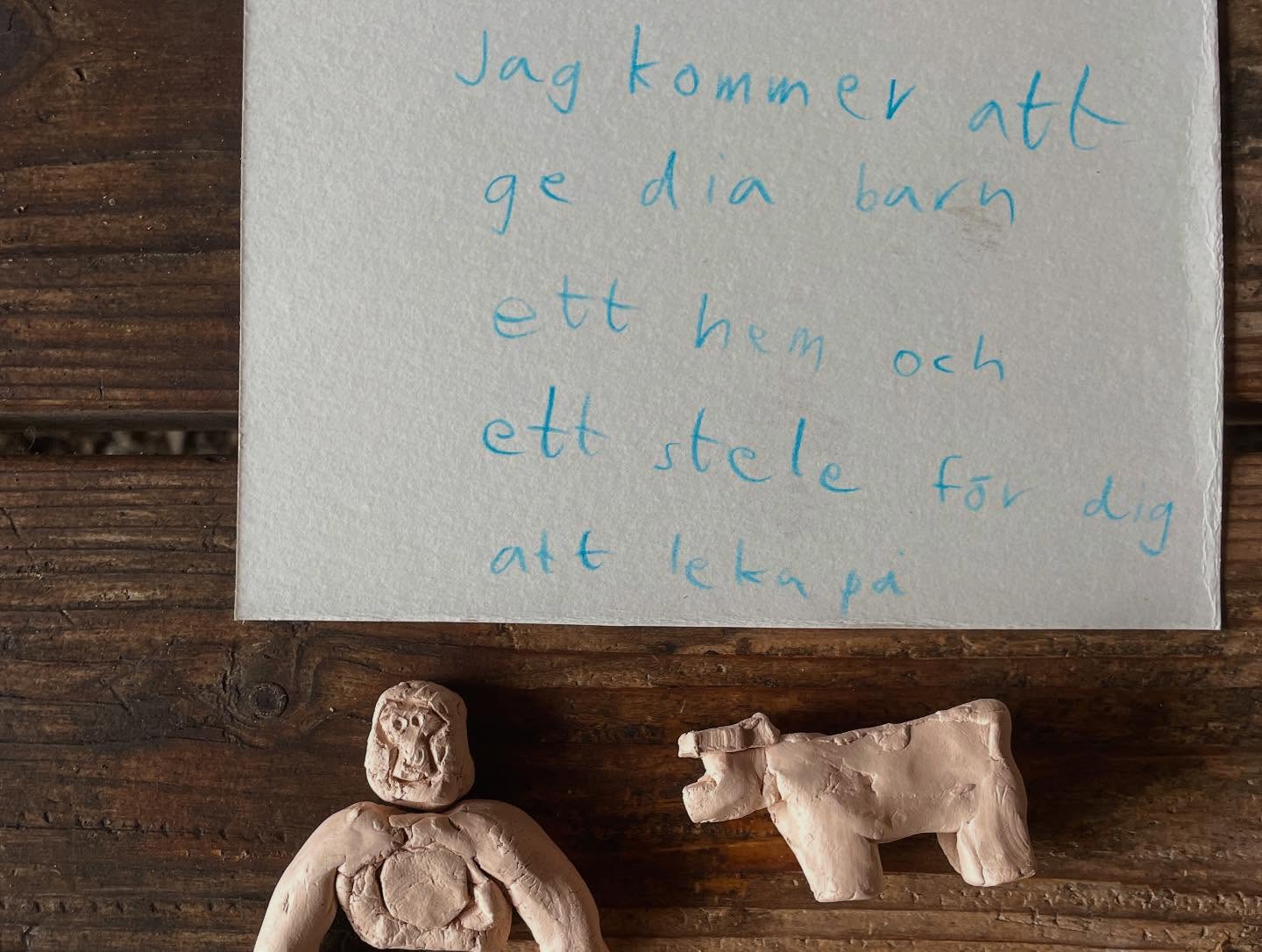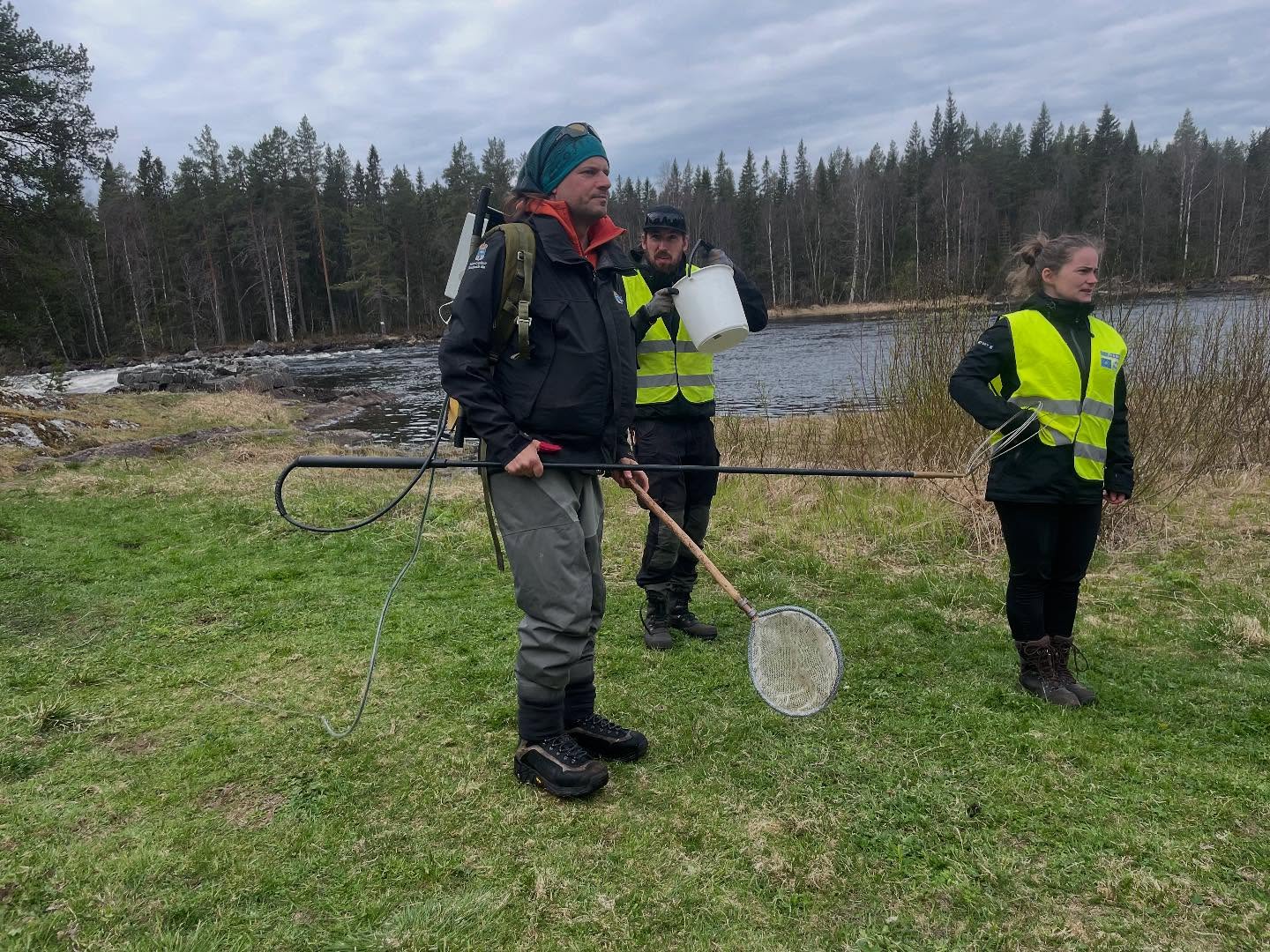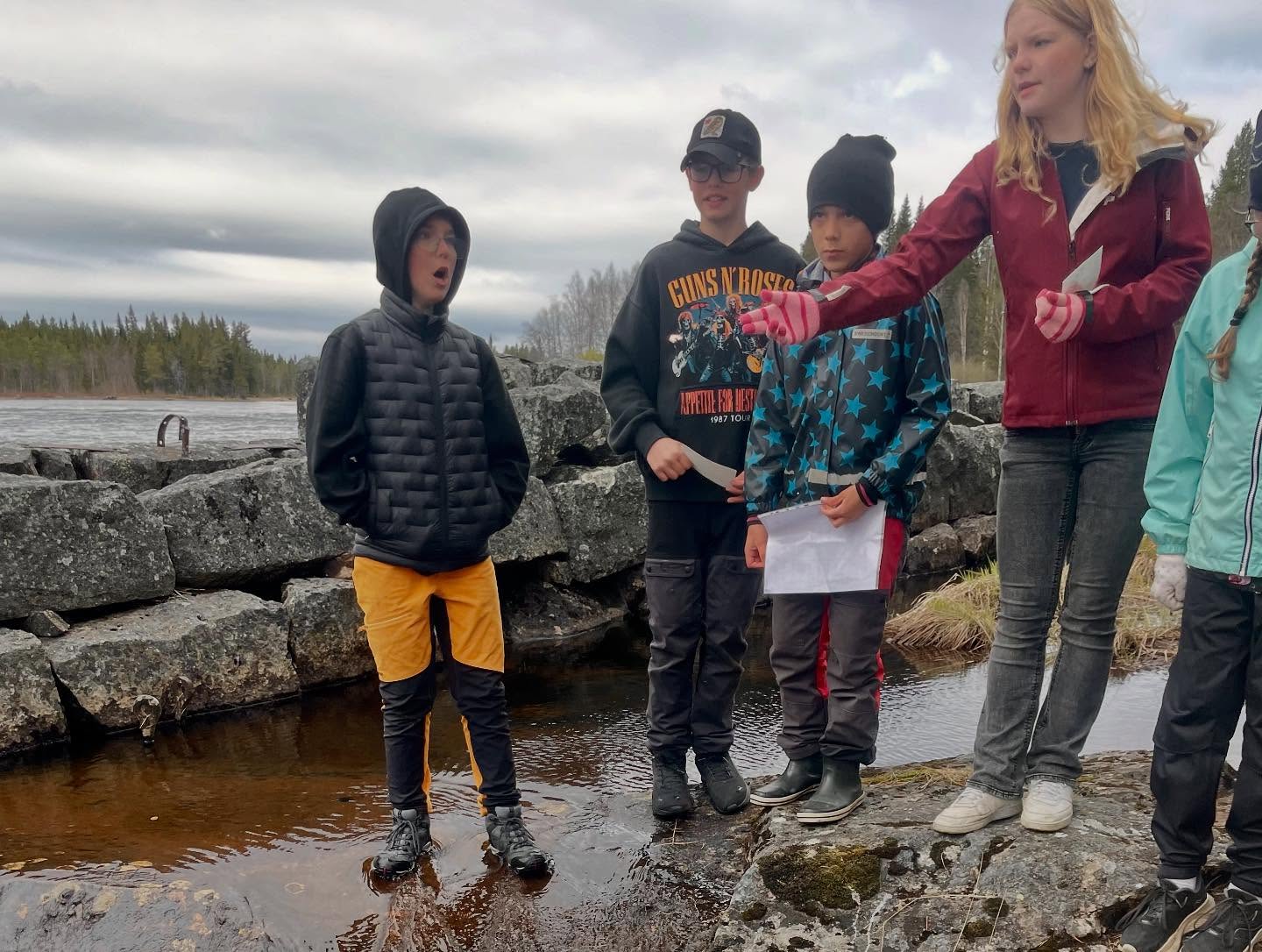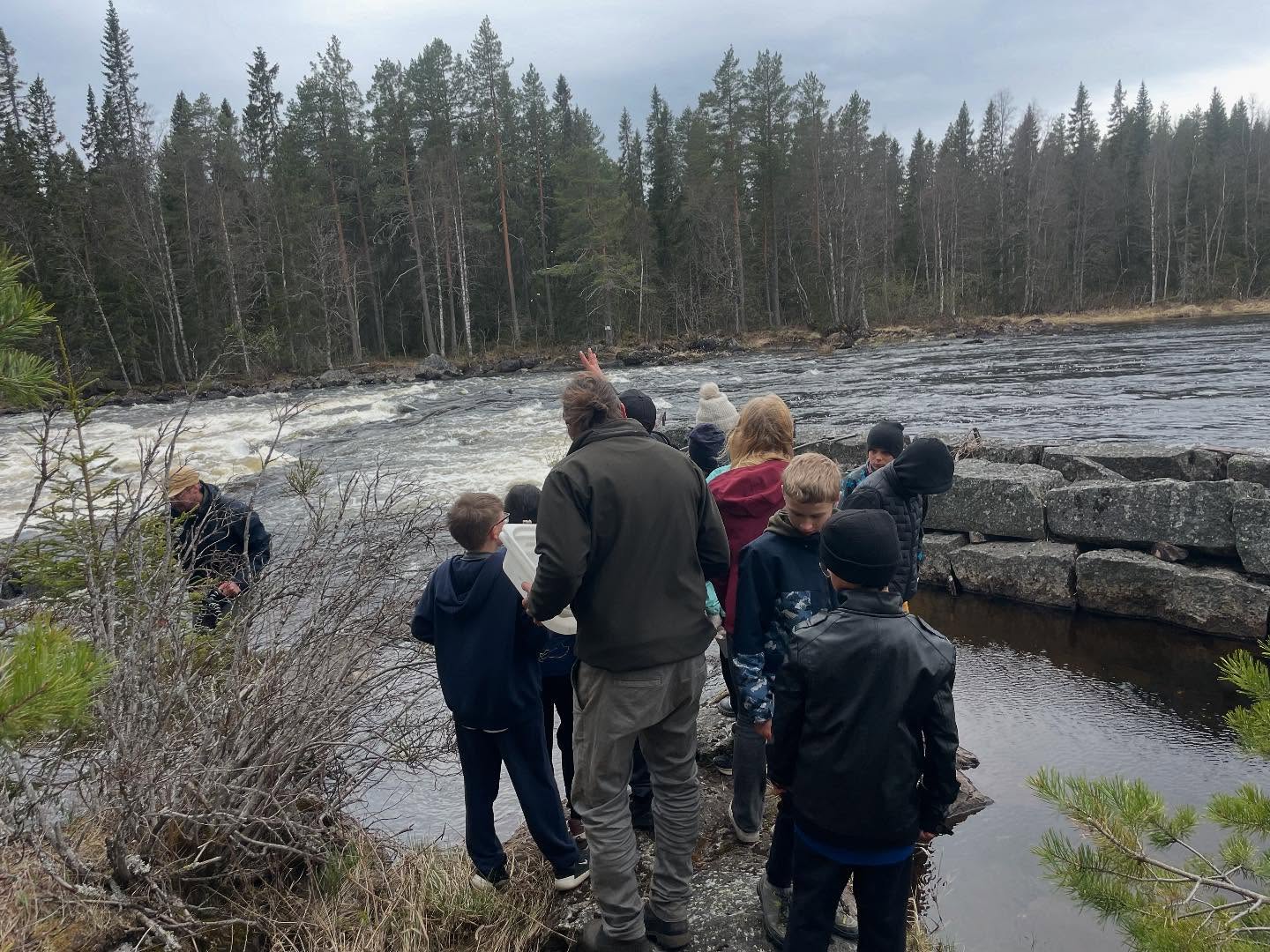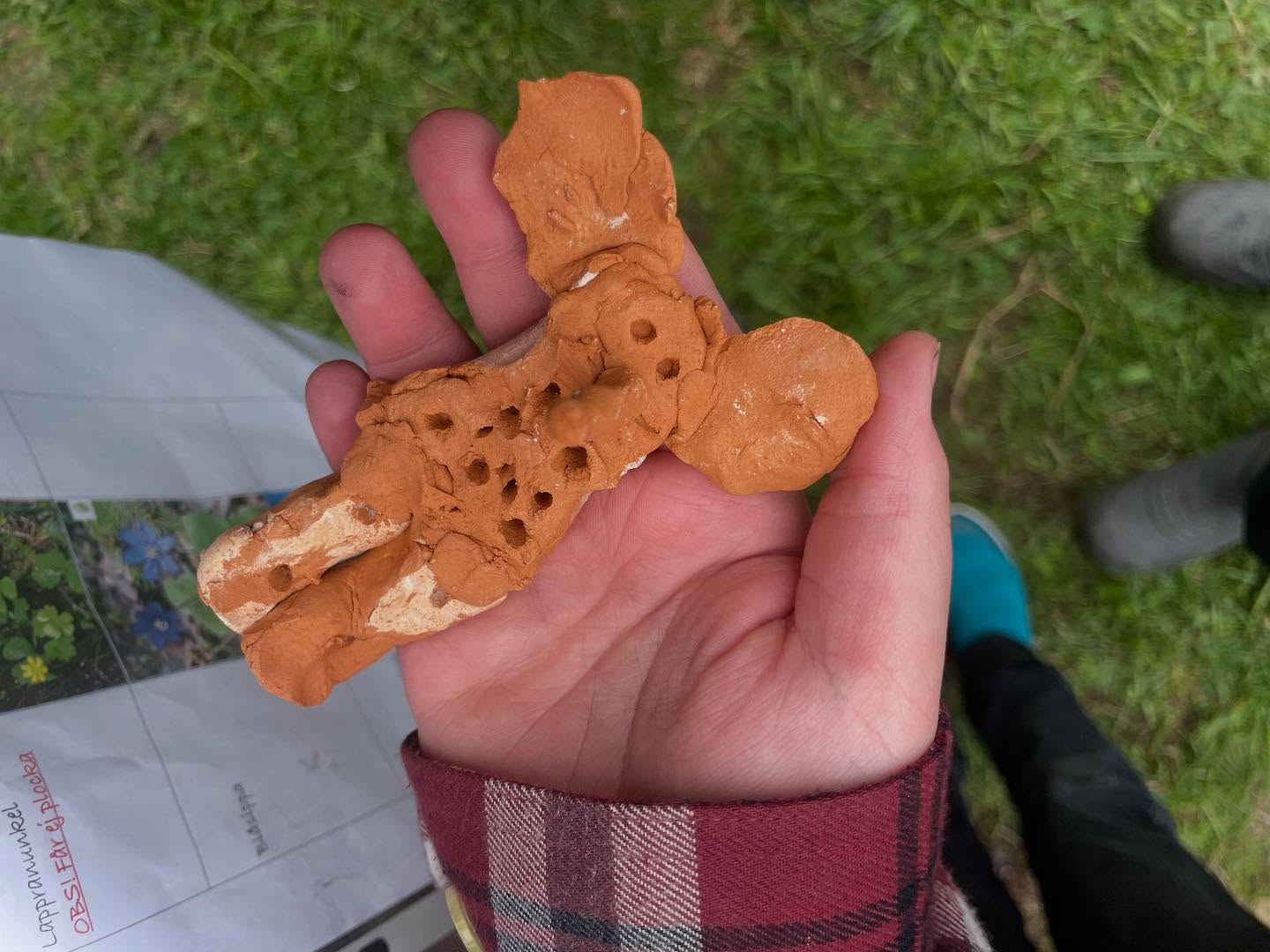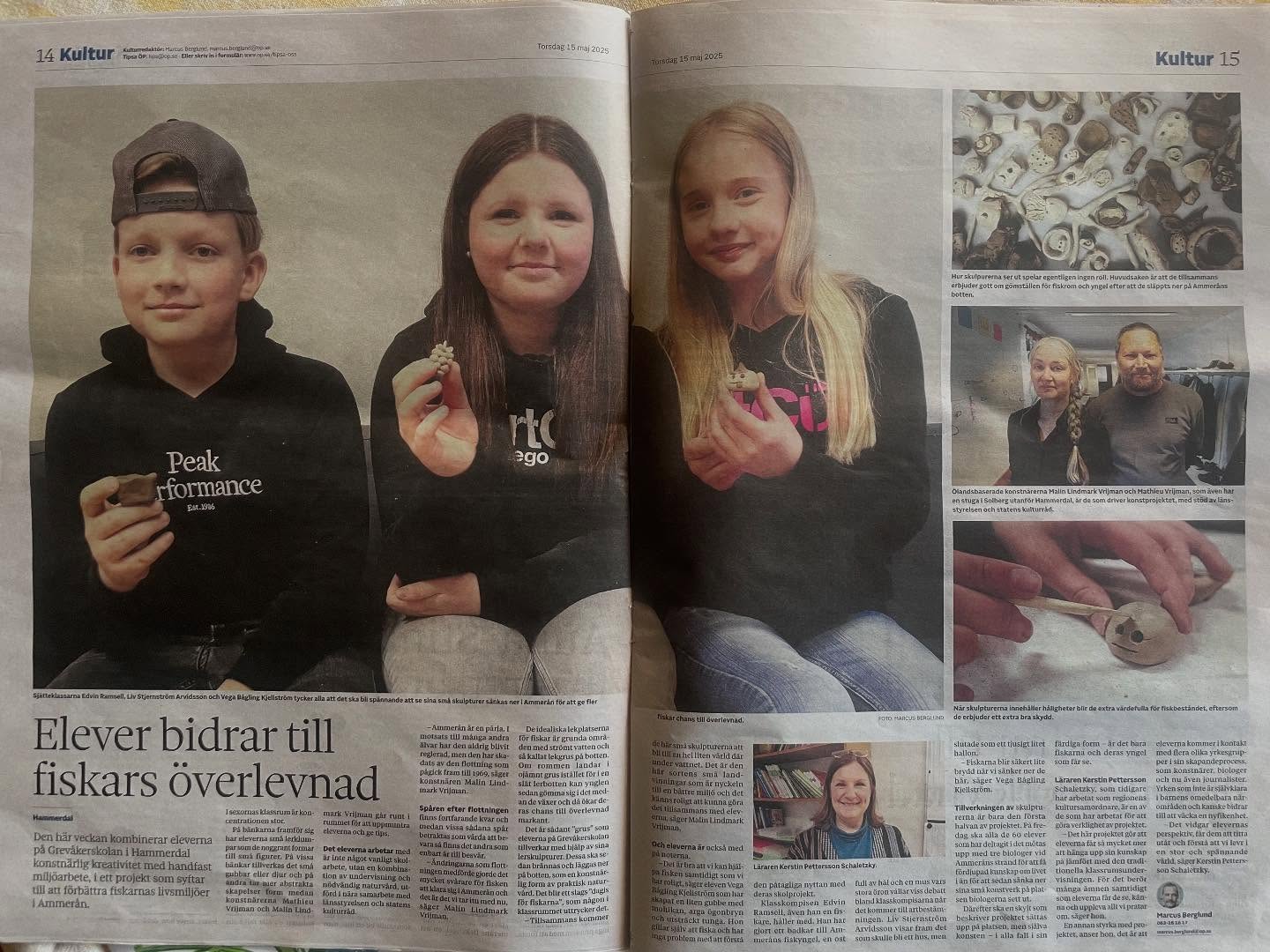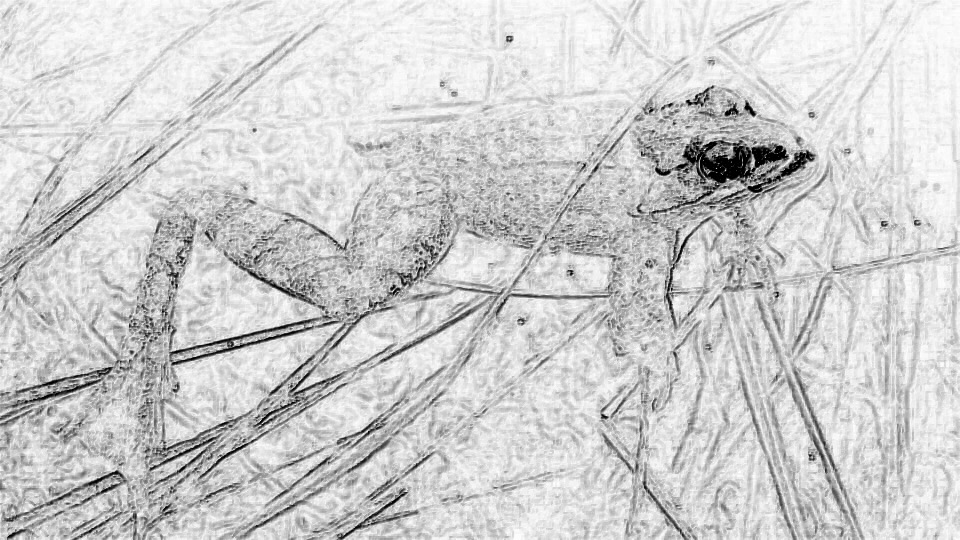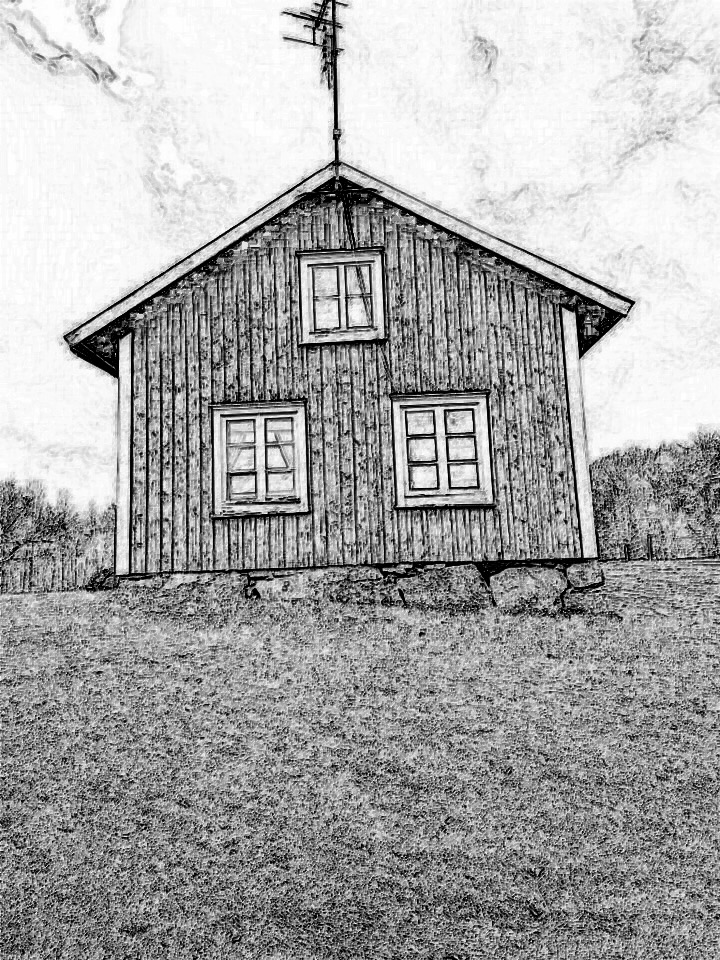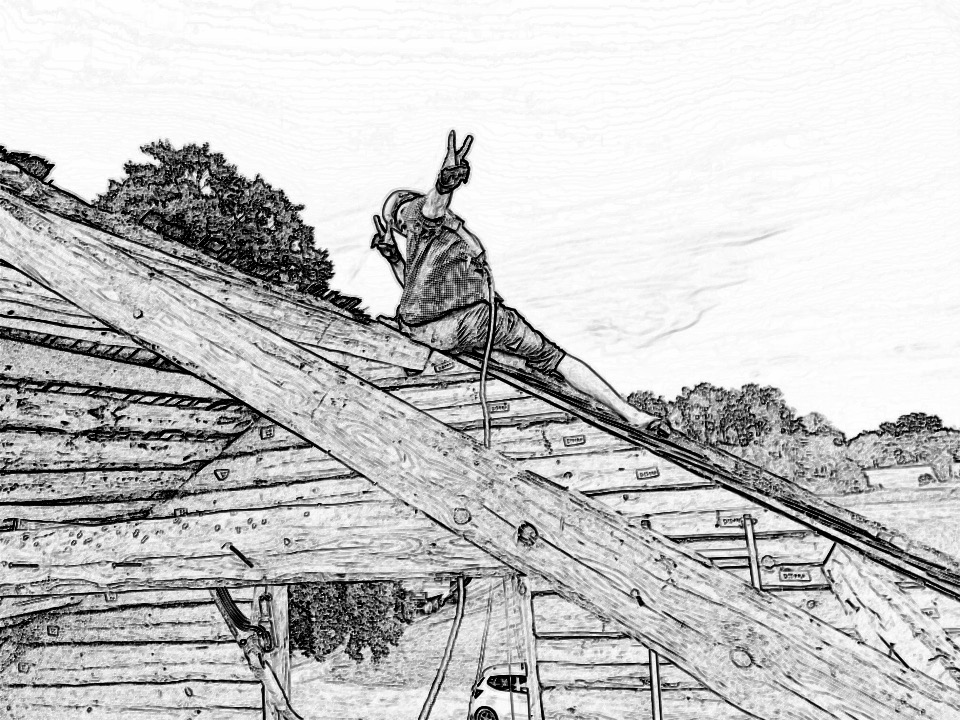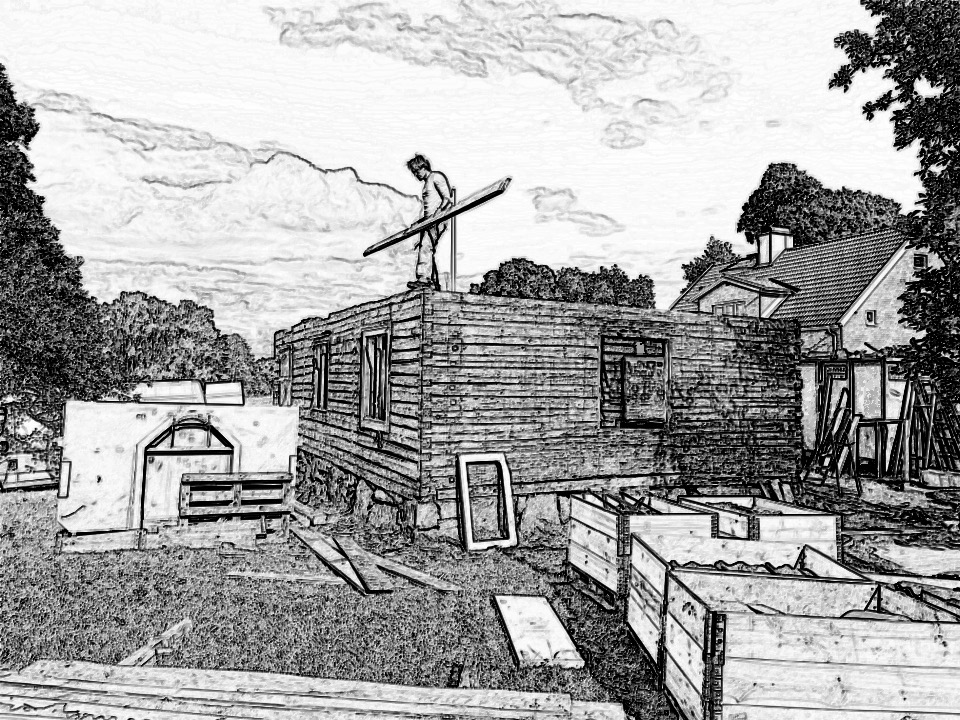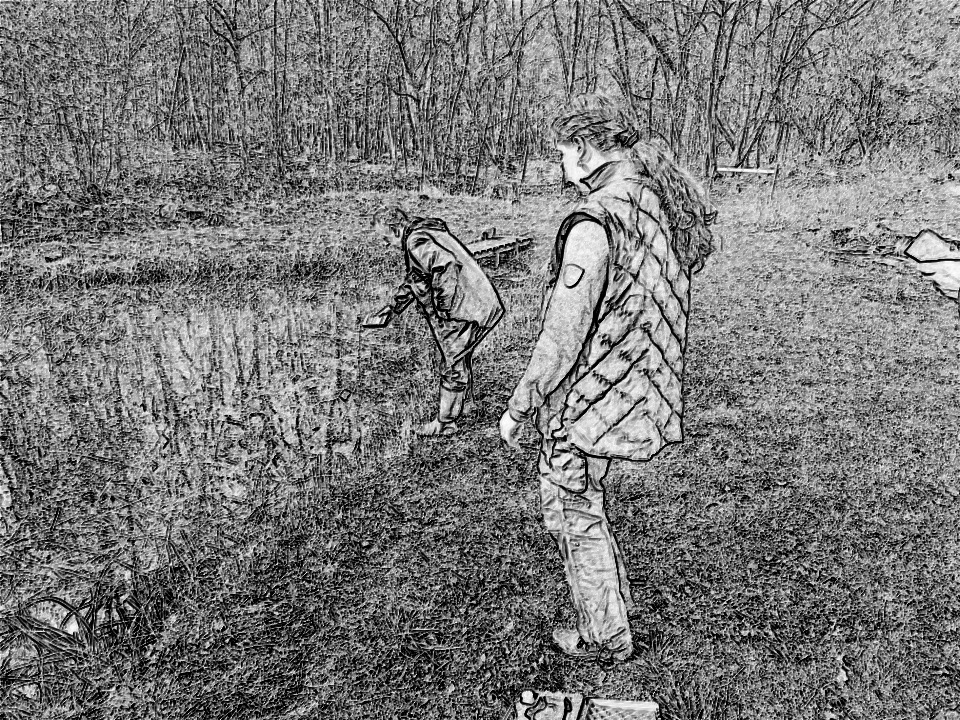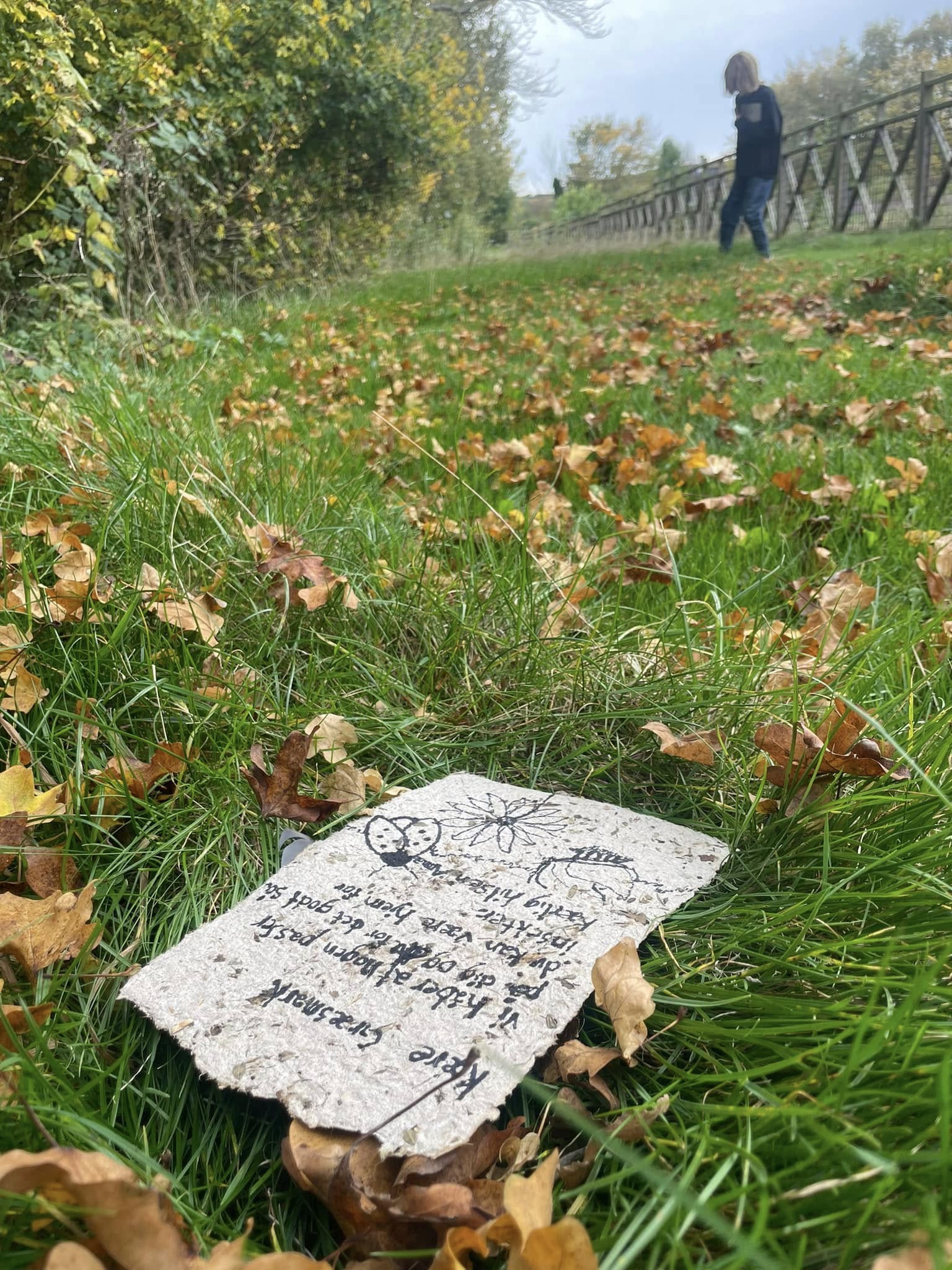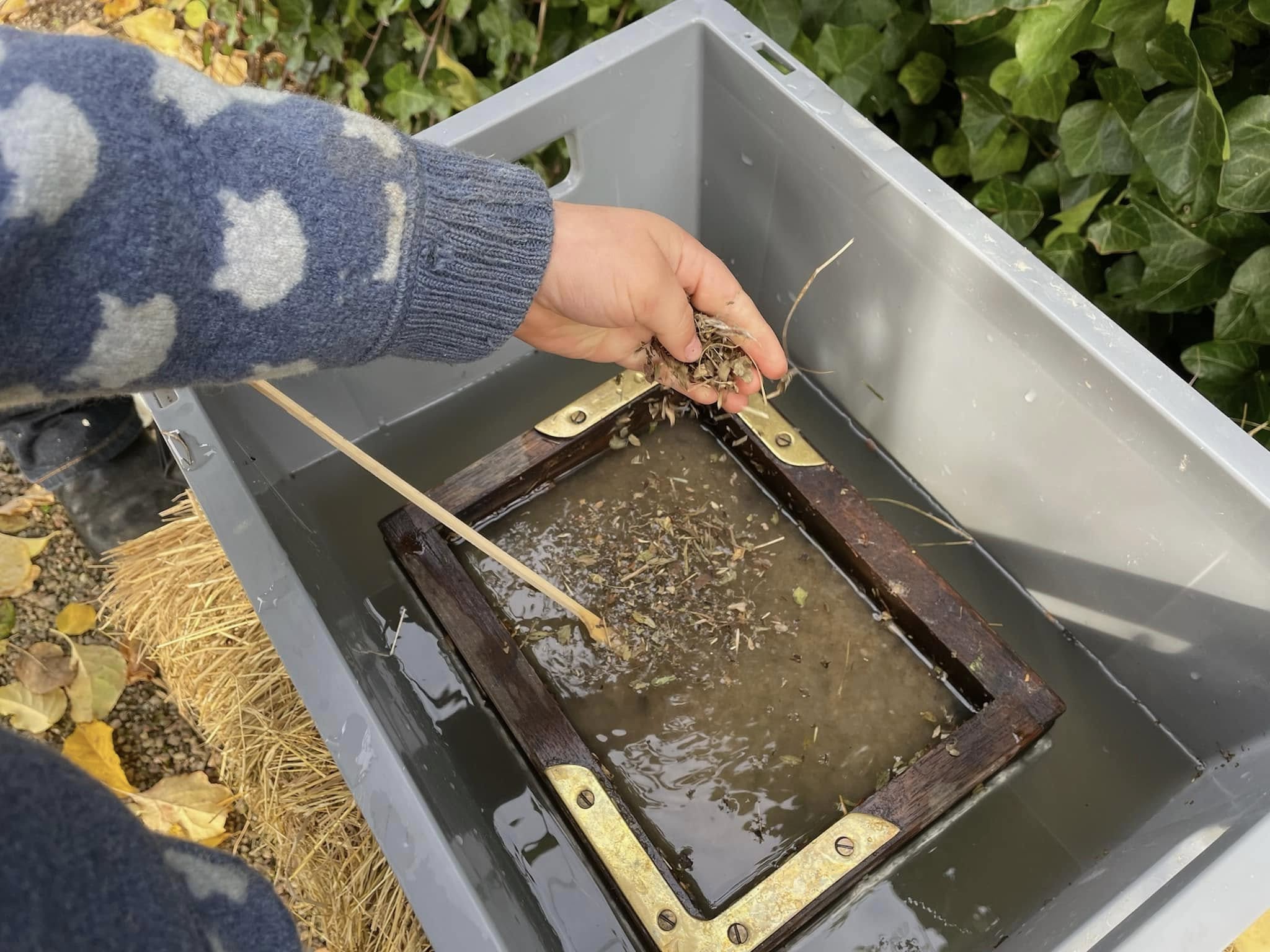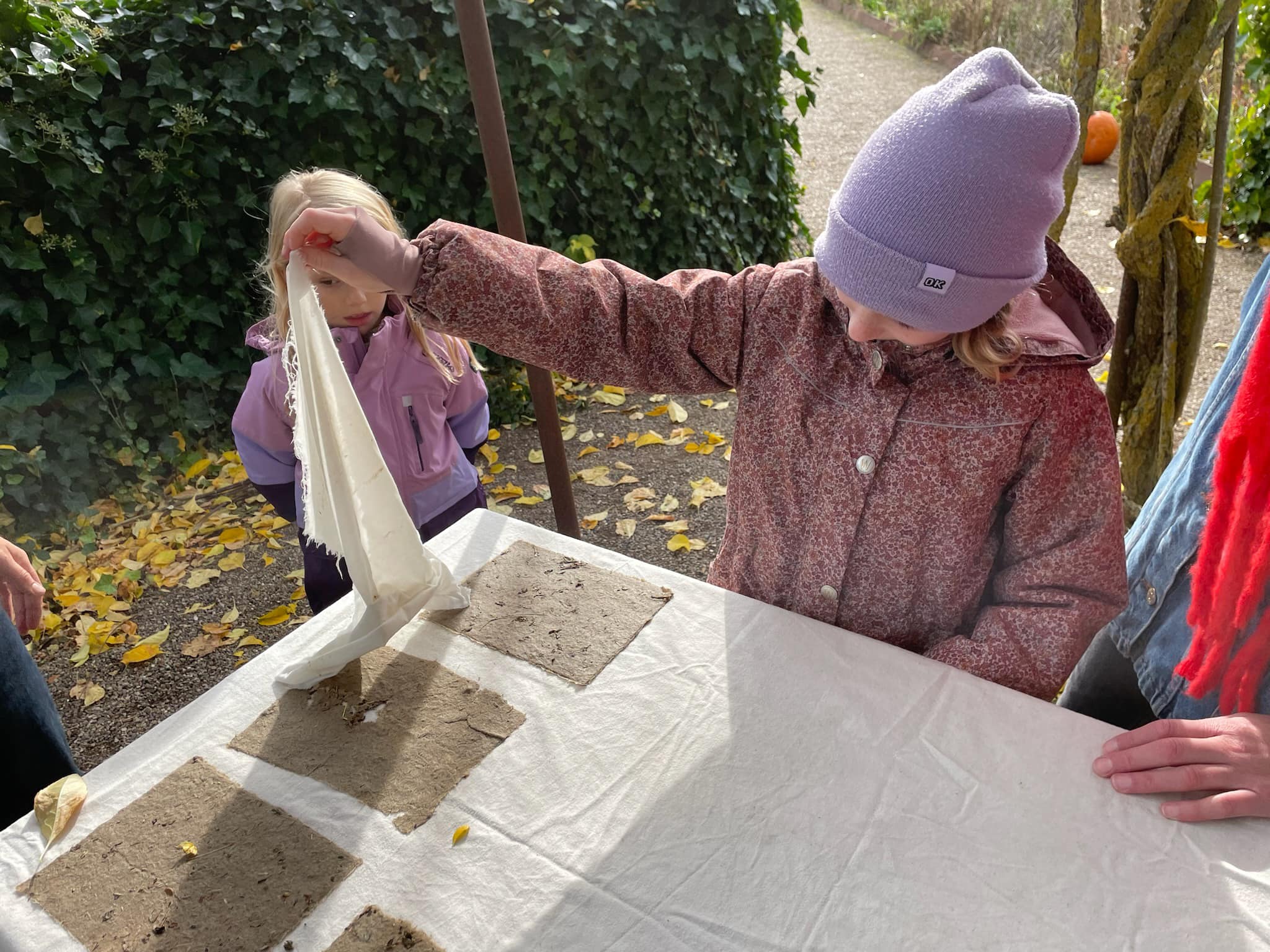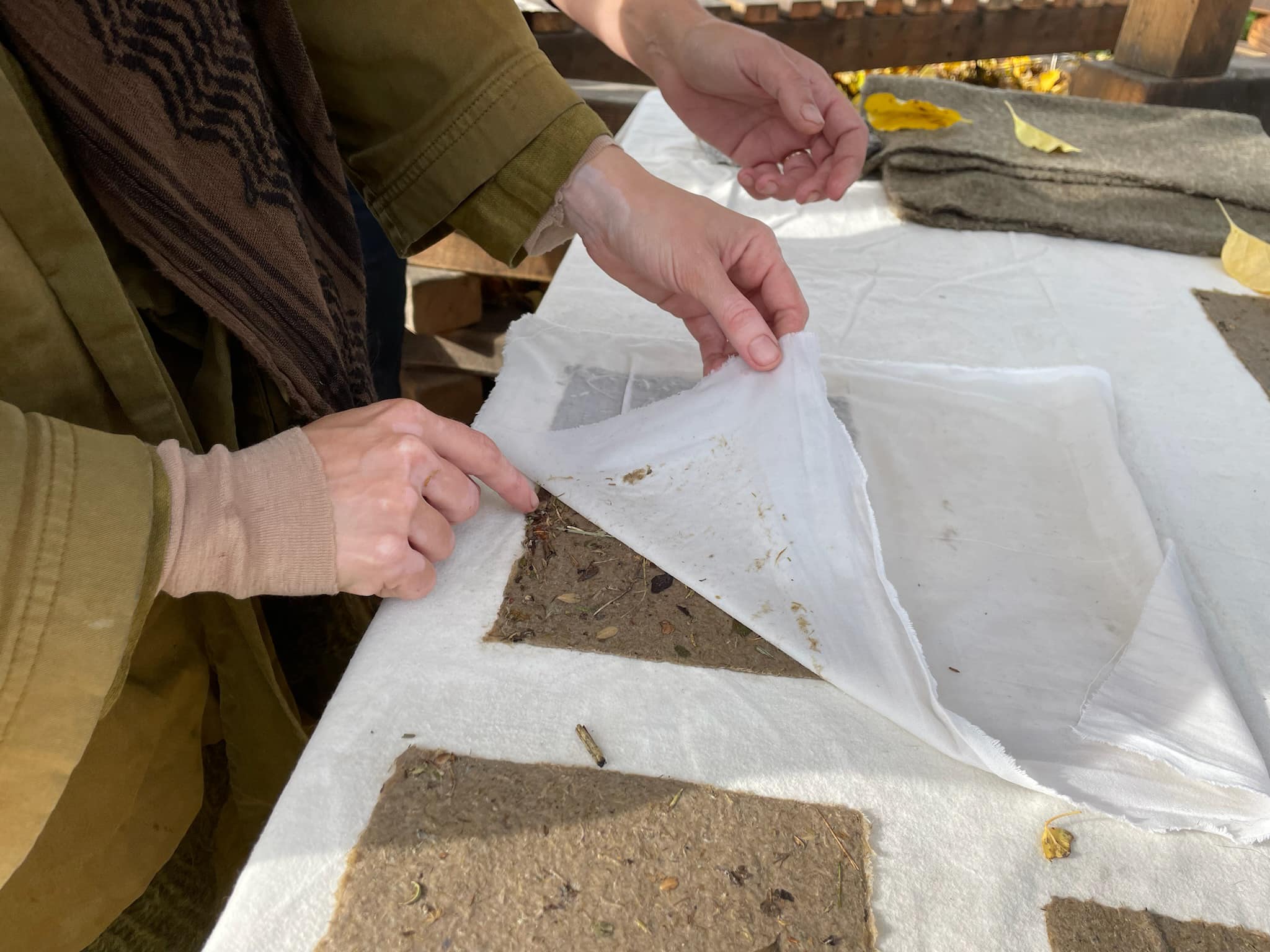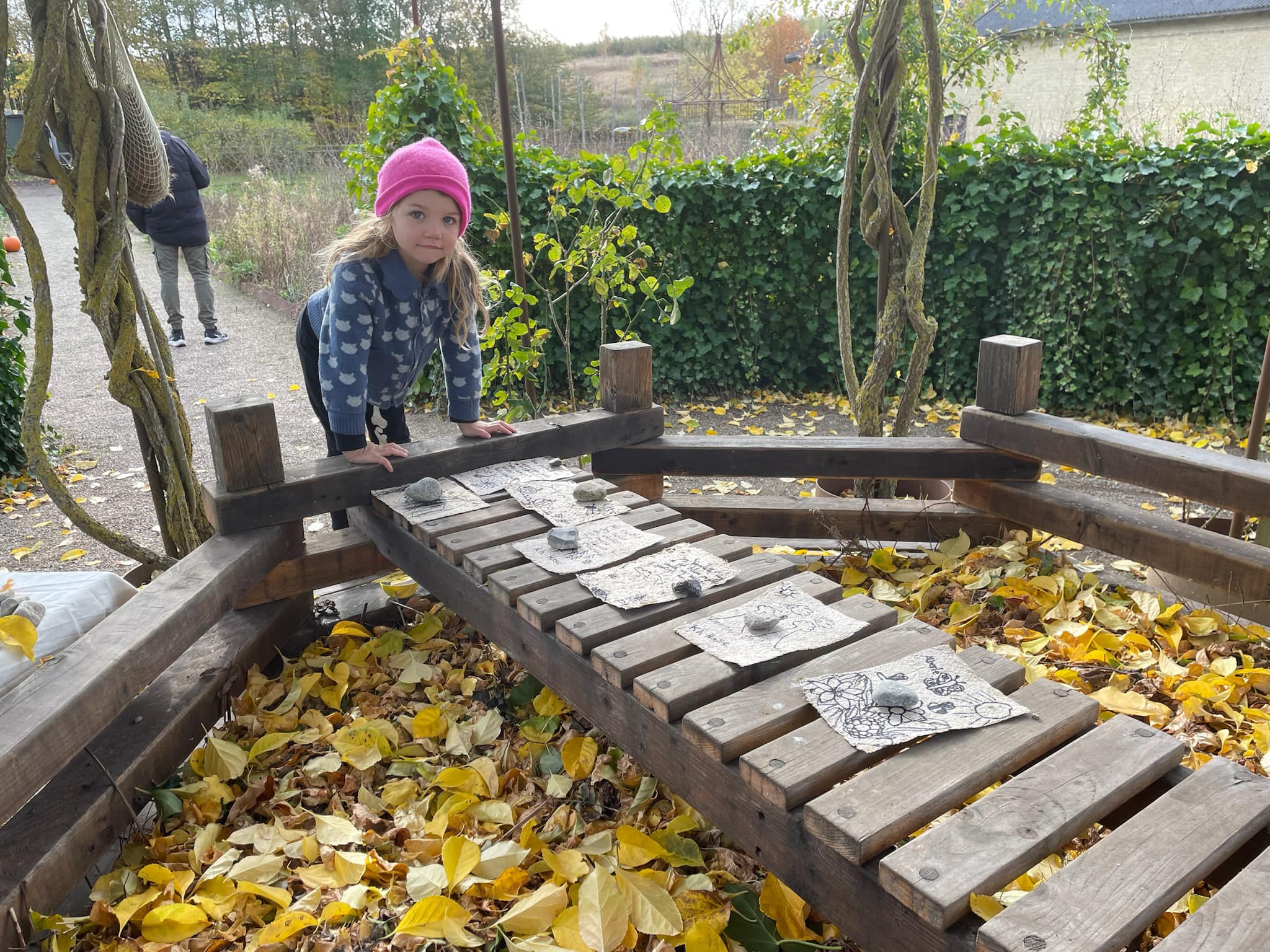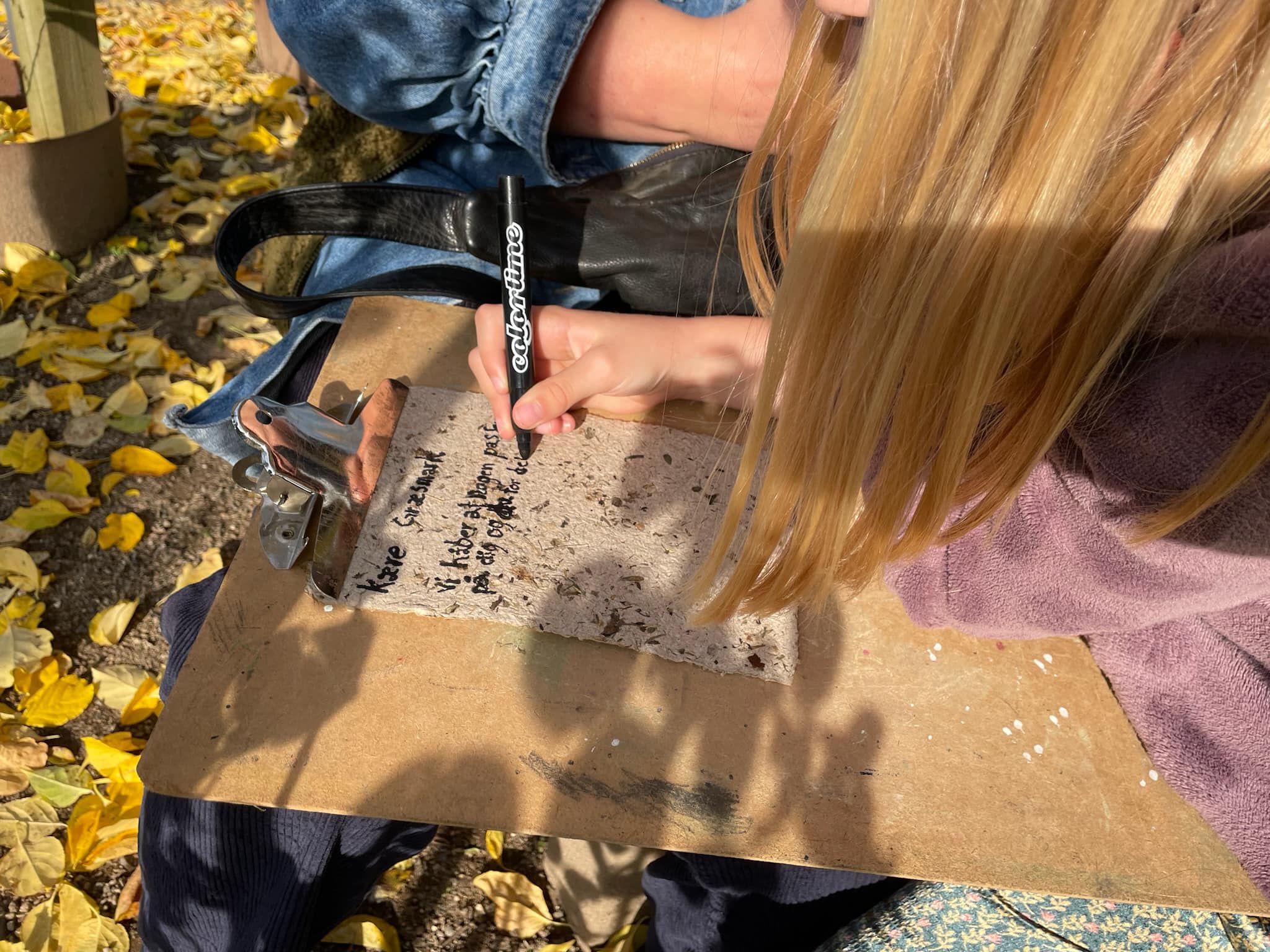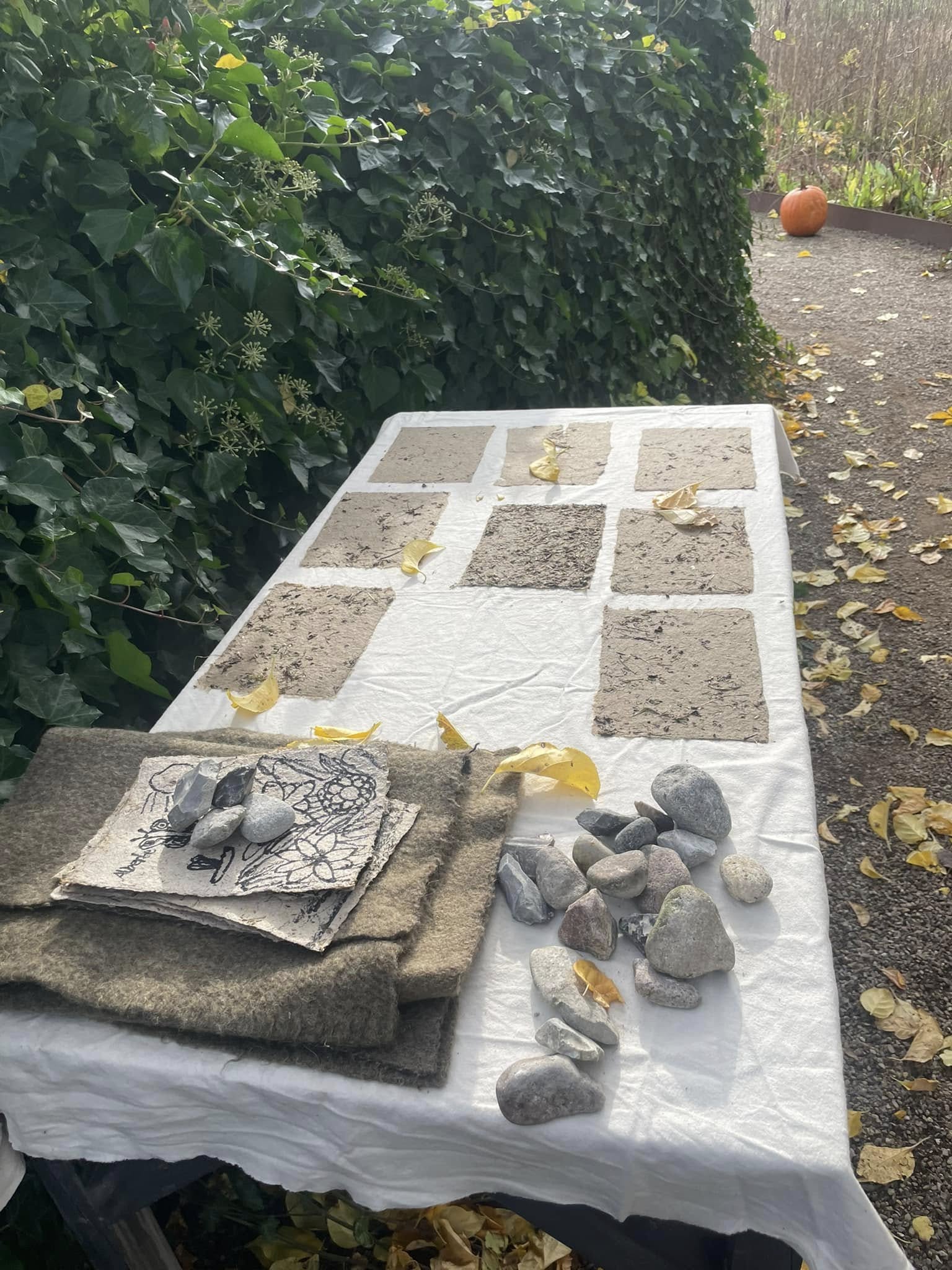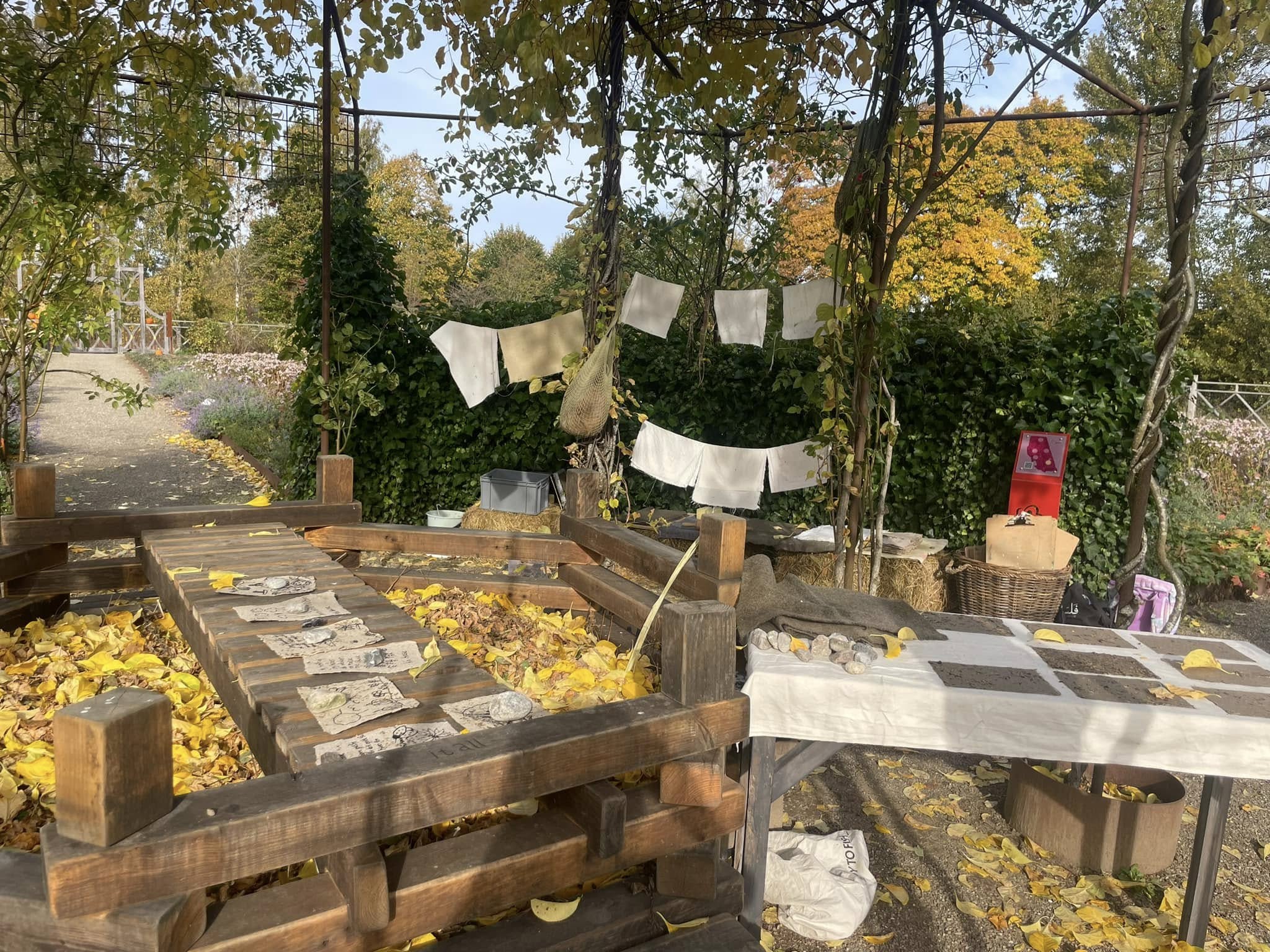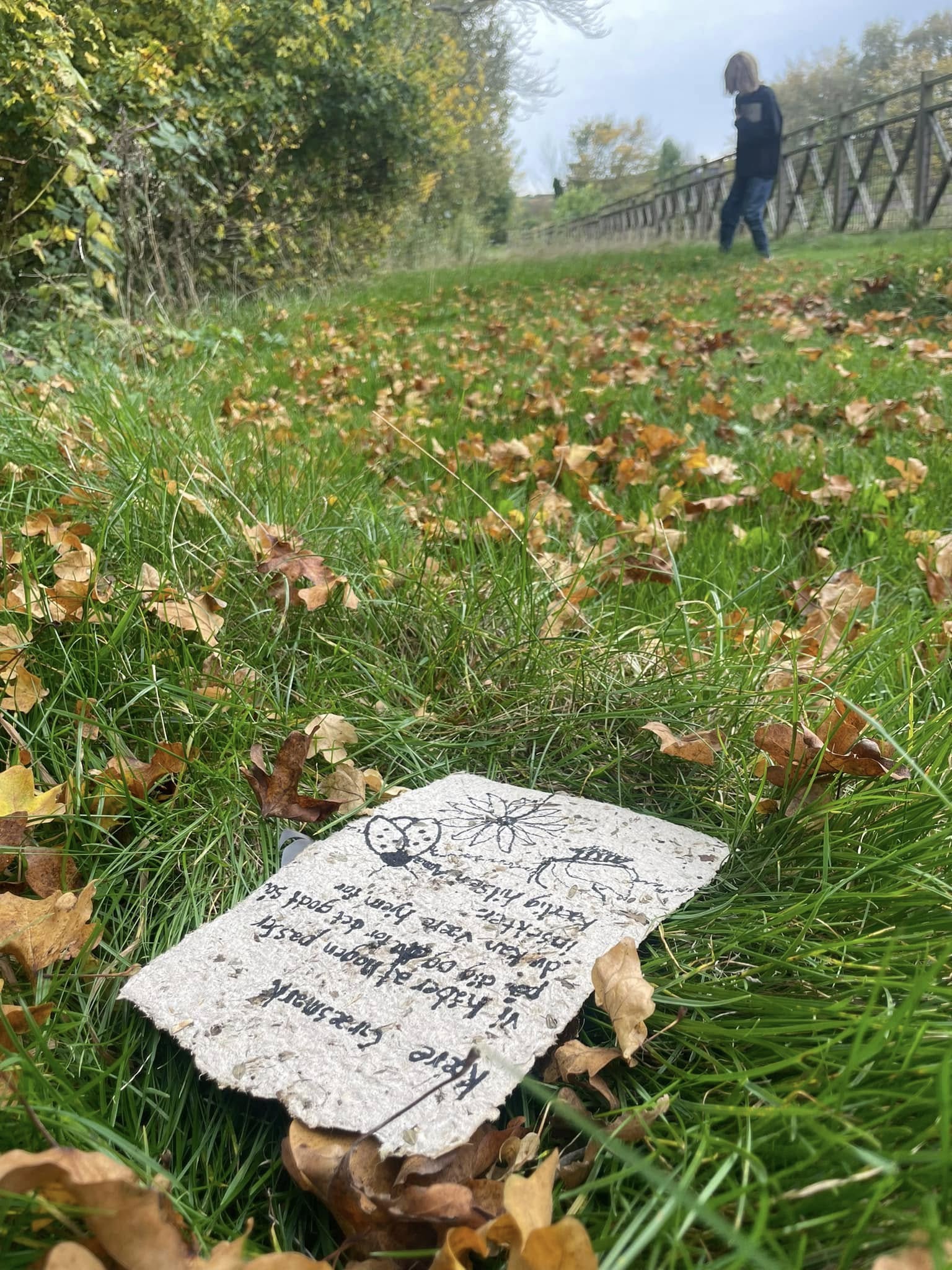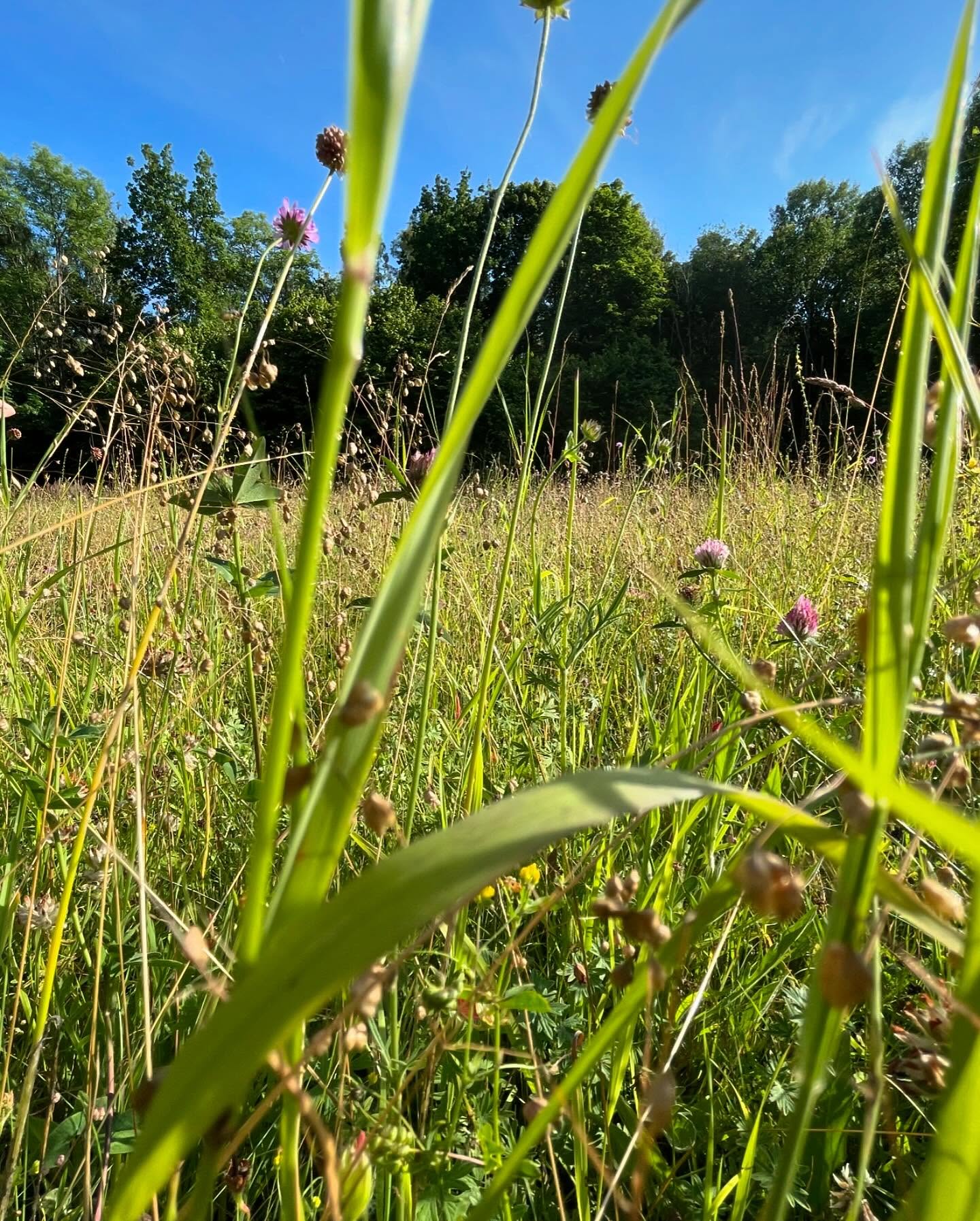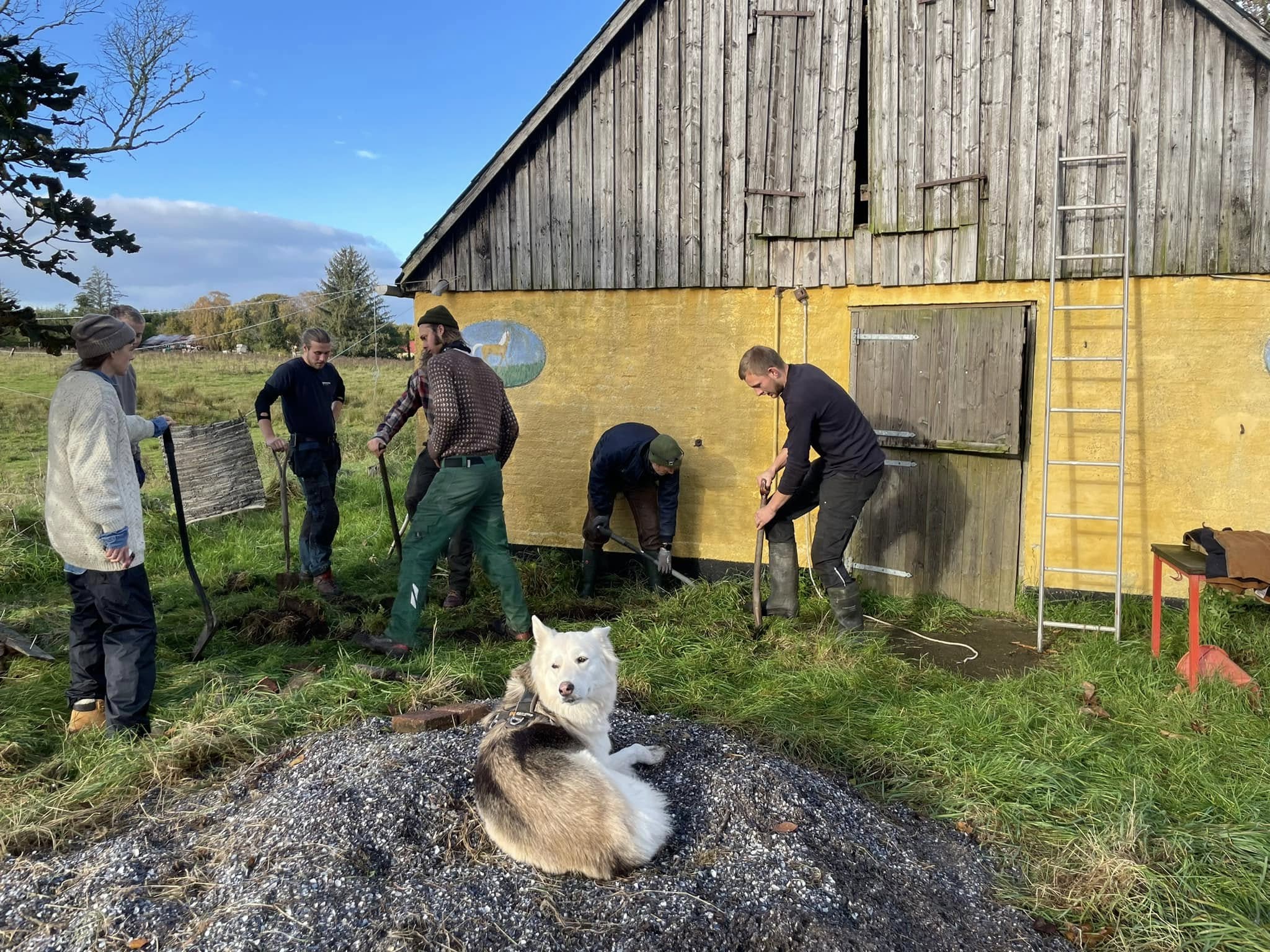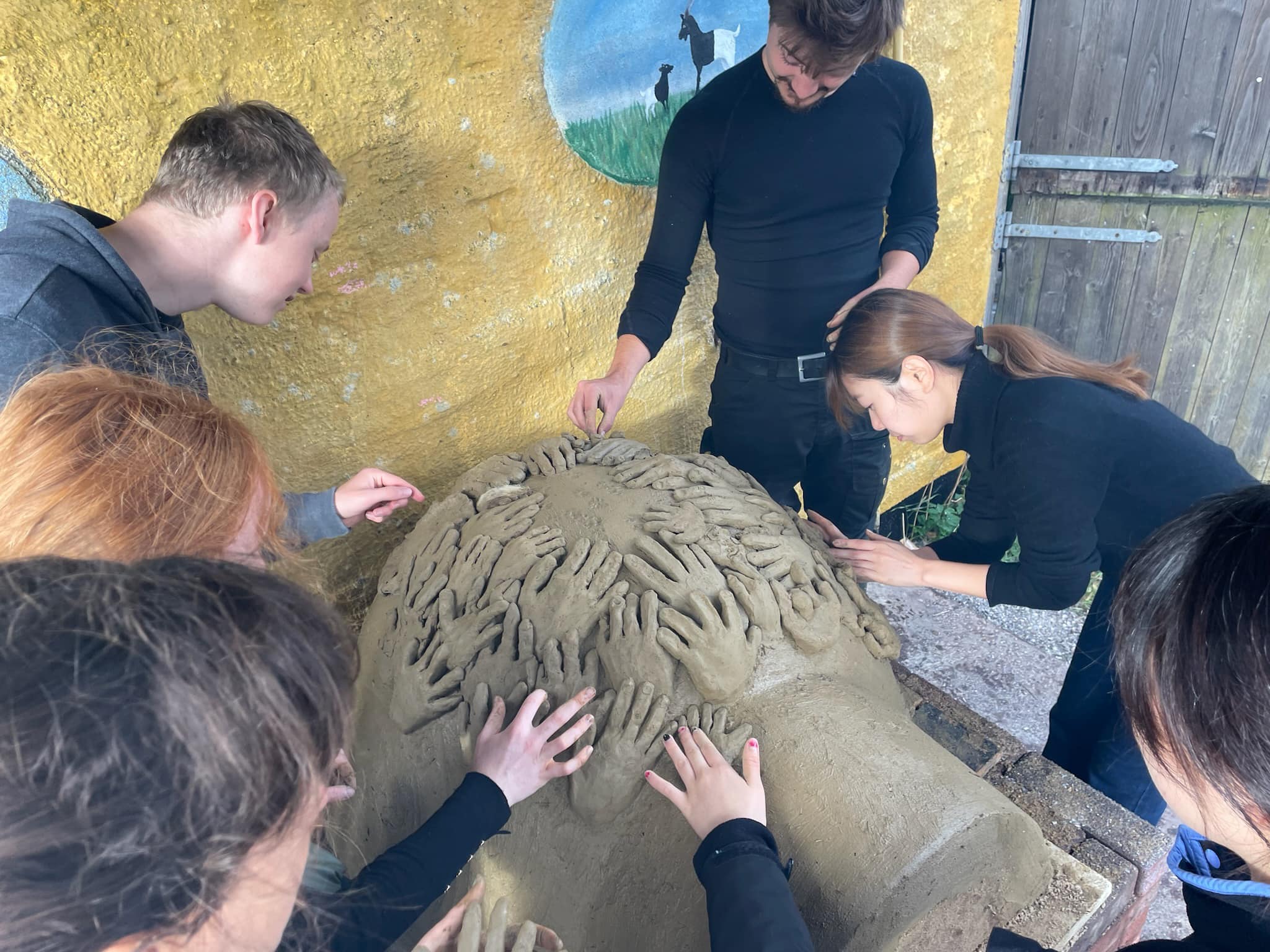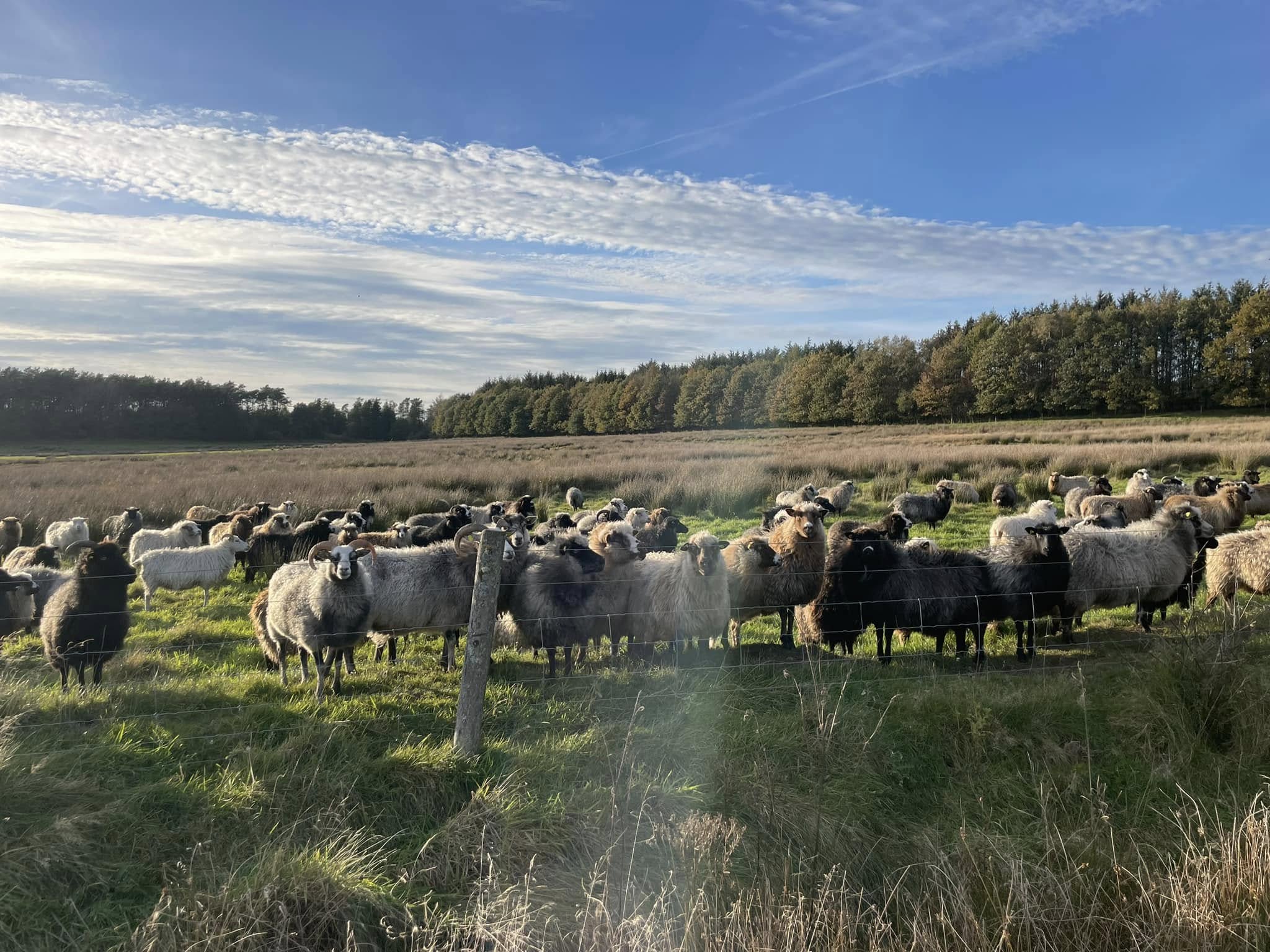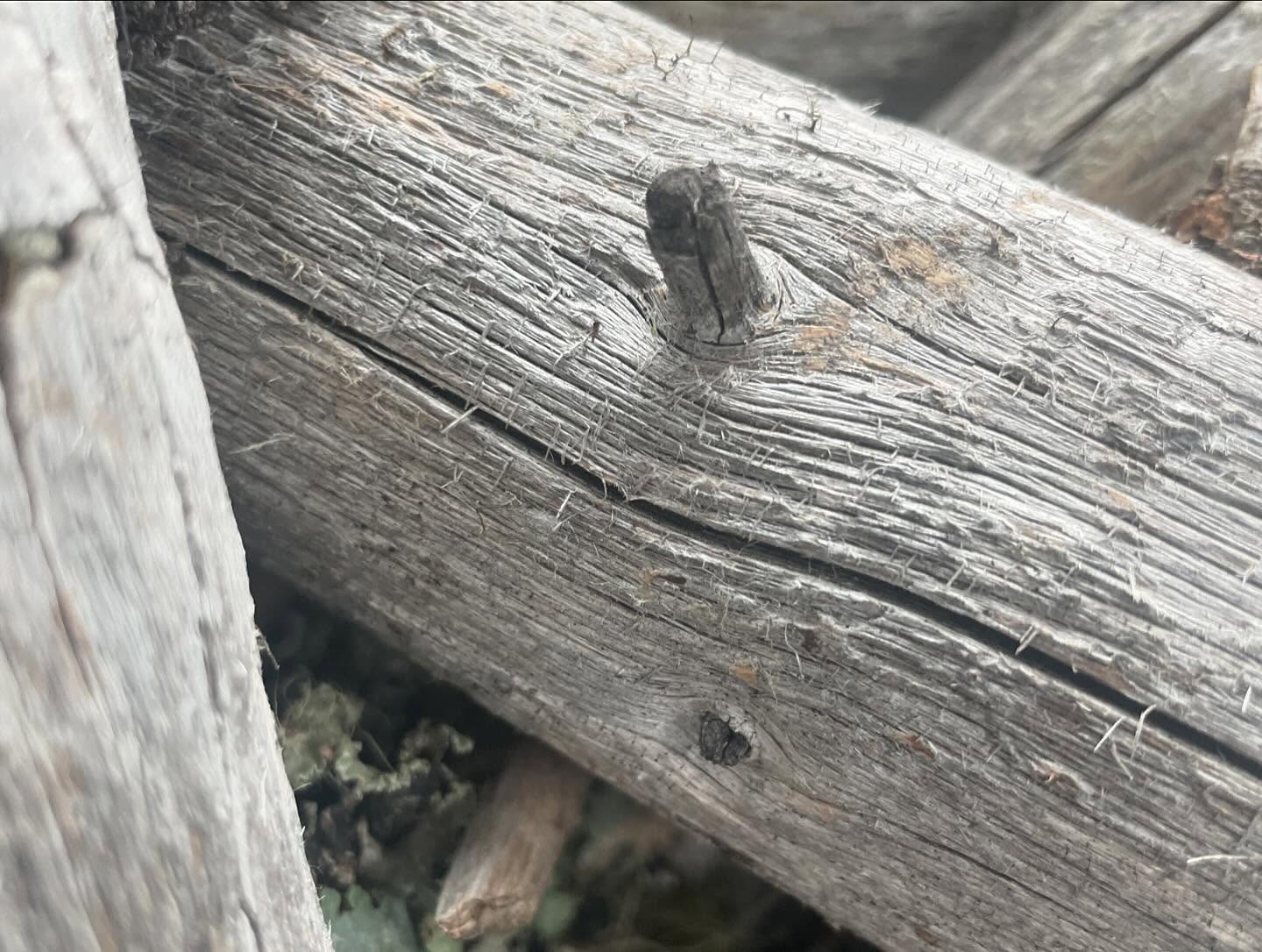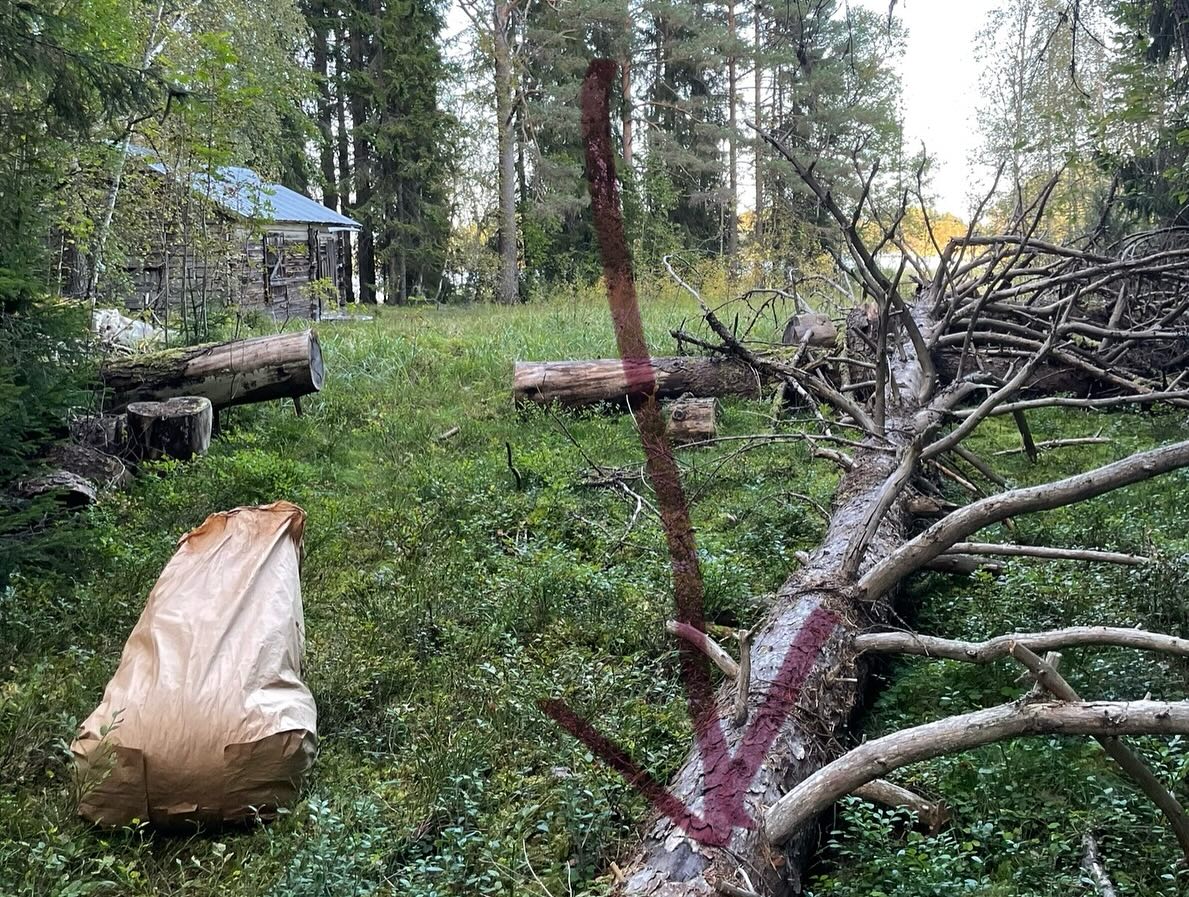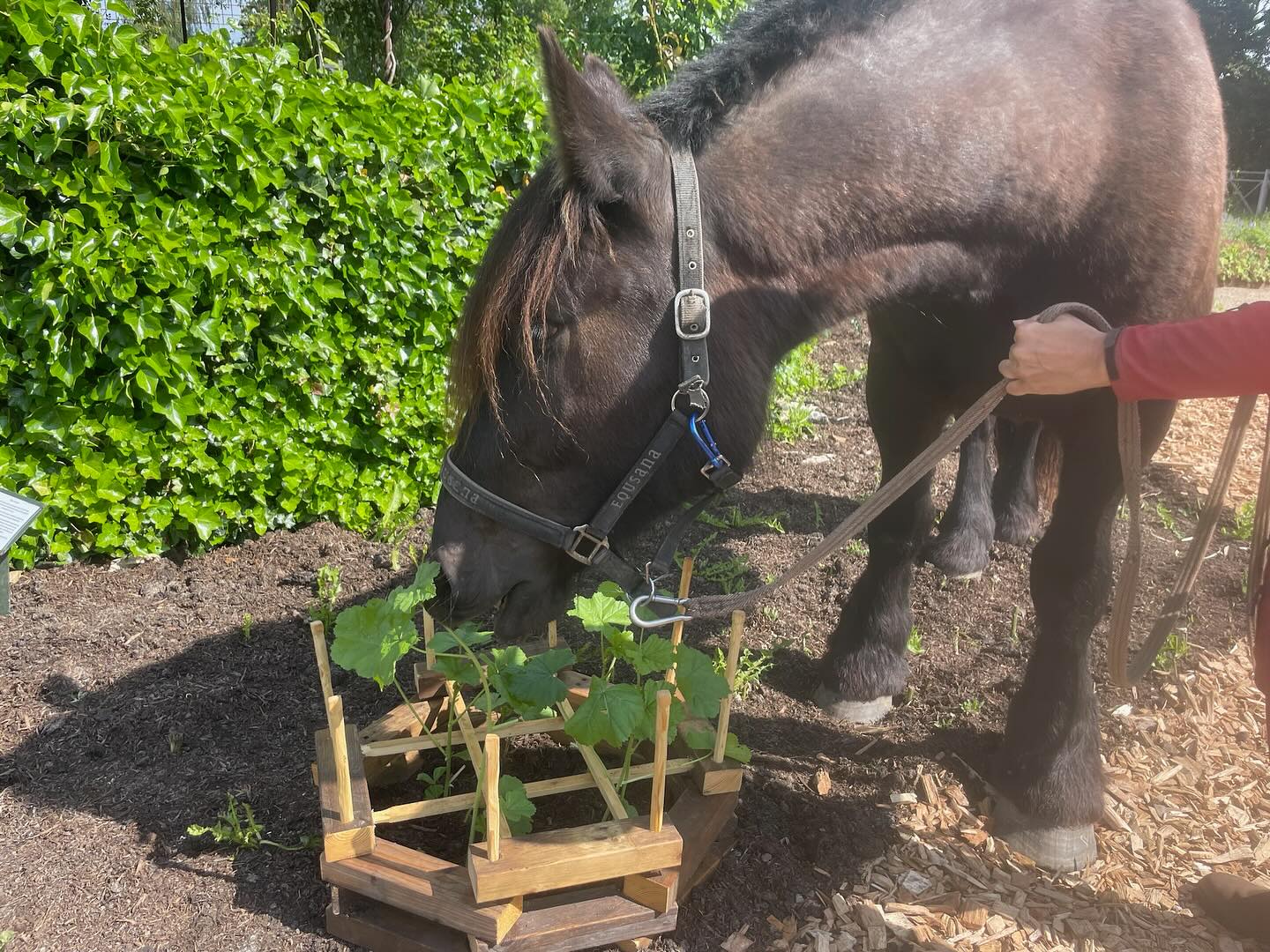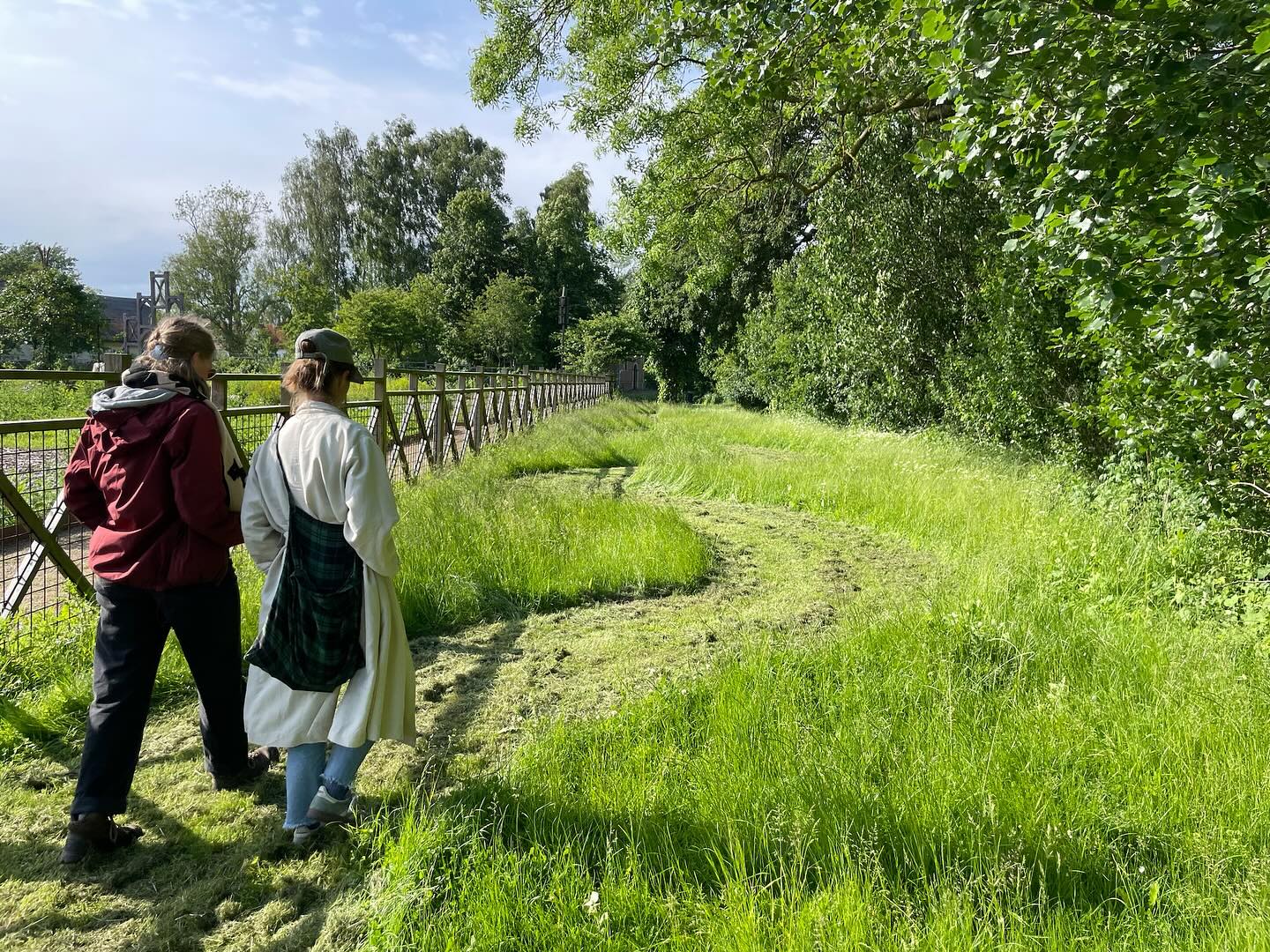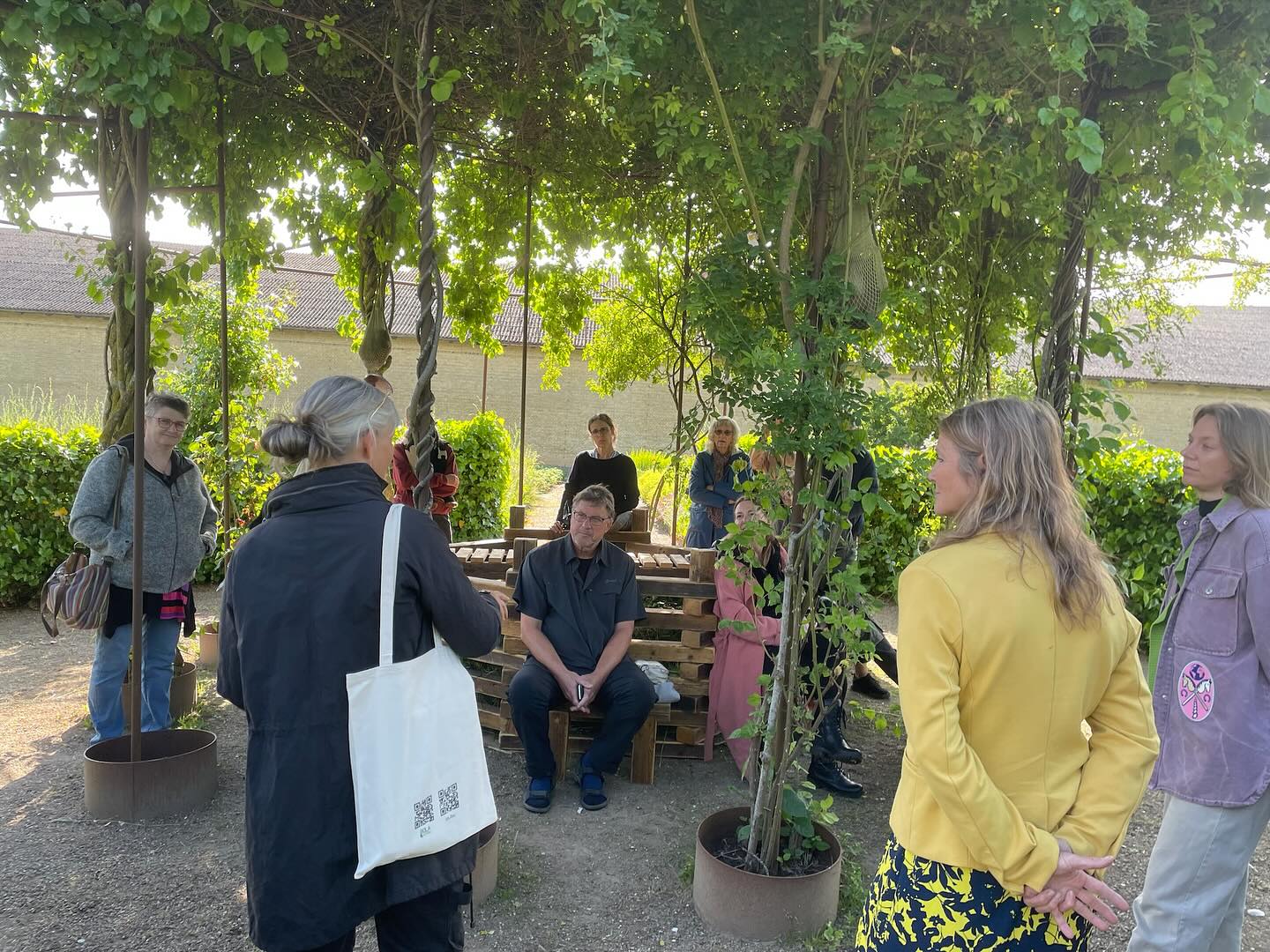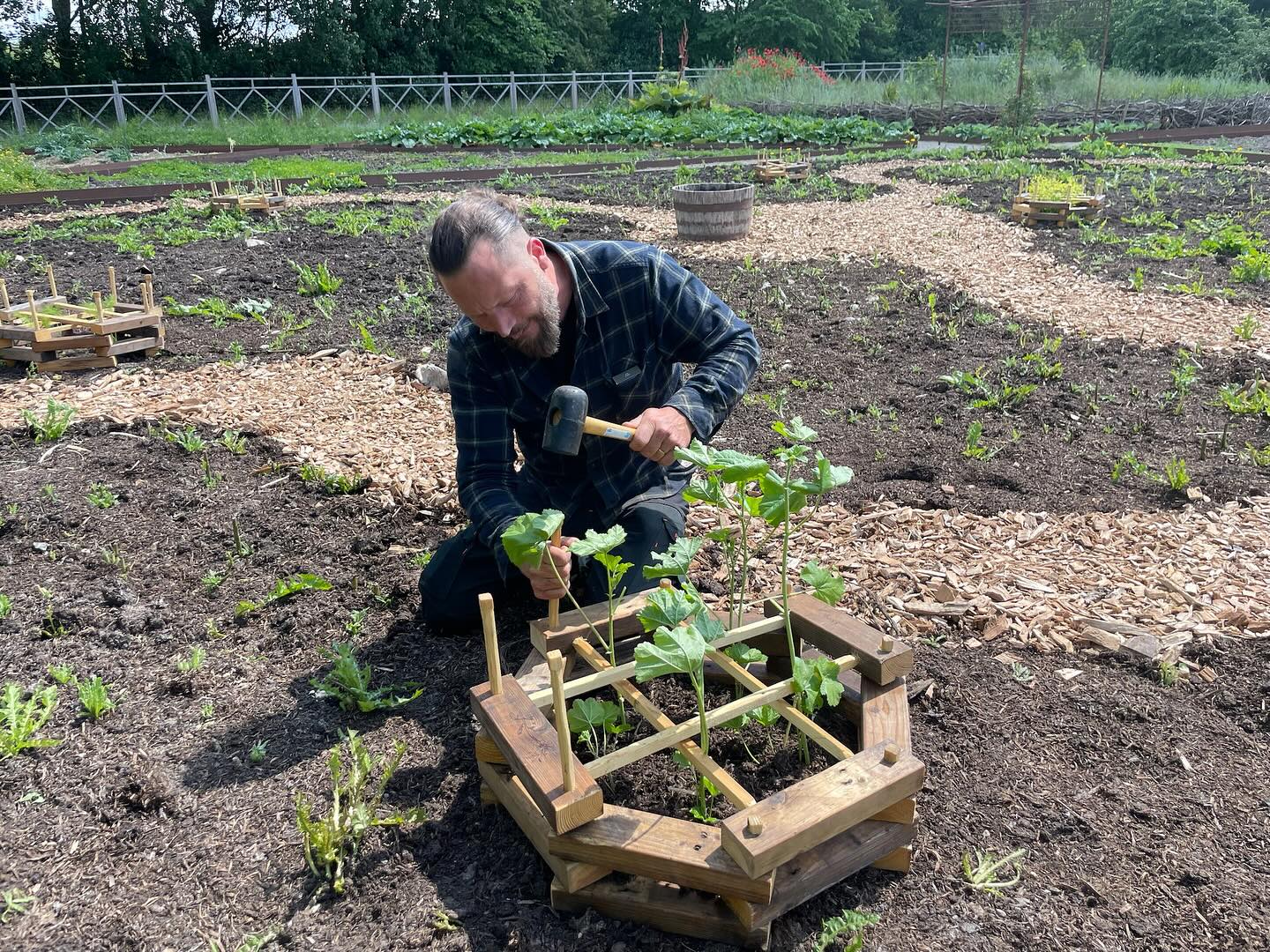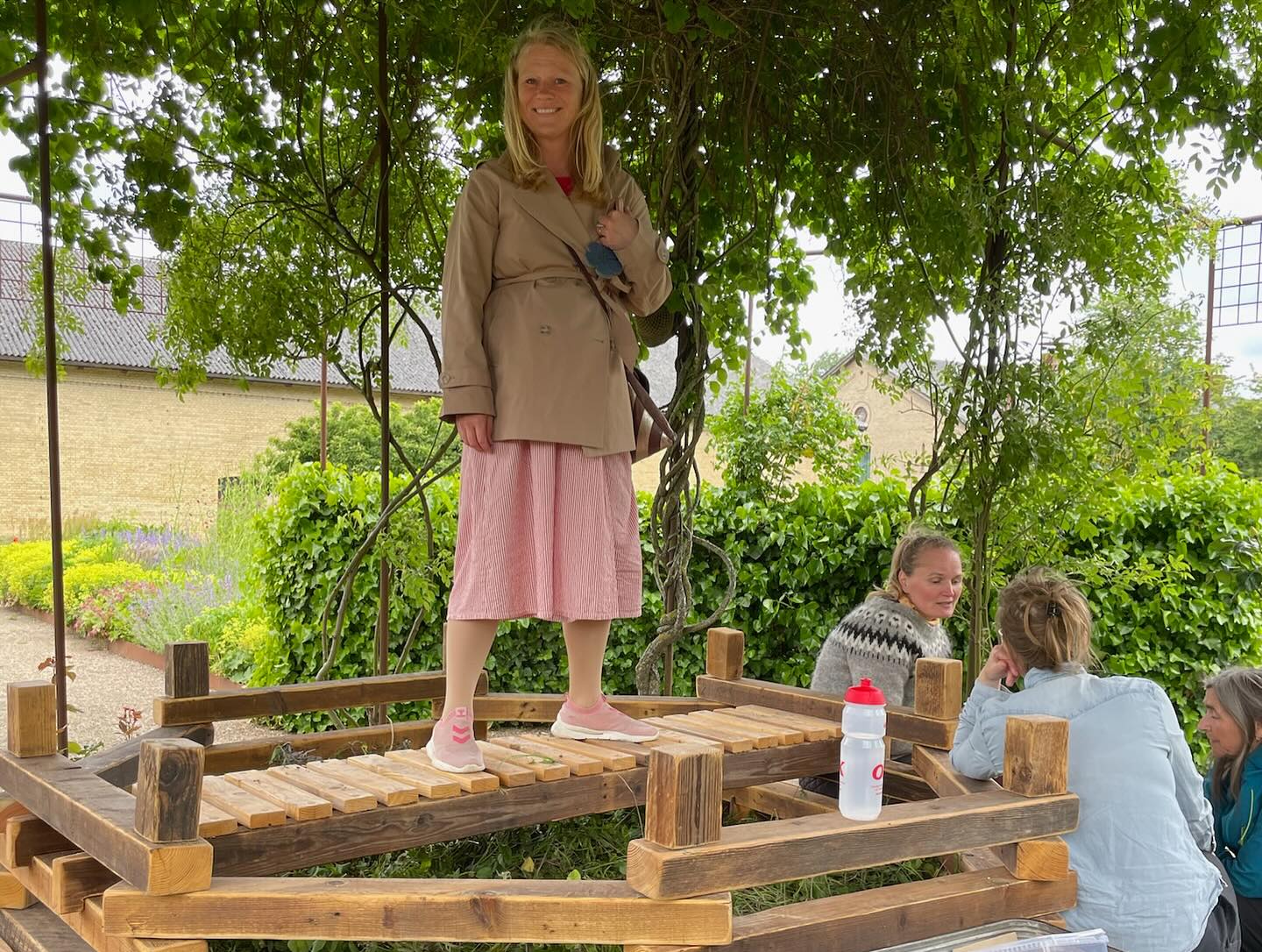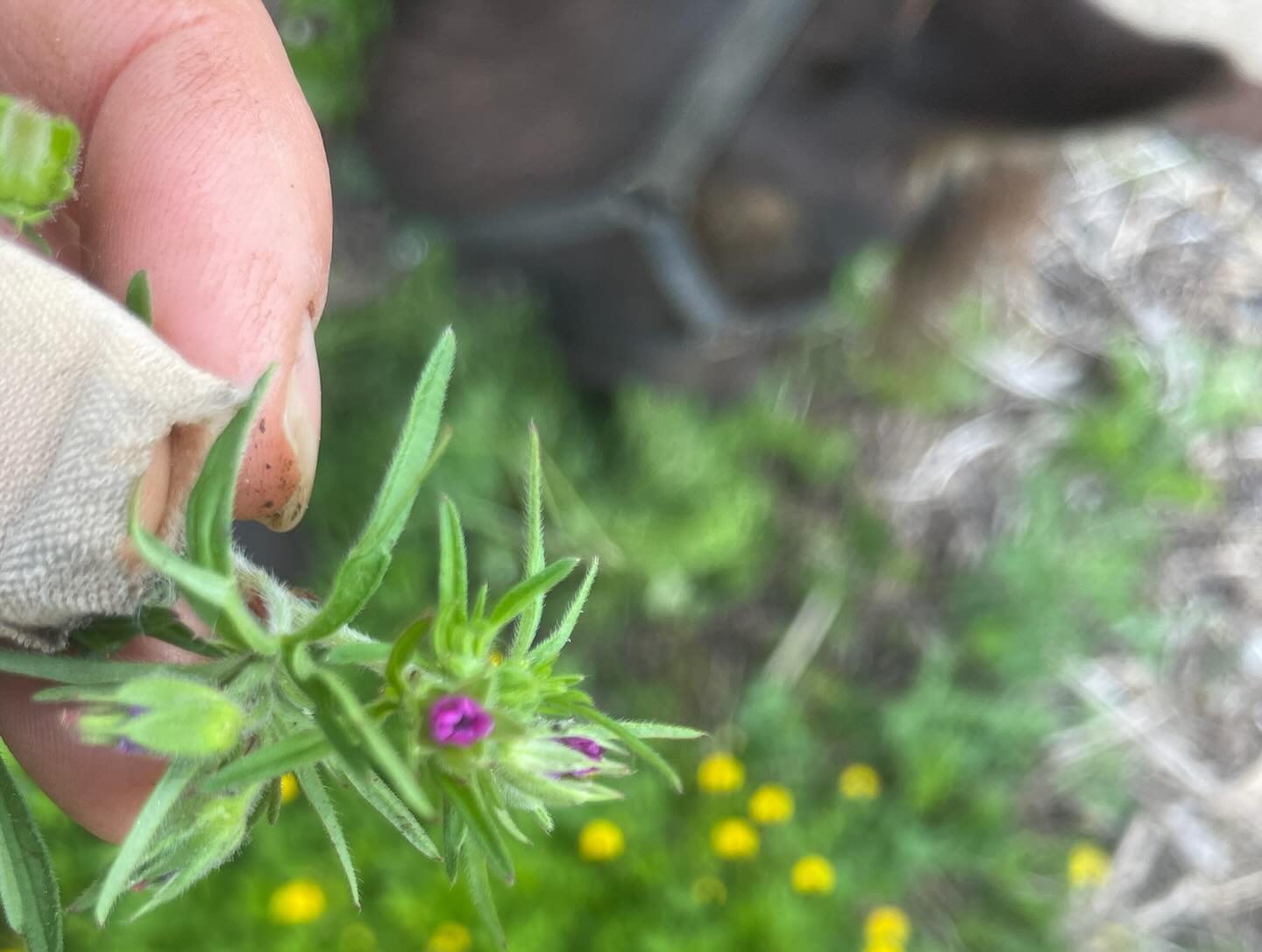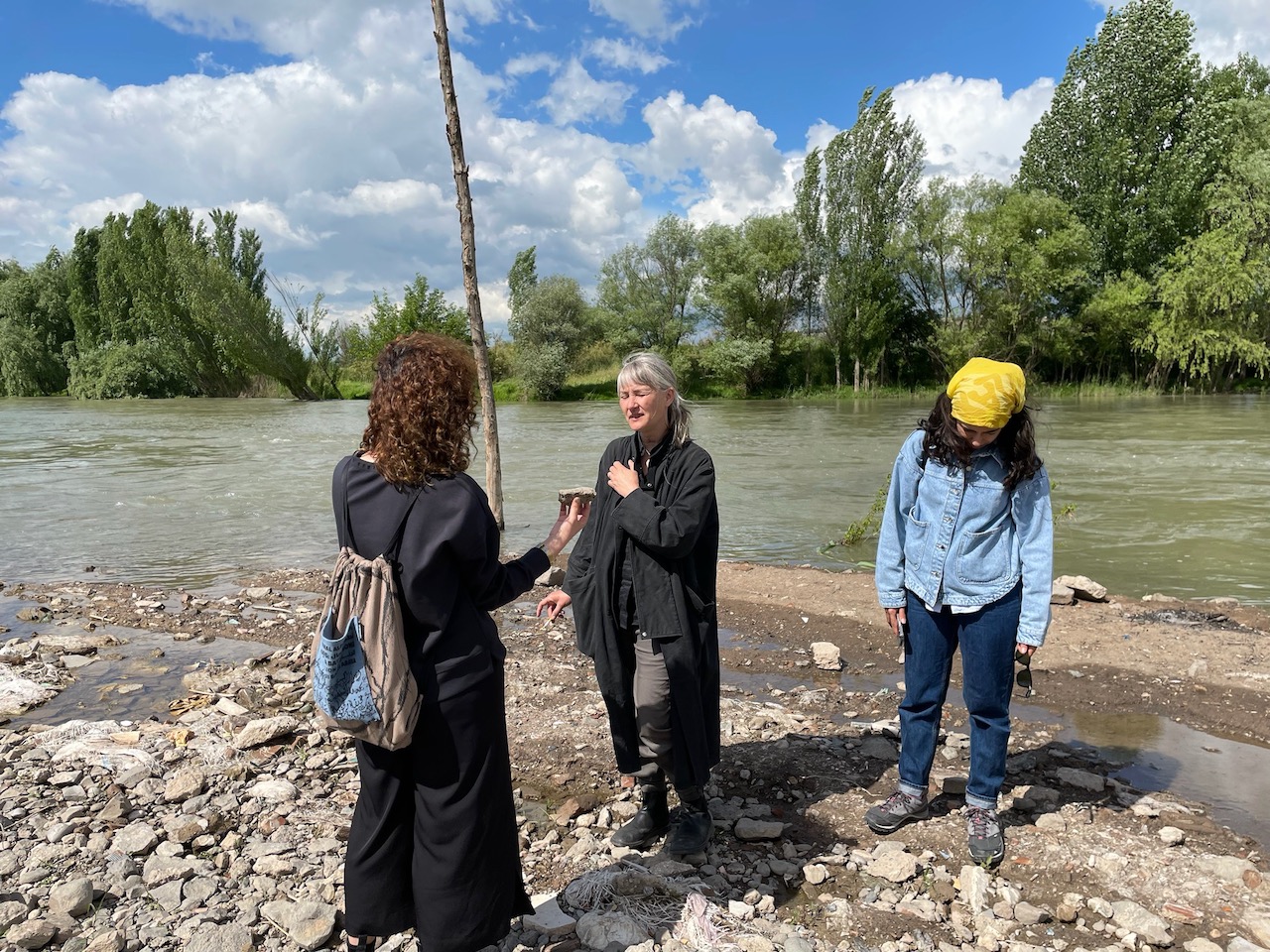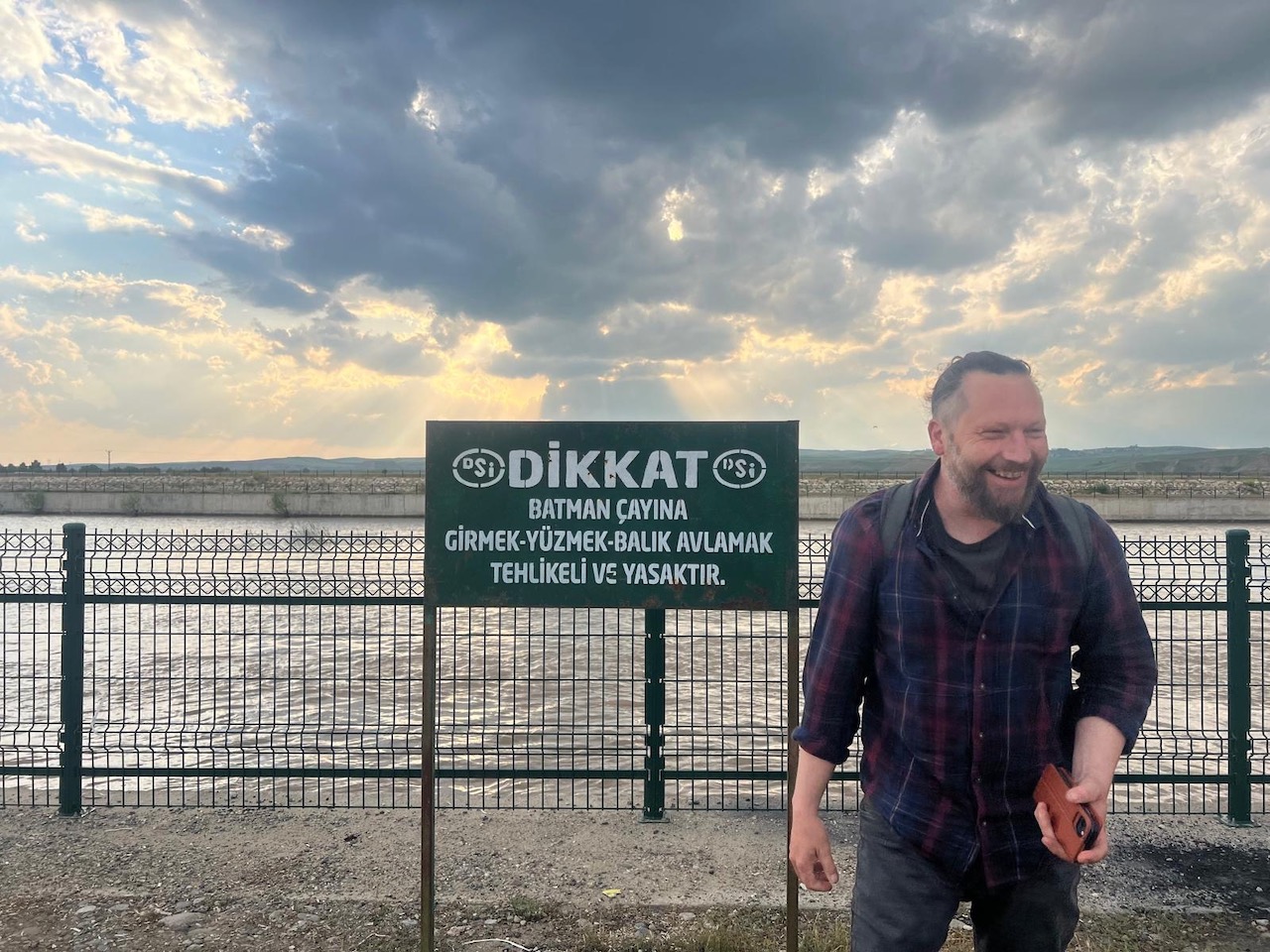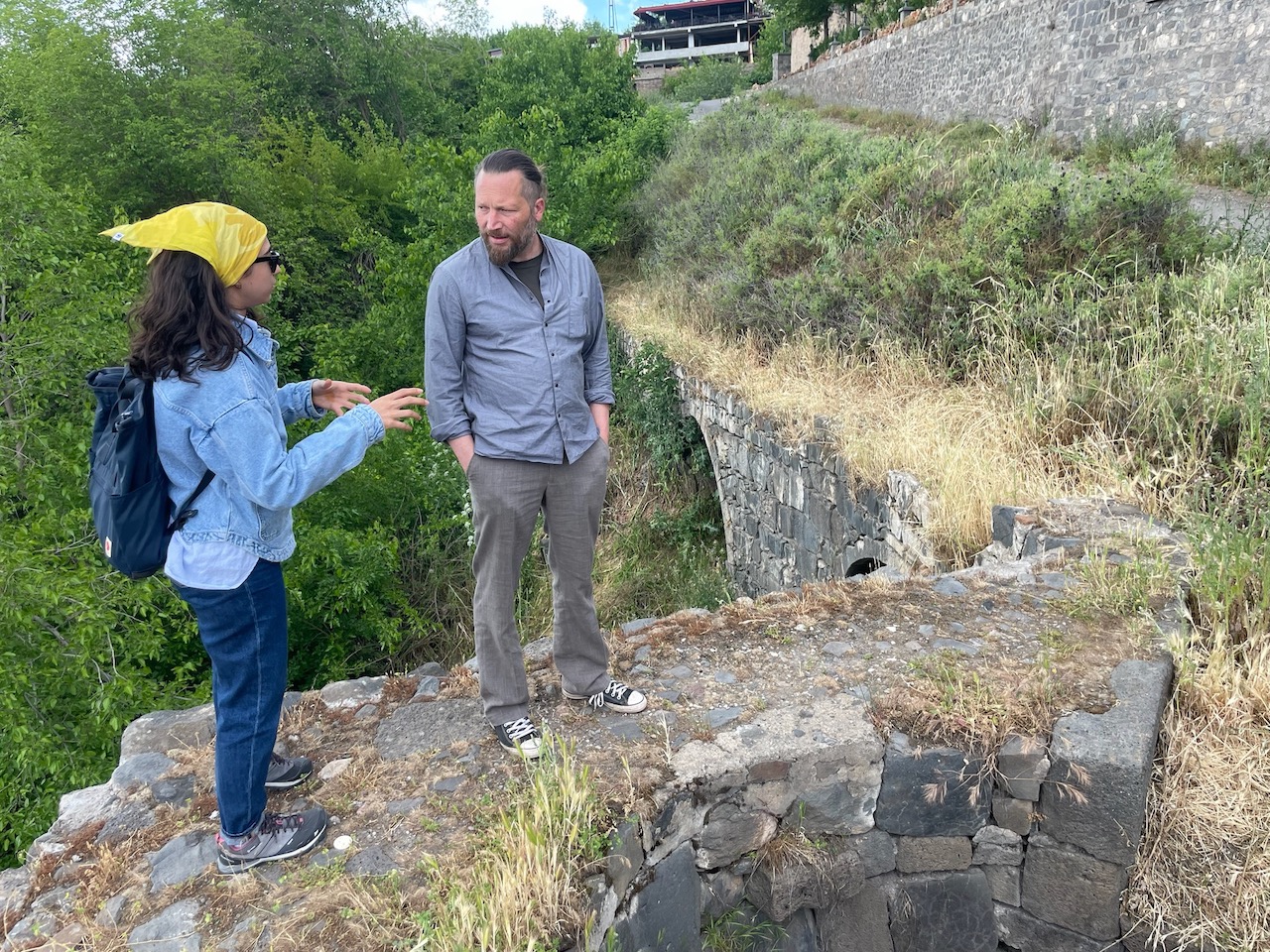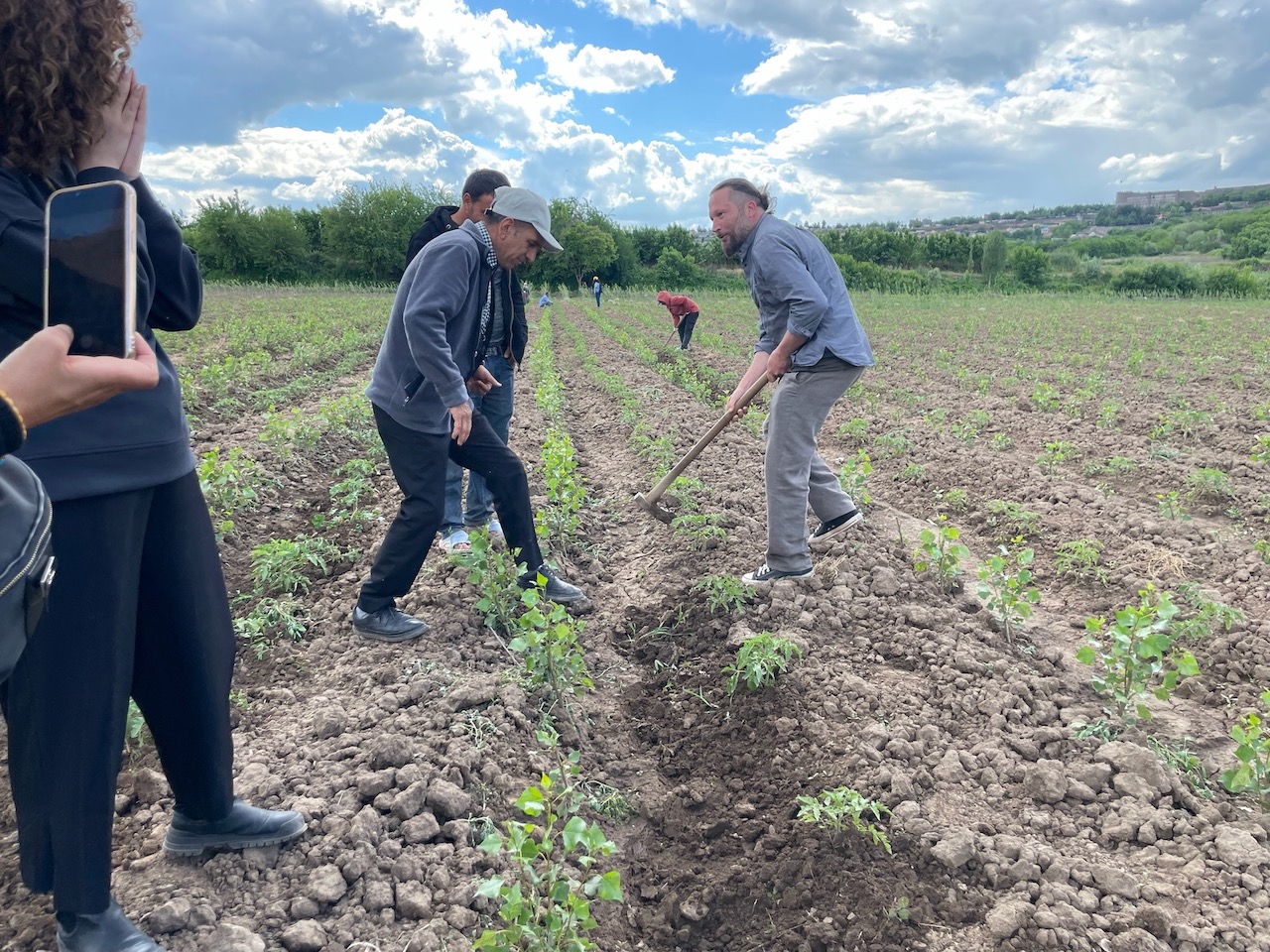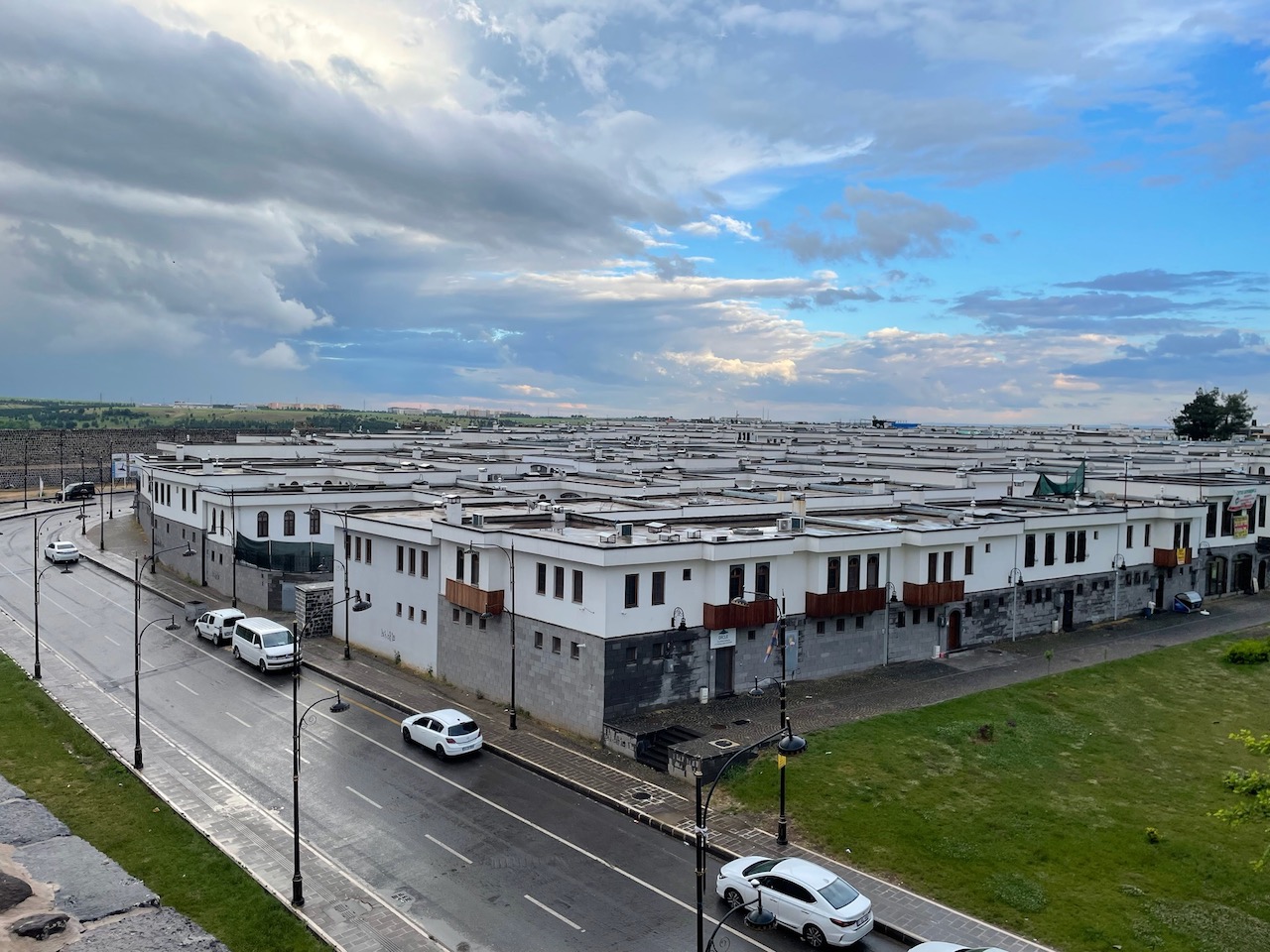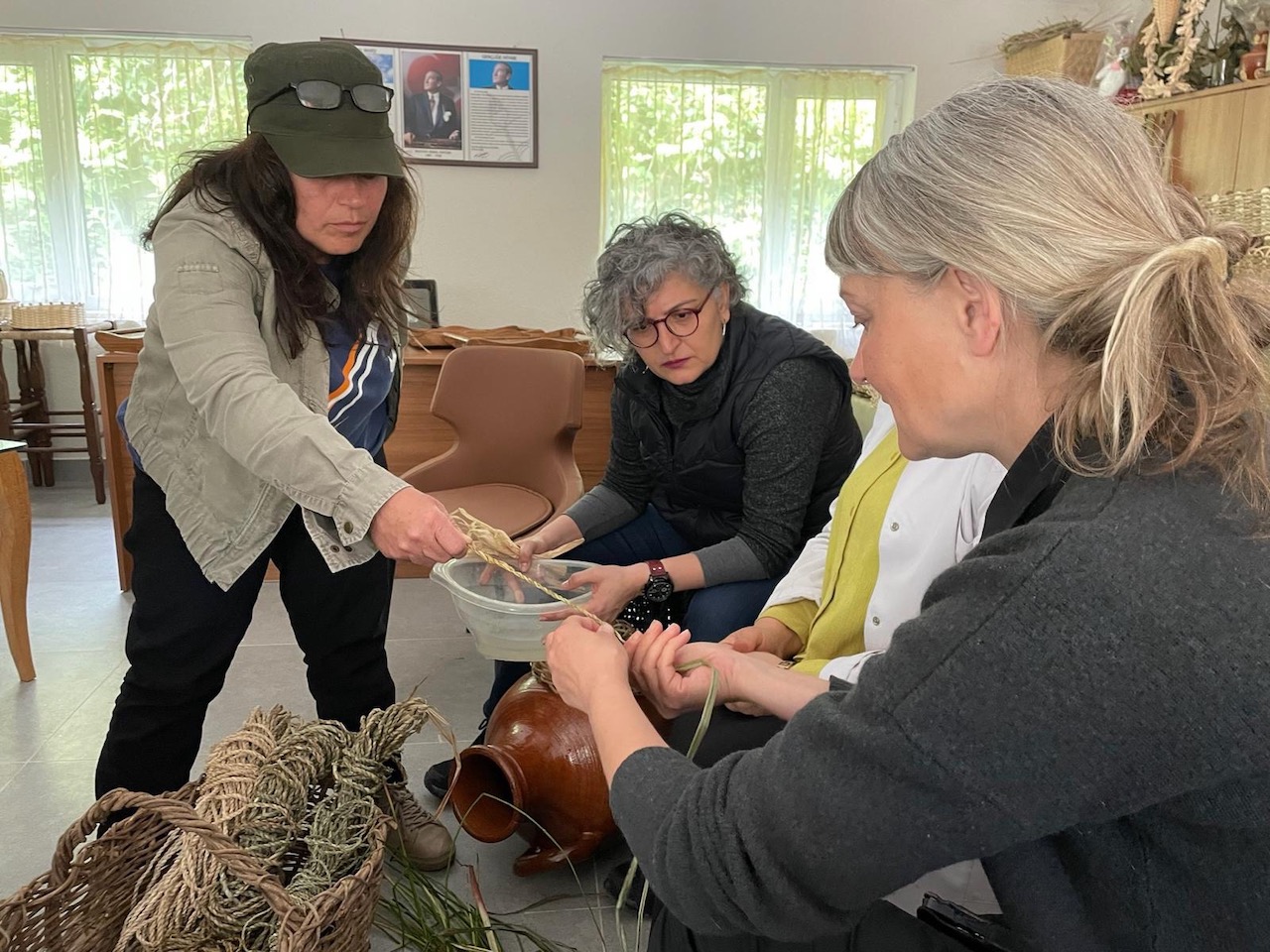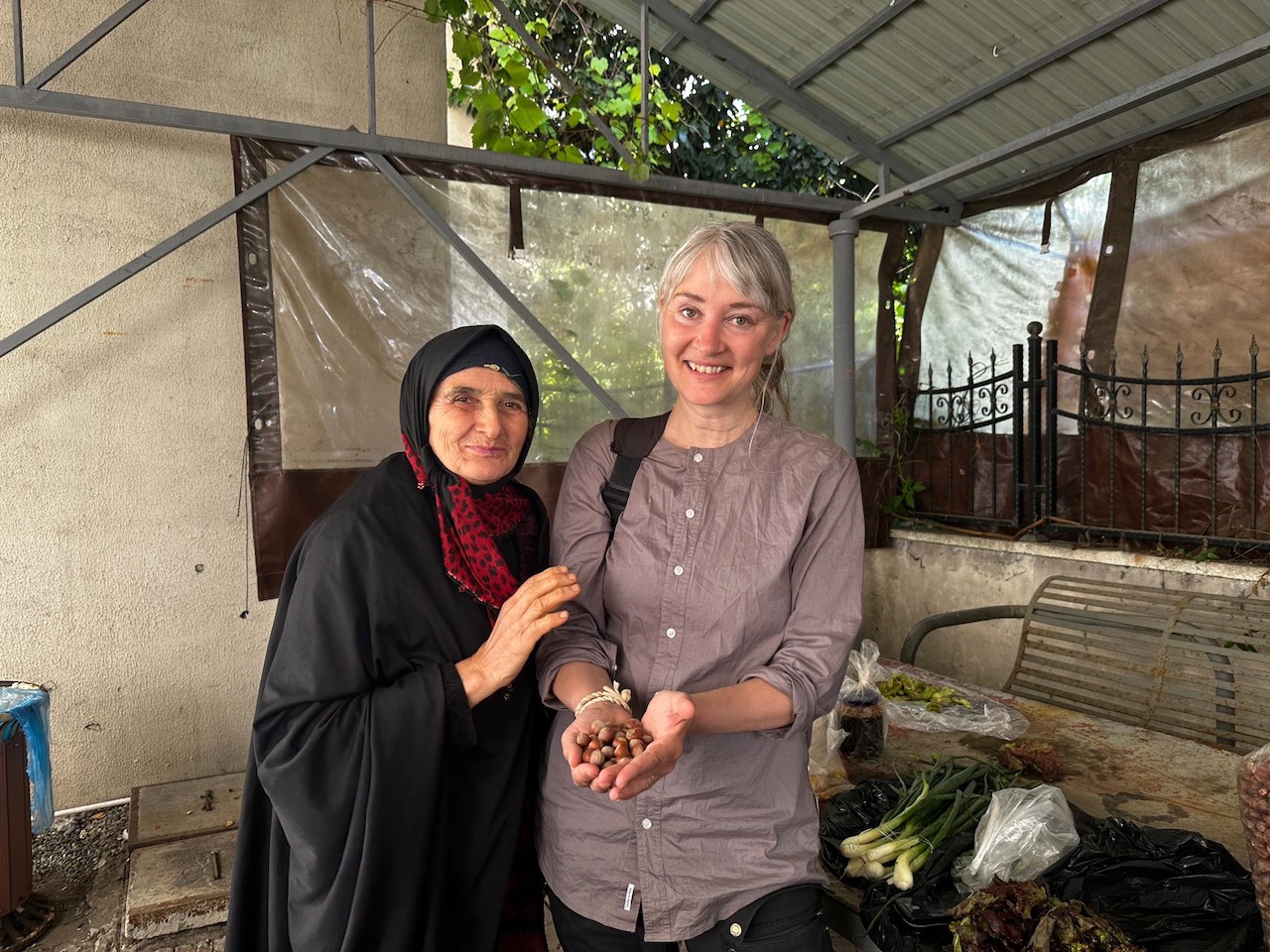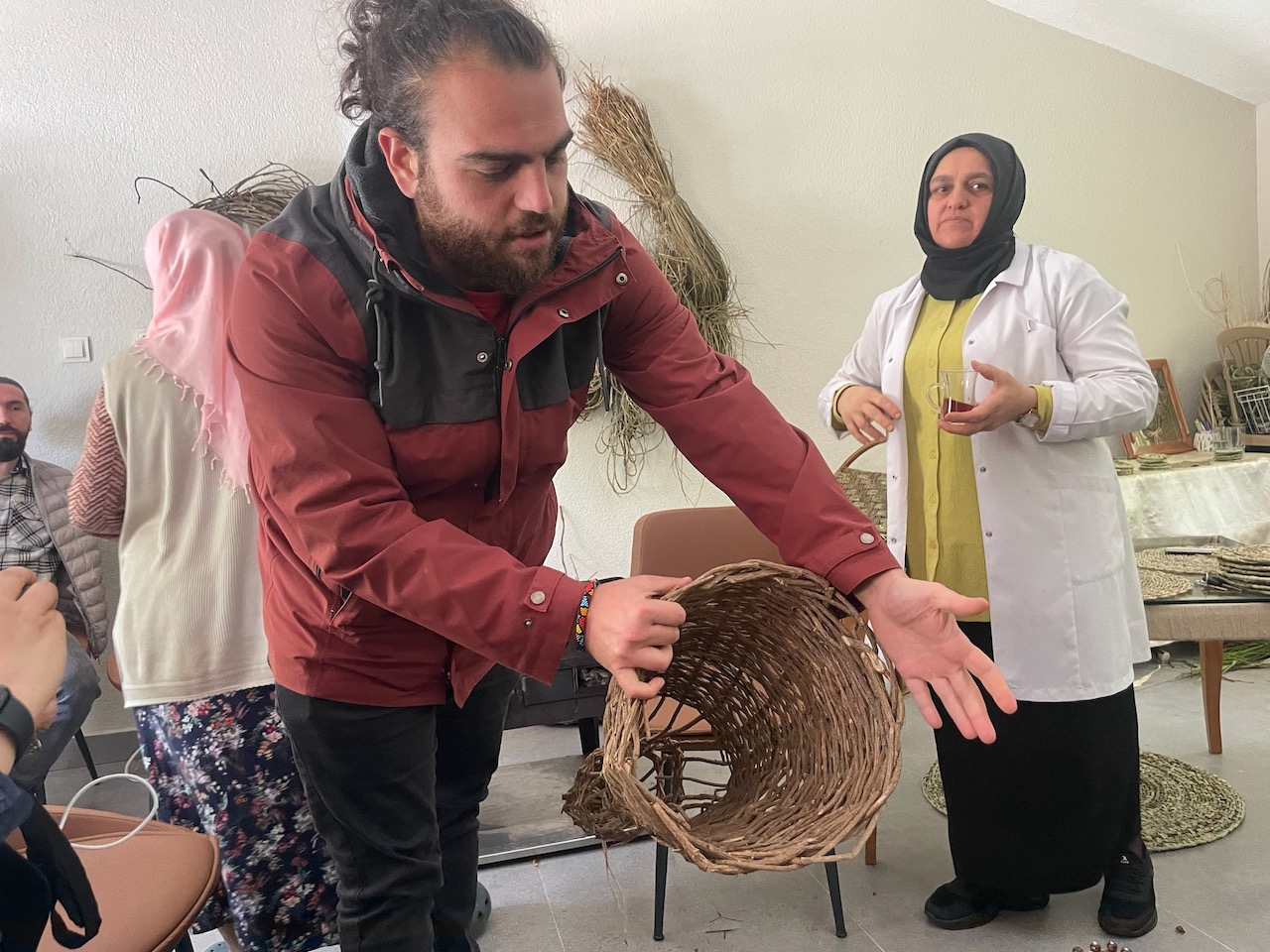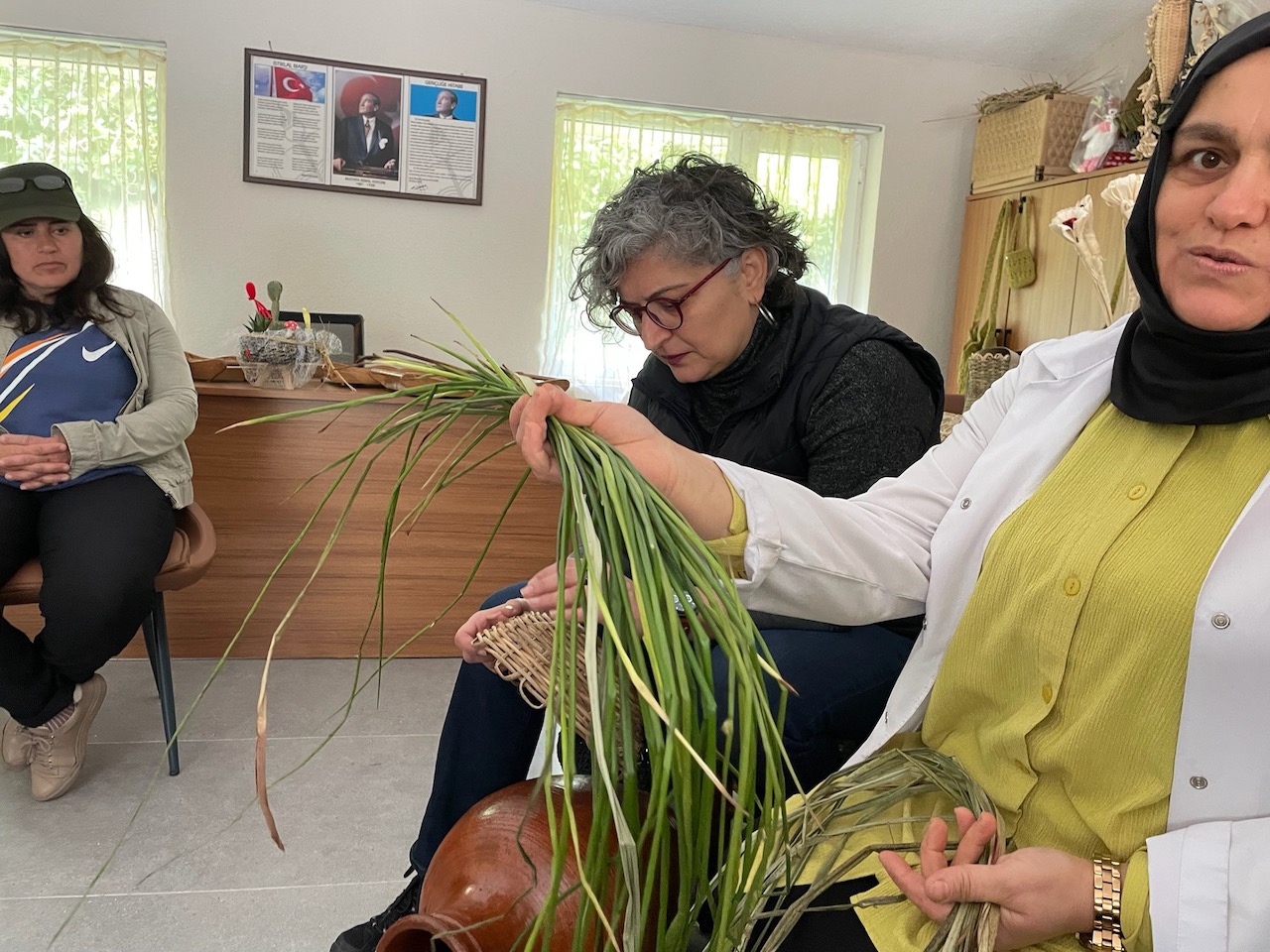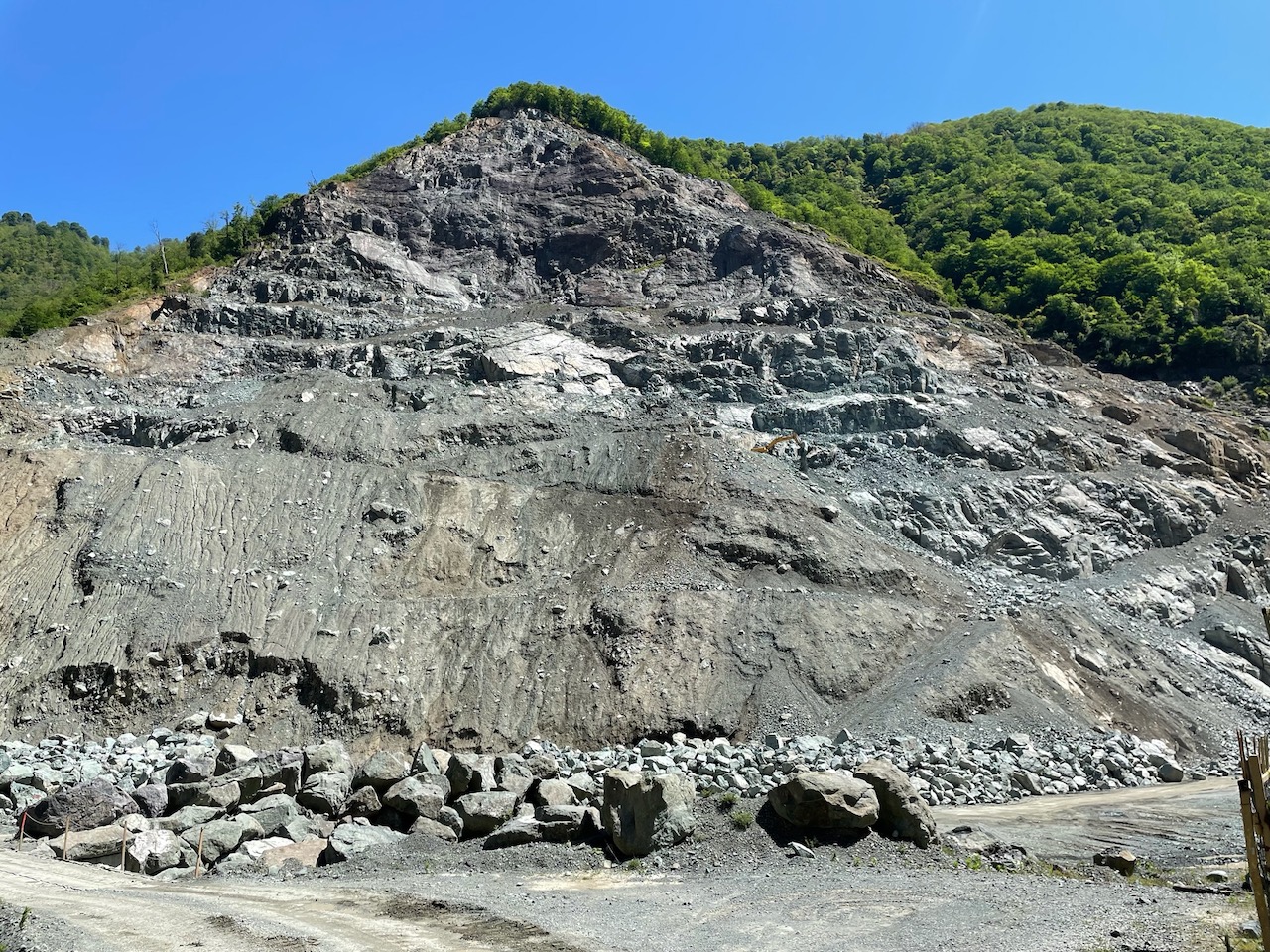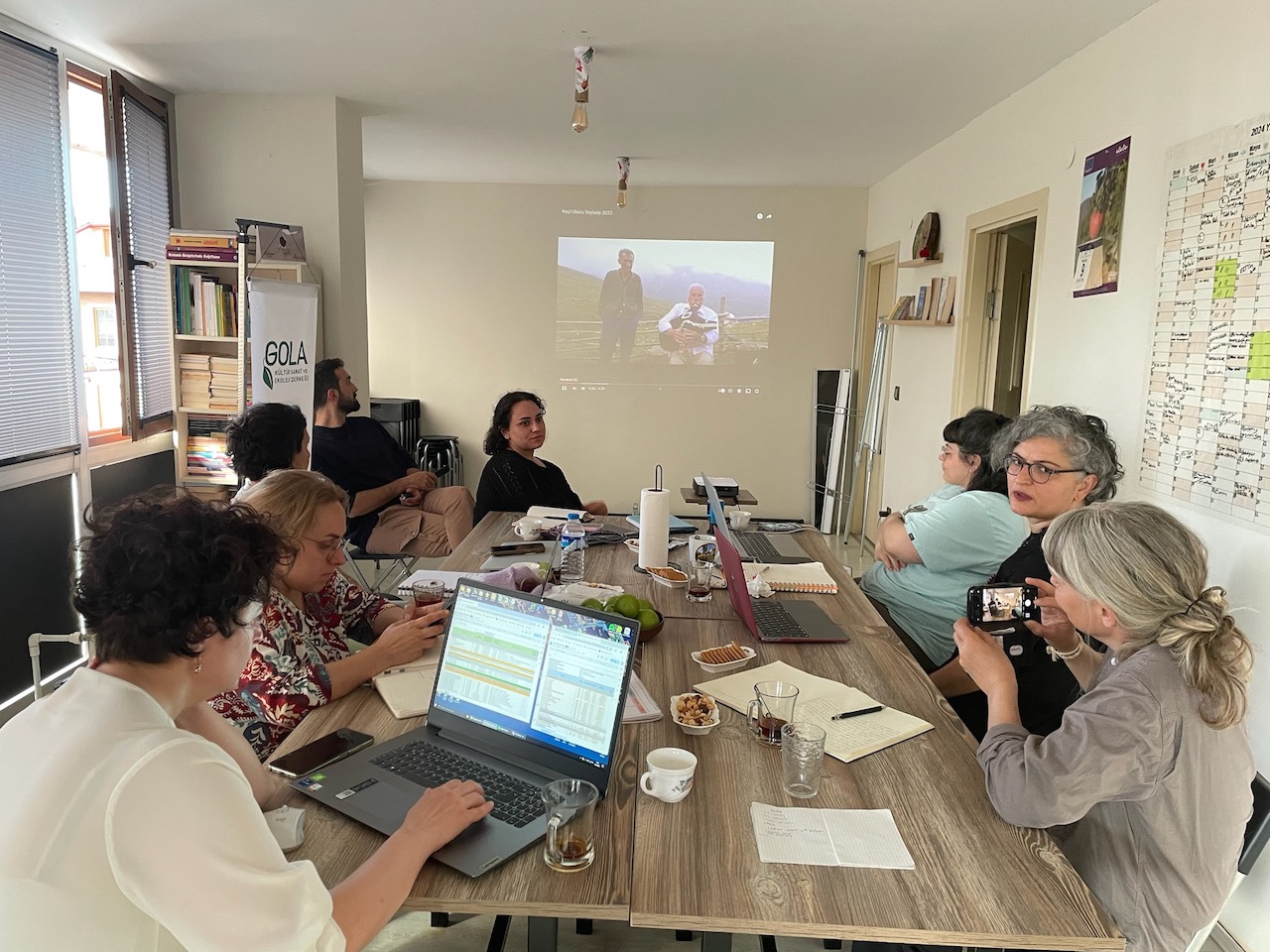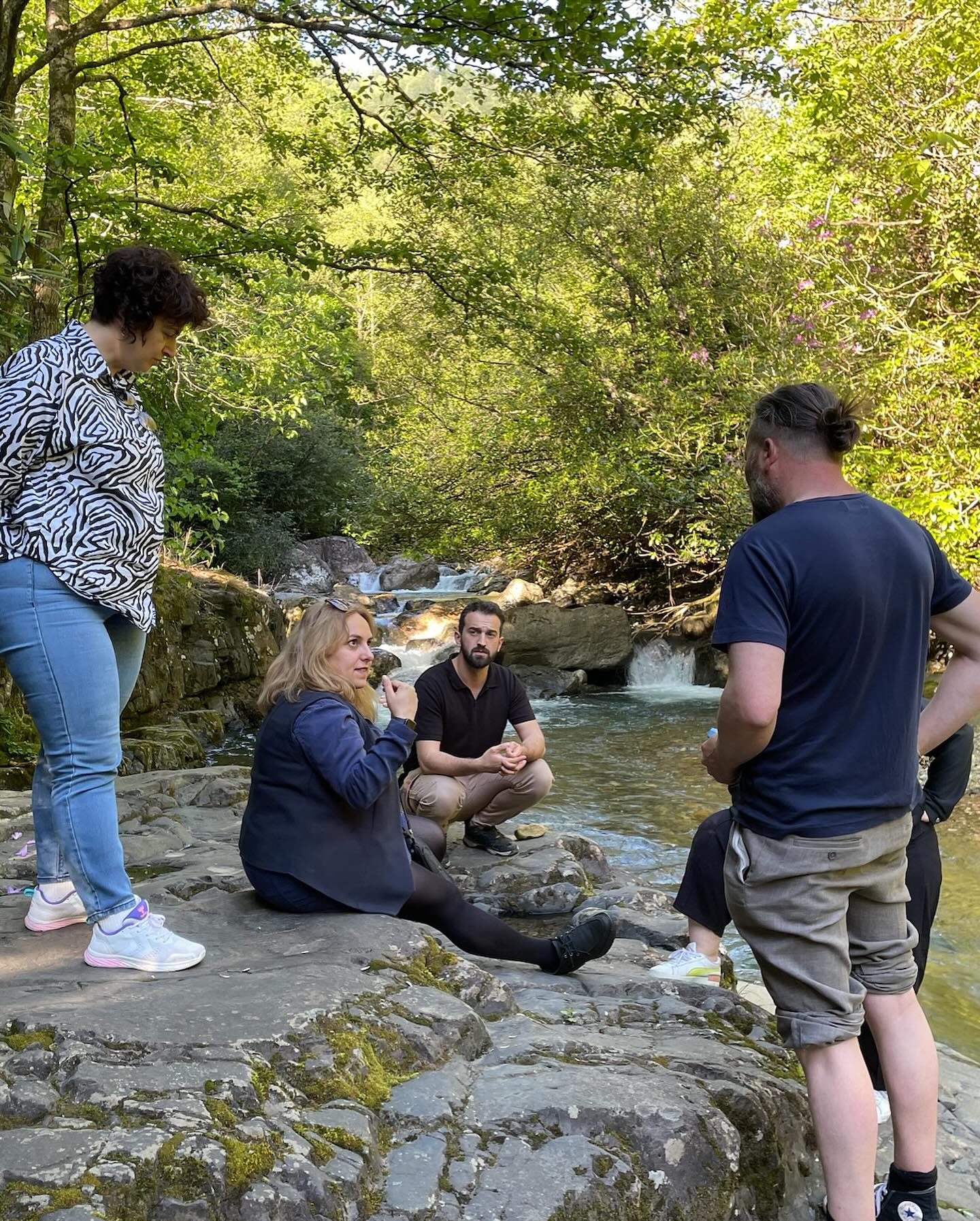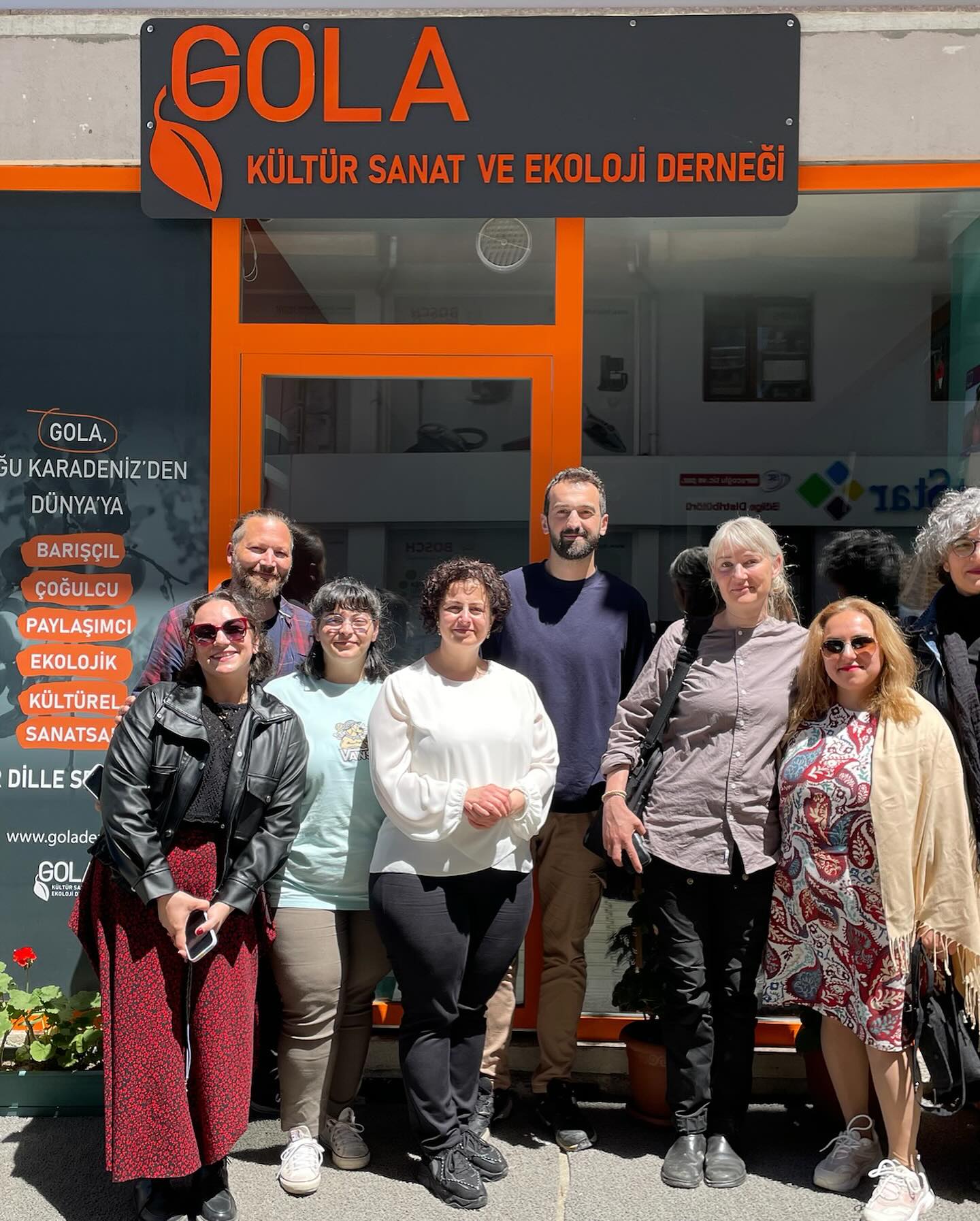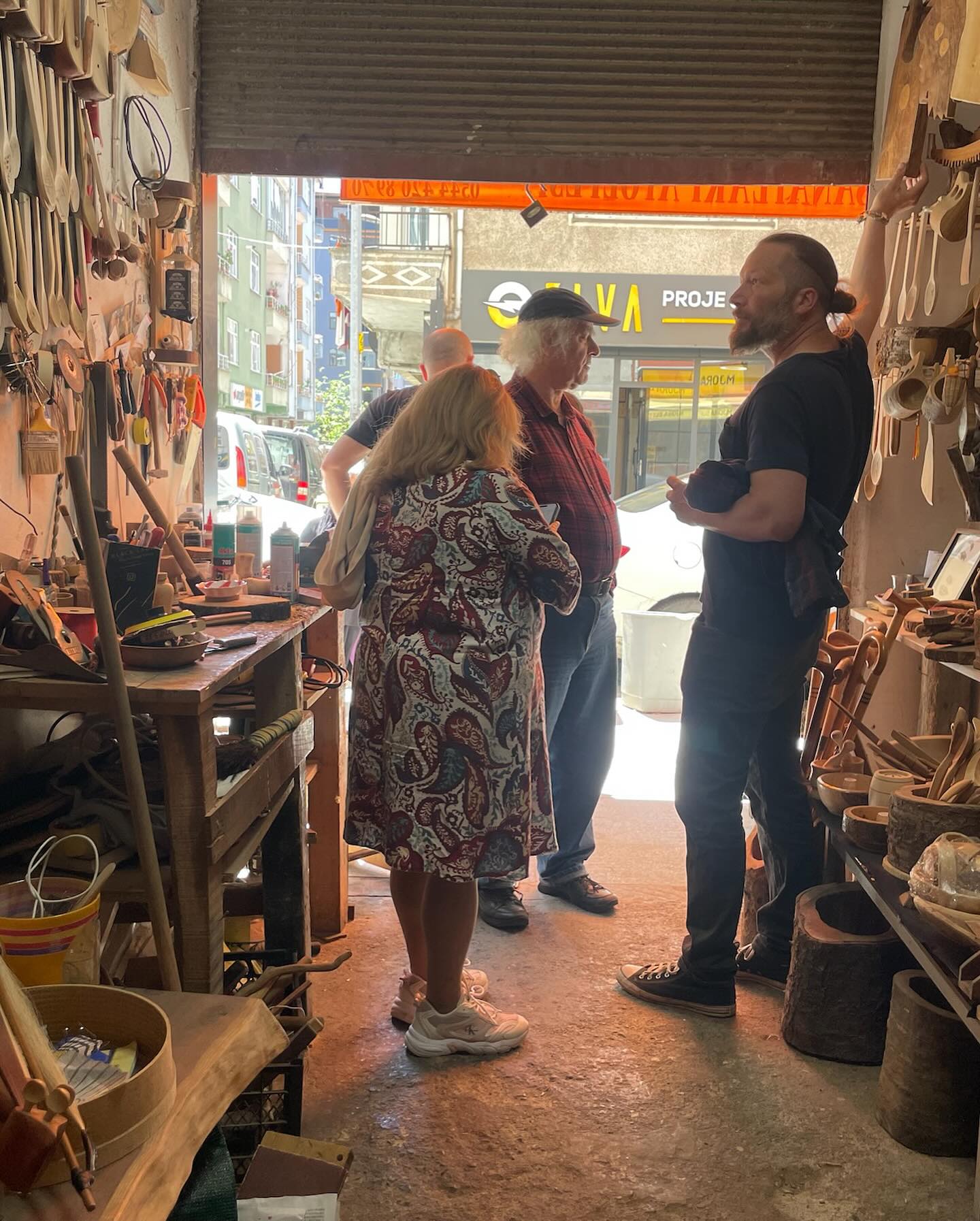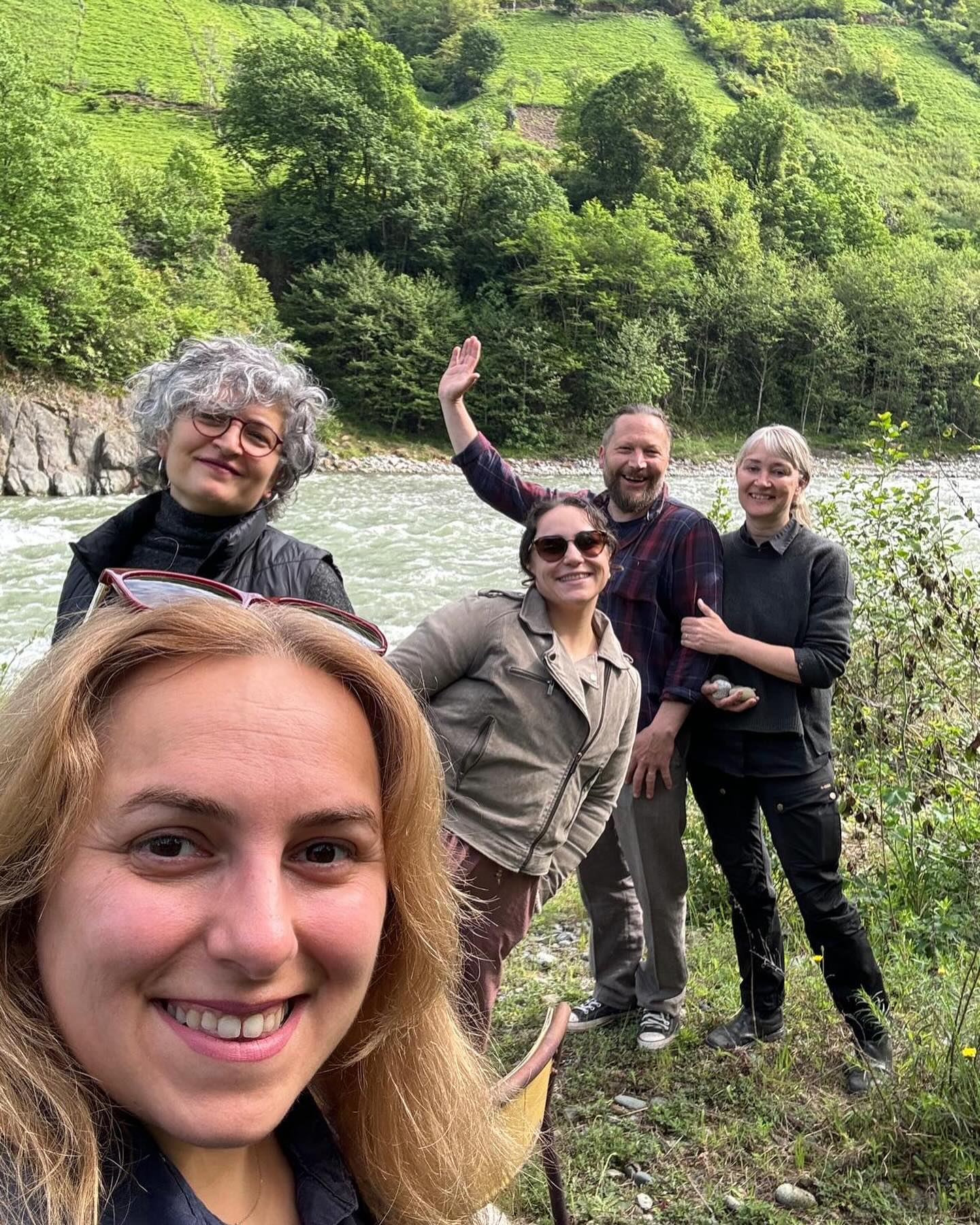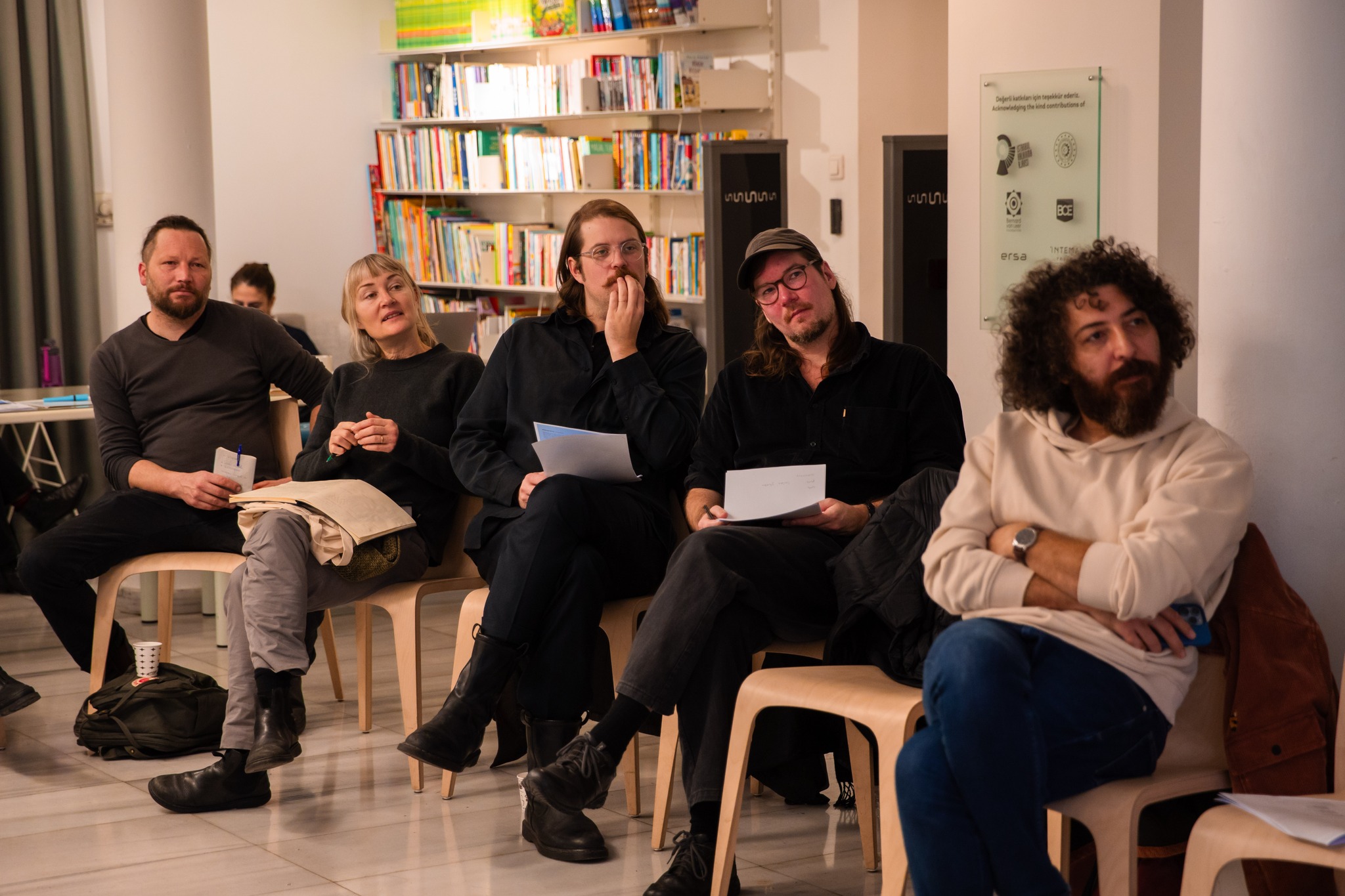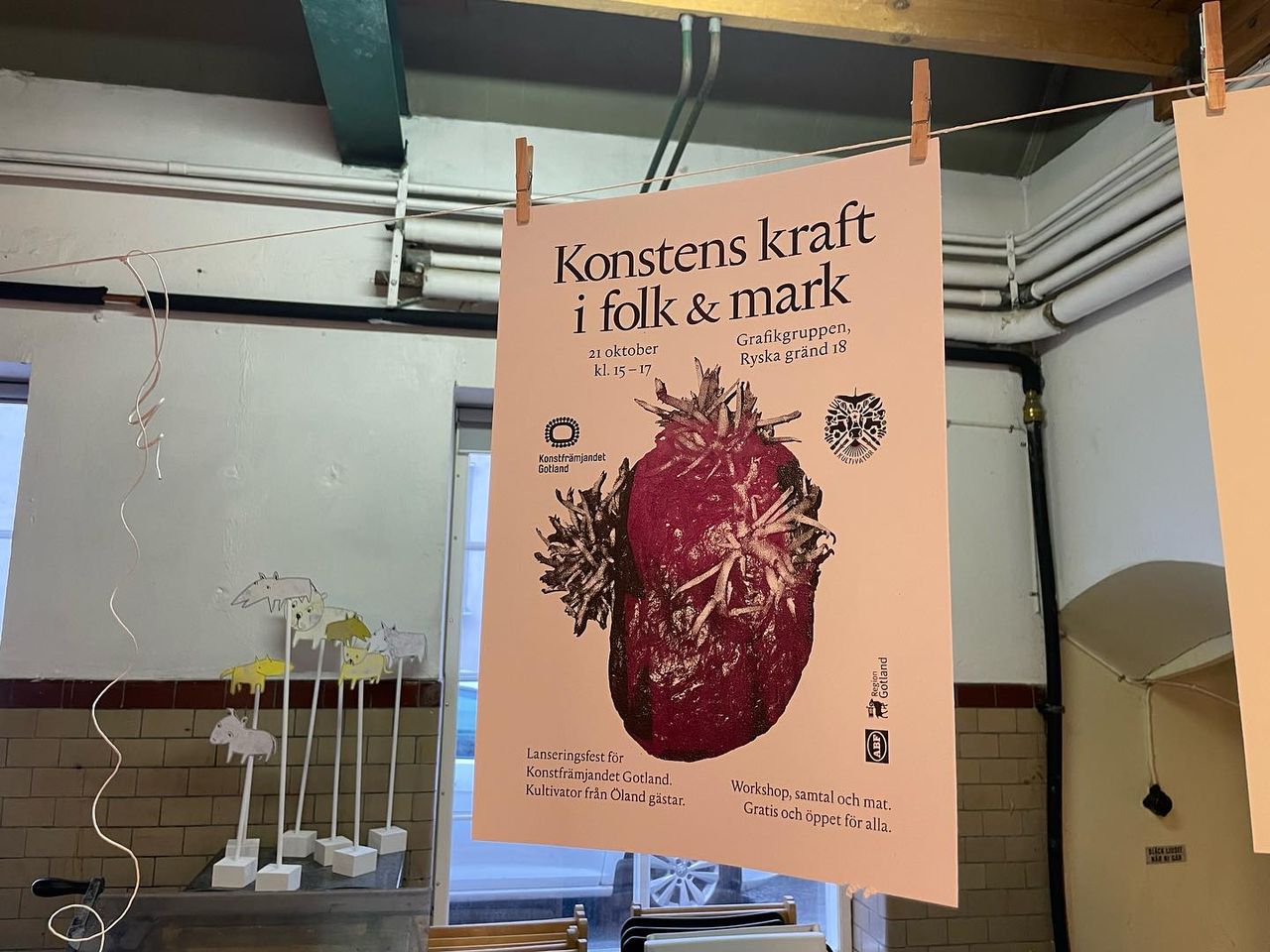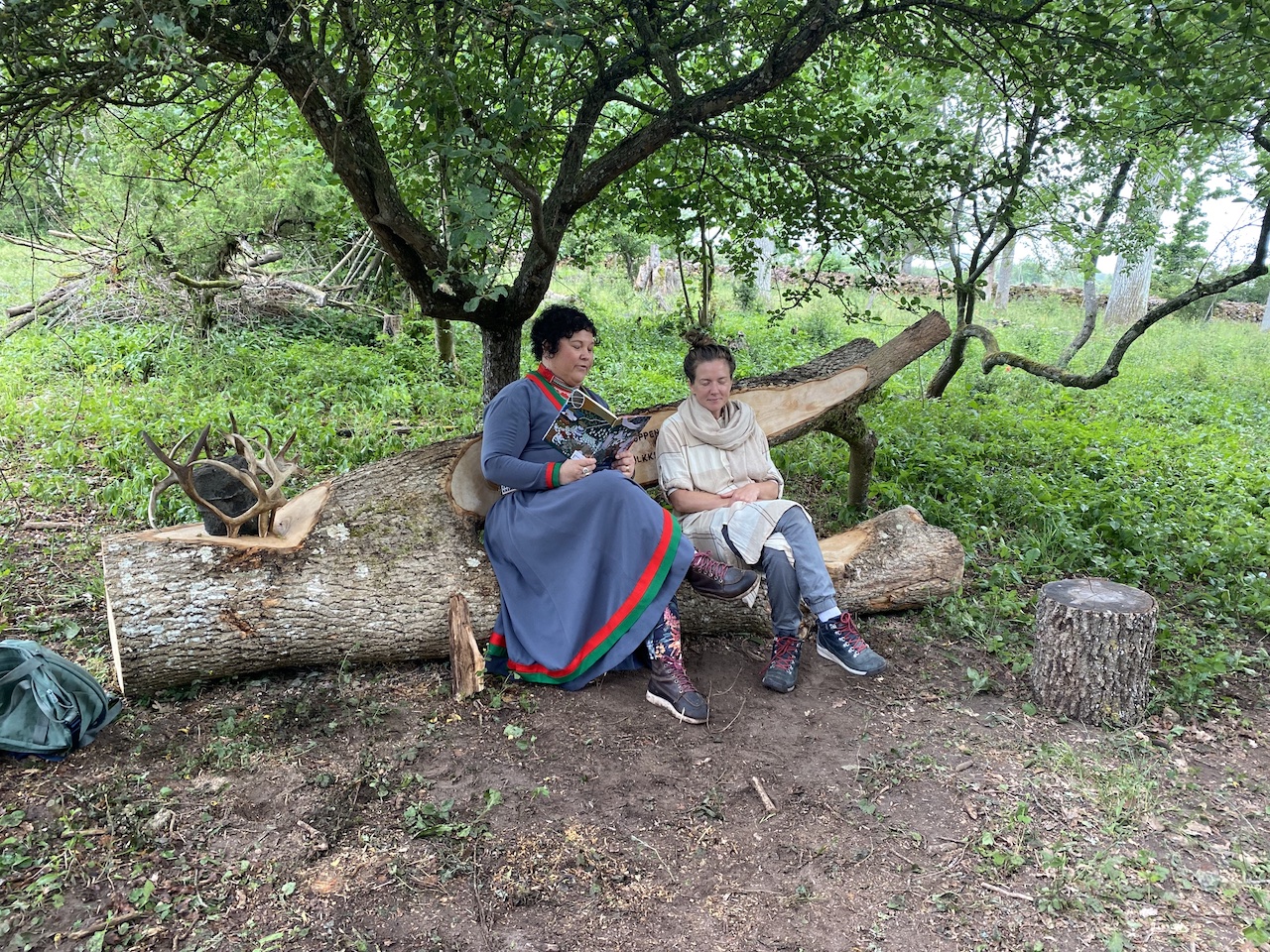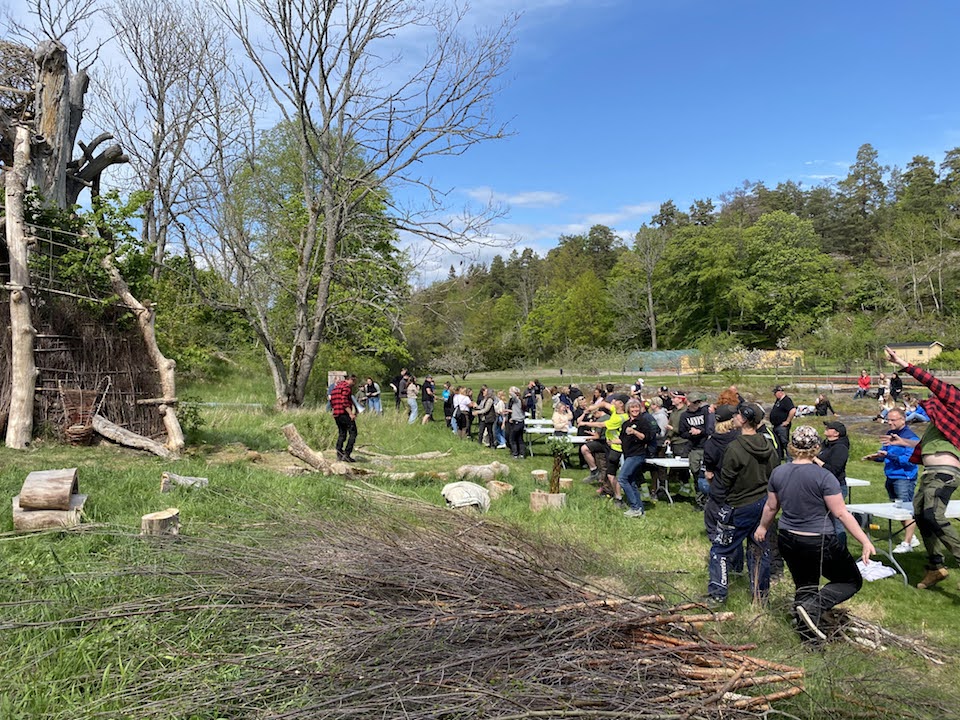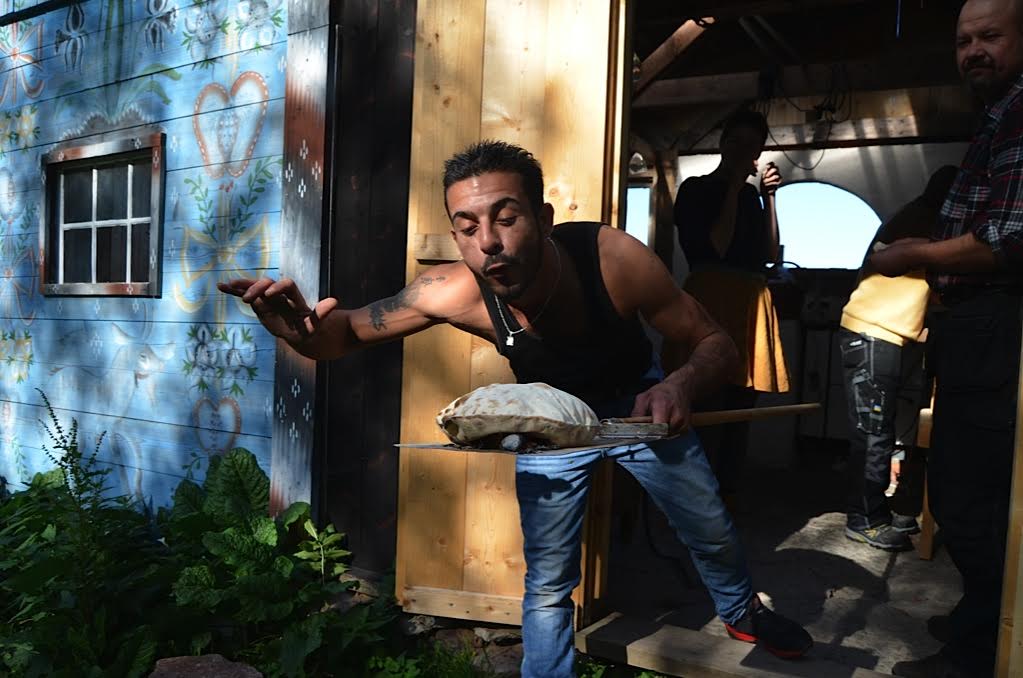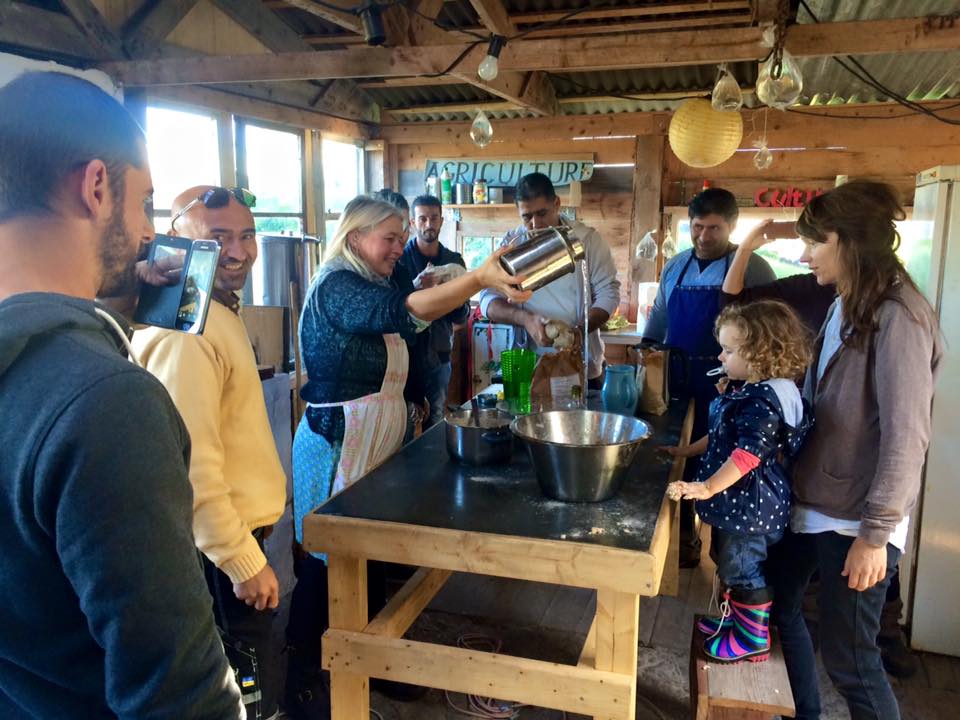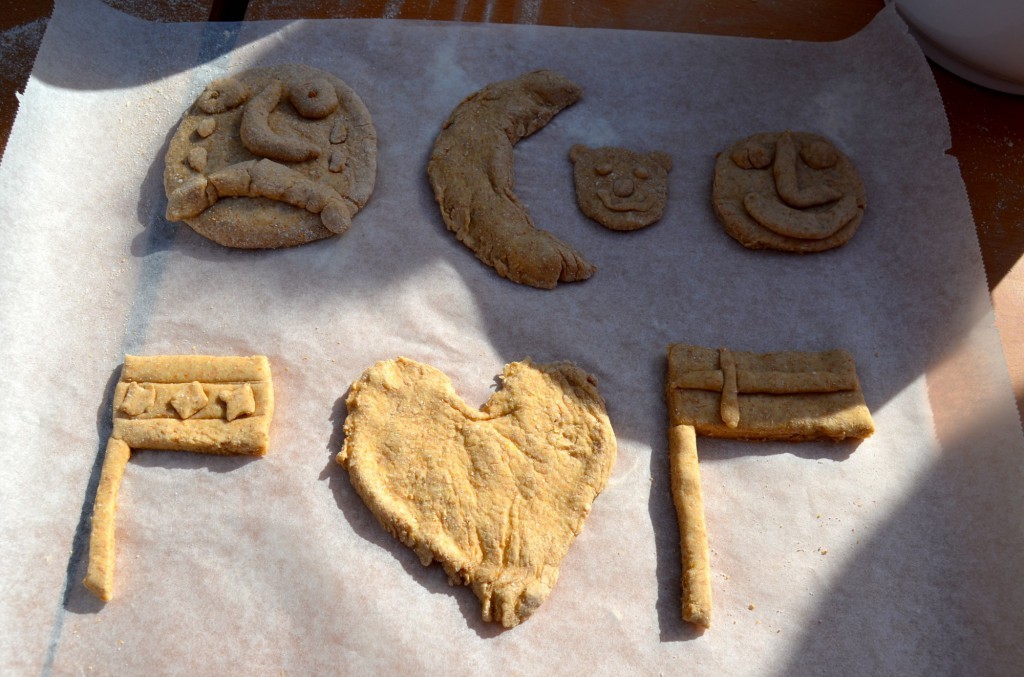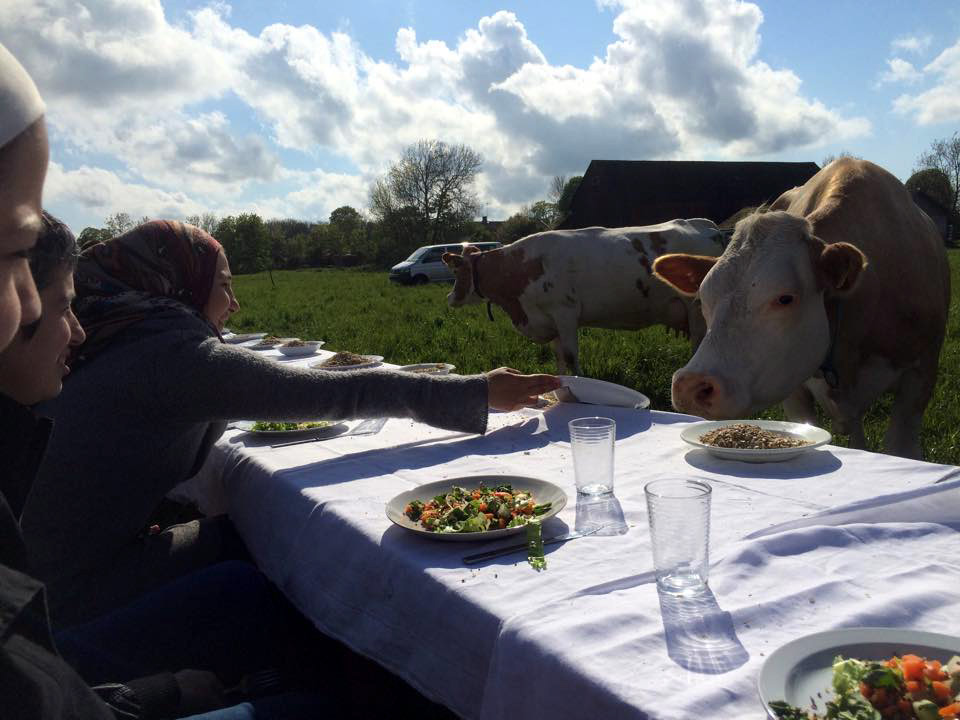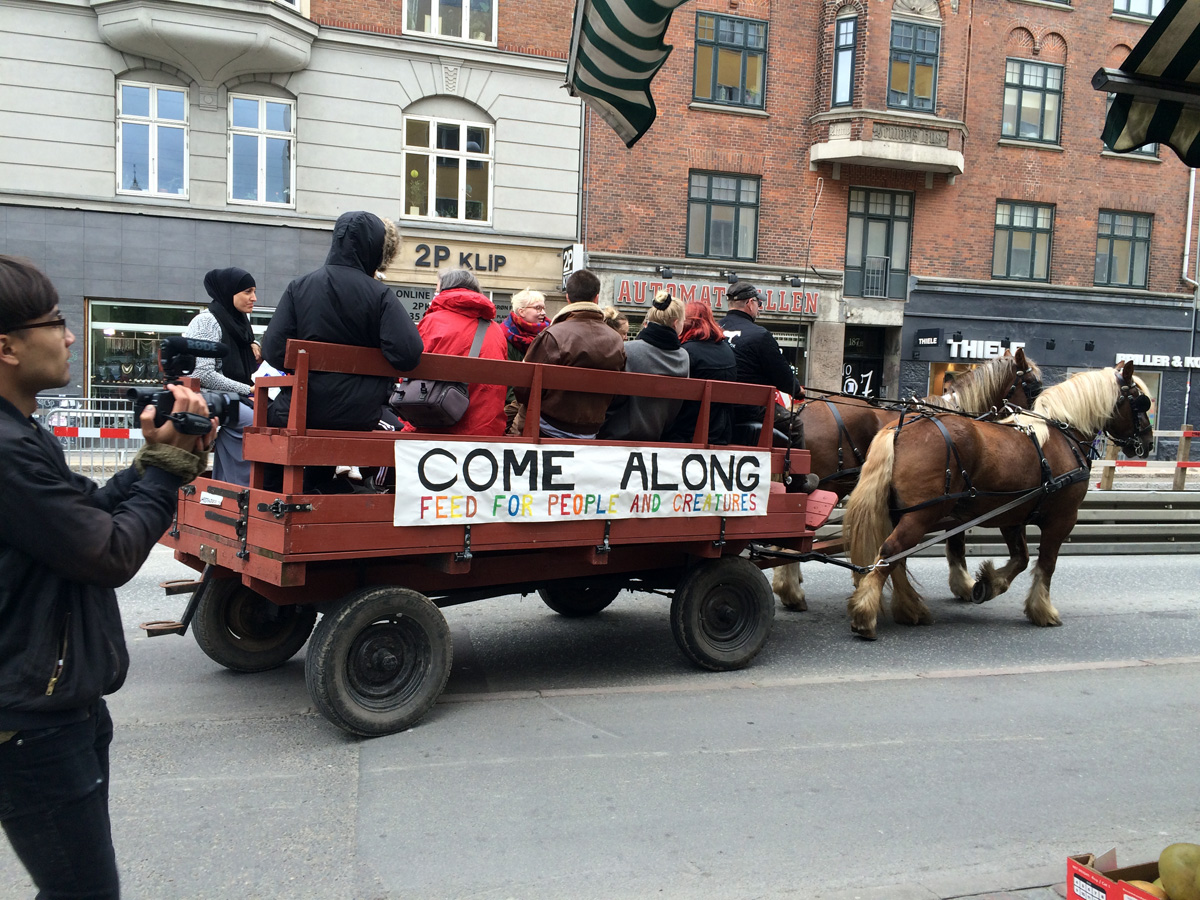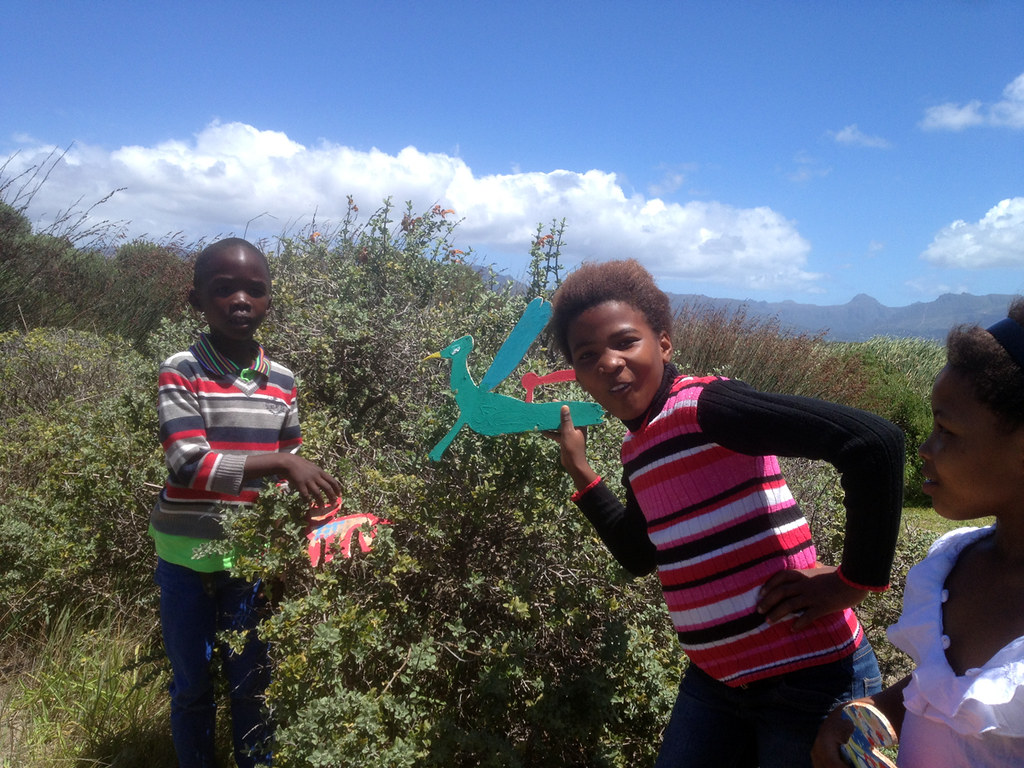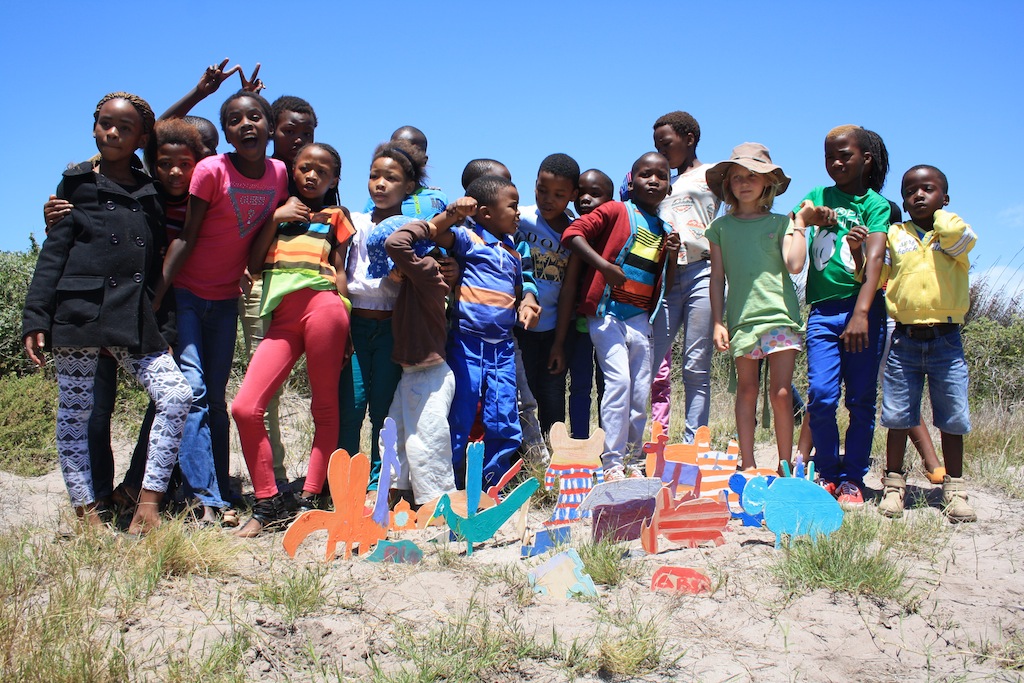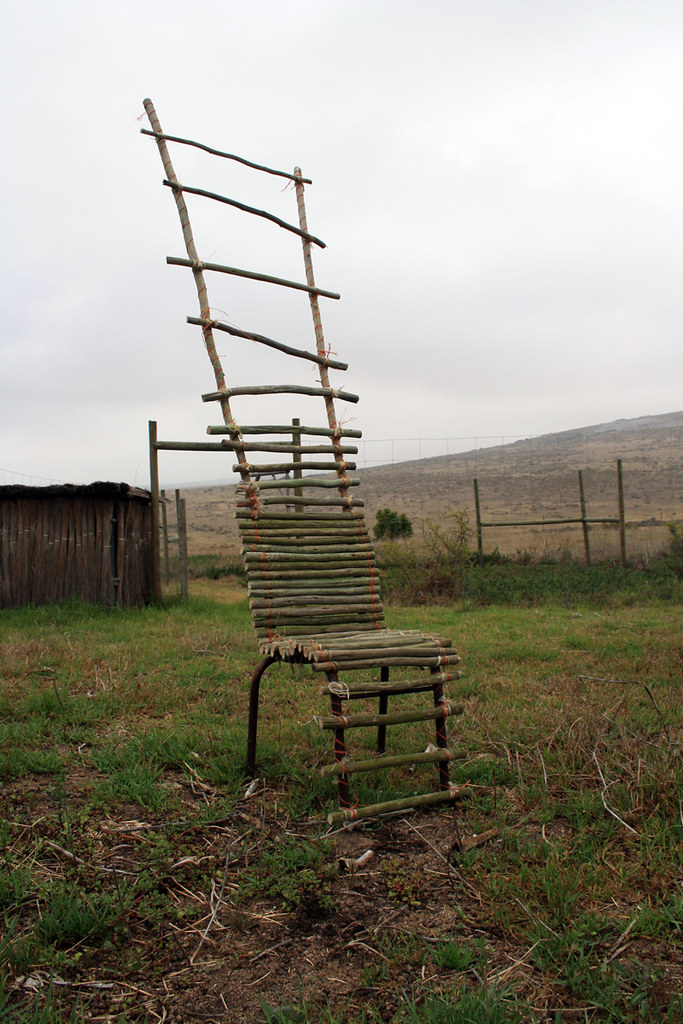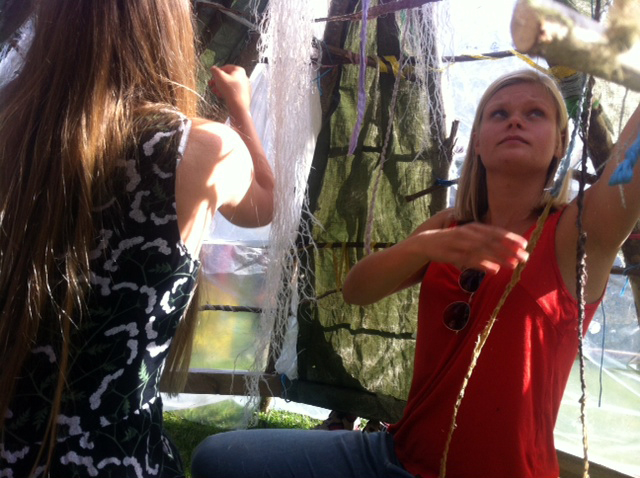An experimental platform for art and agriculture
Carried by rivers, held by land.
Collective work session in the
Tell it to the field research.
From the first collective work session in the Tell it to the field research. In collaboration with Jelmer Verhagen and with amazing guest researchers @konstettan! In one week (with plenty of preparation,) we managed to felt 2/3 of the walls, and raise the whole wood structure of the Shelter and Brain in the field – the Ger. All gratitude to the hazel, sheep, horses, dandy lions and folk songs for making this beginning of more telling and listening fieldwork…
Other hydro powers
Lekgruset, Ammerån
Lekgrus i Ammerån, a part of the project Other hydro powers, supported by Swedish arts grants committee. The project connect several rivers and their nearby peoples in Sweden and Canada.
In collaboration with Eco streams for life, Jämtland and Grevåkerskolan Hammerdal.
Lekgrus = spawn gravel, where in Swedish the word for spawn is the same as for play..
From an initial field trip meeting with biologists of the eco streams for life project that restores (amongst others) the river Ammerån, and their explanations to us what they are working on, we especially took with us the word Lekgrus (spawn gravel). The word inspired us to reach out to children living near the river, and together with Grevåkerskolan in Hammerdal, we could set up a collaboration around the river ecosystems, and particularly the way fish use gravel as a nursery for their young.
The school and teachers of 4 classes (60 kids) planned together with us and the biologists a week dedicated to the river in May 2025. In this week we held workshops making tiny sculptures of river clay for the spawning fish together, the children studied river eco systems, the history of rafting in the river, and the life and family making of the trout and other fish. On the last day we went out to Ammerån, and placed the Lekgrus in the river bed. The biologists from eco streams for life showed us a suitable place, and presented their work with restauration of the river. For every tiny sculpture that was lowered into the water, a greeting from the young artist to the young fish was written and drawn with watercolor. Many of them was wishing the young fish good luck, and many wished to catch and eat the fish once it was grown up. Which would be about the same time as the human kids would be young adults. Given, of course, that Ammerån still runs healthy and alive between Solbergsvattnet and Indalsälven then.
New commons, Guest habitat
New Commons (Skogen, Kultivator, Ställbergs Gruva/Folkets Hus)
In the New Commons project, concrete examples and suggestions are implemented, built and organized on how cultural actors can develop new commons, organize resource sharing and drive processes for increased local resilience. Ställbergs Gruva is involved in developing a cultural center organized jointly with the associations and the municipality of Kopparberg. In Gothenburg and Mariestad, Skogen is practically and theoretically experimenting with sharing systems and new models and methods. Kultivator on Öland is creating a residence and village-wide meeting place that enables hosting based on local organization and local resources.
Letters to the Future Grasslands
With some of the collected droppings from the horses taking part in the interventions with the artwork during the summer, the artists will prepare a paper pulp. In this, the collected seeds for the future grasslands will be mixed. In the workshop, school children will use it to make letters to the future Grasslands, together with Kultivator, with drawings and writings from the children. The letters will be brought to the Future Grasslands and buried/installed in the ground.
Commoning days in Denmarks Heathlands
Meeting the living practice of shepherding of Berit Killerich as part of the project Hosting Lands, we have been most generously hosted in the landscape of sheep, wild horses, wind and and clay. And had so much fun making the Faelledovnen together with Vestjyllands Hojskole
Research for the project Other hydro powers
Guerilla gardening Råneå centrum
A piece of Pine time for the Biodiversity action for Råneåbiennalen
Future grasslands
Kultivator – proposal for HEST!
For the exhibition HEST! at Ronnebaeksholm konsthall, Kultivator proposes an intervention experimenting with interspecies collaboration and exchange of knowledge. The artwork in three parts encompasses and invites horse-human-soil-plant entanglements adding to the overall ecosystem of the place (and of our ways of being together..) In the research of herbs – grass – horse interactions, Kultivator found a study made in the post-nuclear disaster zones of Chernobyl, where herds of the Pzerwalski horse (the last wild horse species) are roaming free. The study is listing the plant preferences of horses that are choosing their diet, (literally in no-mans-land) instead of being served by humans. The artwork is inspired by this scientific observation of a pre-historic horse in a post-apocalyptic landscape, and positions the self-governed taste of the Chernobyl horses as an autonomous nutritional practice and culture, informing three interconnected works: 1. Horse Self-medicating Garden, 2. Future Grasslands, and 3. Regeneration centerpiece.
- The Horse Self – medicating Garden is an invitation for horses and their human companions to smell, taste and observe together, taking a walk along a path framed by plants with medicinal properties (for both species). The medicinal properties are identified in human scientific or/and other belief-systems, with short summaries written on the wooden plant shelters. For the visiting horses, the information of the remedies are presented by the plants themselves: by smell, taste, shape and colors, probably and possibly corresponding with both evolutionary memory and personal experience for each individual. The joint walk passing these different displays of information, with freedom for both to select which plants to consume, offers a way for the walking companions to learn more about the desires and needs of each other. The Horse self-medicating garden acknowledge Horse experience and ability to make choices, and was inaugurated in June 2024.
- Future Grasslands is a small patch of land near the garden. Here a slow transformation from present monoculture lawn towards future biodiverse grassland is initiated by Kultivator and gardener Sara Gade. The grass that grows there will is cut and moved to create space for the species noted in the study of Pzerwalskis horses in the Chernobyl exception zone. Through the summer of 2024, seeds have been collected in meadows on Öland that correspond with the study. The seeds were then used in a workshop in October making seed-paper sheets as letters to the future grasslands, and placed in the patch. The letters will be “read” by the piece of land during the winter, and in the spring to come the herbs and grasses listed by the wild horses will sprout, slowly composing the Future Grasslands.
- Regenerative Centerpiece. Is the beginning and the end of all activities in the garden, and therefore stands in the center of it. It invites visitors of the garden to take a rest in the shadow and watch, smell and feel the de-composing and re- generating works of millions of sub visible companions, connecting the different activities of the garden. They are processing manure from the visiting horses, decomposing grass from the Future Grasslands patch and arranging other garden left overs into new life supporting matter, which will return to and nurture the cultivations in Horse Self-medicating garden. The structure that supports the work began as trunks of trees, cut down to be pallets, and then re purposed by Kultivator as building elements for the walls and benches of the Regenerative Centerpiece.
River community research in Turkey
The Observatory: Art and Life in the Critical Zone
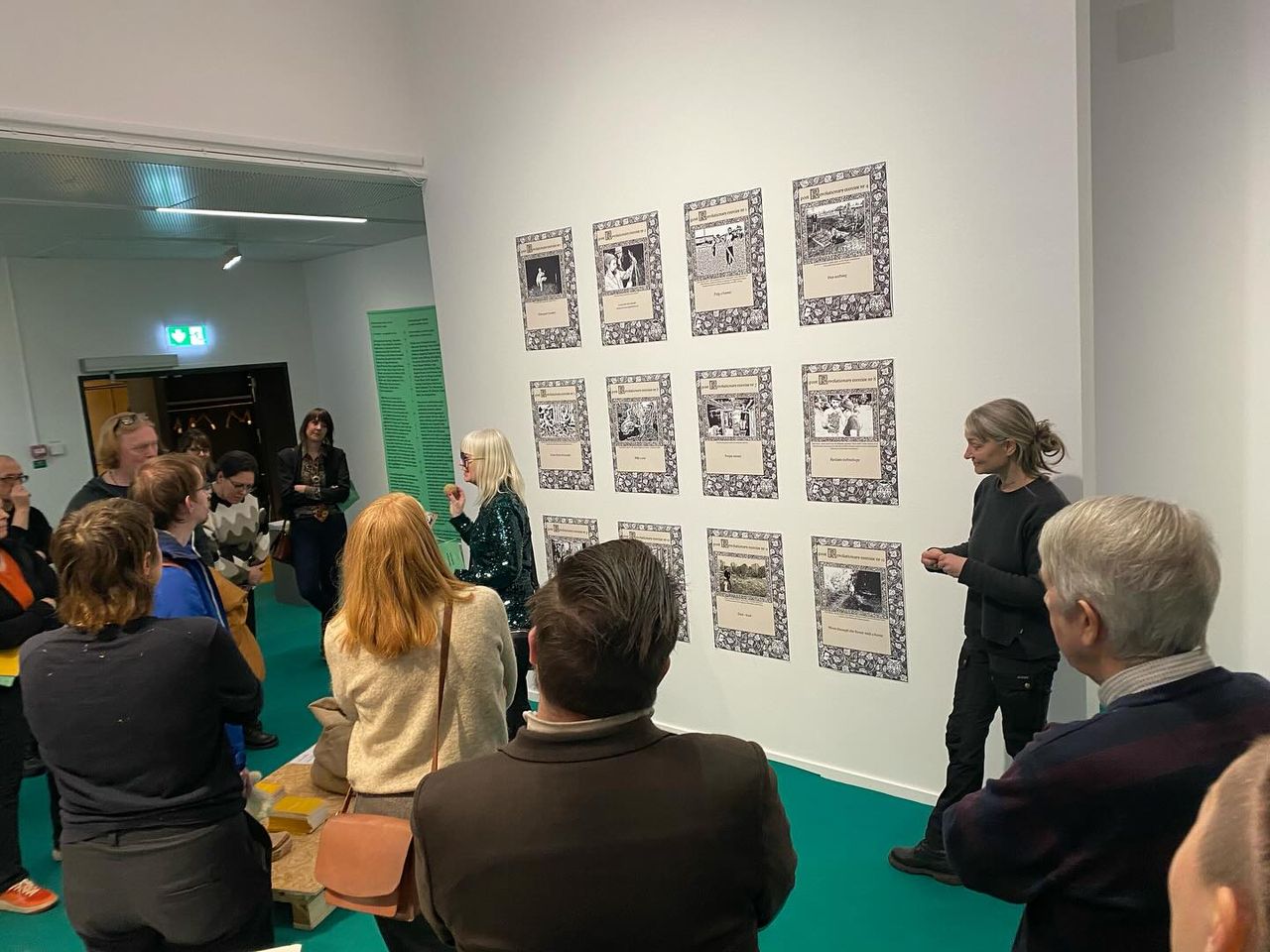
Wayward art initiatives
Istanbul, Turkey
The Değişken İnisiyatifler / Wayward Initiatives symposium brought together peripheral art initiatives from Türkiye and Sweden in order to open up a common discussion about methodologies, formats and cultural resilience. Held between 5 – 8 December, the first meeting of the program took place at İMÇ, SAHA Studio’s new location, with visits to 5533, Imalathane and 400 x 118, located in the same building.
The symposium took the form of workshops, site visits, presentations and events over the course of three days. During the program,How does one develop artistic methodologies in relation to working in a hyper-local context? How can one engage in cultural heritage and local histories? Can the production of art have a positive effect on the environment? How can we design adaptable and multifarious spaces which ensure sustainability? questions were explored together.
The project was initiated by the Consulate General of Sweden and developed in collaboration with SAHA and Istanbul Foundation for Culture and Arts (İKSV). The project is supported by the Swedish Arts Council together with IASPIS the Swedish Arts Grants Committee ́s International Programme for Visual and Applied Arts.
Participating Initiatives:
Arazi Assembly, Mardin , Coyote, Stockholm, Hayy Open Space, Izmir, Ka Atölye, Ankara, Kulturhane, Mersin
Kultivator, Öland, Loading, Diyarbakir, Postane, İstanbul, Ställbergs Gruva, Ljusnarsberg , SUB, Çanakkale
Konstens kraft i folk & mark
Lansering av Konstfrämjandet Gotland
Residens Symbiotiska kopplingar i och med Rogsån, Falun
From two residence periods in the summer of 2023 in and with the small river “Rogsån”, Kultivator invited to a gathering In Österå village community building, previous village school. Malin Lindmark Vrjman and Mathieu Vrjman from Kultivator held a presentation of their artistic practice, and gave three workshops/actions that dive deeper into the river Rogsån, and at the same time starts a network work around and with watercourses in Sweden, Norway and Canada. In the first workshop, "a fleet for the future", Mathieu Vrijman invites you to equip (and then launch) boat sculptures for the challenges of the future. The models are inspired by the finds of ancient log boats that were made in Igeltjärn near Rogsån in the 1930s, and disappeared from Dalarna's museum in the 60s. The boats, and descriptions of fishing gear that were found near them, indicate Sami presence in the area. What knowledge and approaches to the water in the landscape have been pushed aside and forgotten in the story of our common past? How can we lift and remember the forgotten in the face
of the change the climate crisis and the mass extinction of species are presenting to us? The conversation and fitting out of the boats is followed by a joint walk to Rogsån, where they are launched for further travel through the water system. The second workshop, "The Net" is led by Malin Lindmark Vrijman with the help of Lina Sofia Lundin. Here we materialize the network of waterways by literally tying a web together, of the fibers and with the craft knowledge found in the area. For Rogsåns net, we use flax yarn, grown, processed and spun nearby. During the work with the hands, we invite to also share stories, memories, or other
thoughts around the river, based on material from a study circle that is available to take part in during the workshop. The piece of net we tie while we talk becomes the very first part of the Net which will travel on to other places near watercourses, where it is tied further with other people who have a relationship with their water, with other local materials/ fibers, and other stories. We think of the net as a work that never ends, but can travel around to communities near water as long as
someone has the strength to carry it. In the last workshop/action, those who want to go with the local Fishing association out to Rogsån
and we contribute tangibly together to their work with the restoration of the river for increased
biological diversity.
THE OBSERVATORY: ART AND LIFE IN THE CRITICAL ZONE
revolves around the intricate relationships among humans, animals, plants, earth material, and other forms of life. The exhibition brings together a collection of new and existing artworks by twenty-six artists who, in diverse ways, actively engage with the multifaceted elements present in the “critical zone.” These elements encompass a wide range, spanning from earthworms and oil birds to imagined beach creatures and resilient potatoes, from indigenous landscapes and micro-territories to rainwater and archives of rural-based alternative communities across Europe and West Asia. The artists have employed painting, drawing, video, sculpture, performance, workshops, agriculture, and other means of expression, which will co-exist in a dynamic display at Södertälje konsthall.
Residence by Hosting lands at Padenandenside
The choir of the sheep
More info here
Hjemmefra Residency
The residence hjemmefra by the union Oslo, filled with mushrooms, water, new friends and warmest super power hospitality. Thank you Martinka, Oscar and Alejandra for the very productive non – productivity!
Viva Coleoptera
Jonas Rahm är konstnär, grafisk formgivare och mathantverkare, som arbetar med måleri, barnboksillustrationer, bokomslag och småskalig förädling av lokala och vildplockade livsmedel, i egen regi och som en del av Kultivator sedan 15 år.
Med sitt verk i Mittlandsskogen vill Jonas öka den allmänna kännedomen om skalbaggsfaunan. Öland har mycket höga entomologiska värden knutna till torr- och våtmarker. De mest hotade miljöerna på Öland är ogödslade torrängar i Mittlandsskogen. Många skalbaggar är knutna till dessa miljöer och det ålderdomliga odlingslandskapet, vilket i vår tid i hög grad har ersatts med mer intensivt jord- och skogsbruk och användning av pesticider i våra marker. På Öland och i hela Sverige håller dessa arter därför på att försvinna och dö ut. Genom stiliserade, grafiska brännmärken i skogsbetesmarken vill verket uppmärksamma den allvarliga situation skalbaggarna (och vi) befinner oss i, och belysa vikten av att skydda skalbaggarna och deras livsmiljöer.
”Med mitt arbete vill jag på ett enkelt sätt och ur mitt perspektiv, sprida en gnutta kunskap om vilka skalbaggar vi just nu delar vår värld med. Jag vill också belysa vilka arter som nu är så pass hotade att deras existens hänger på en skör tråd. Jag hoppas kunna ge en liten inblick i detta ämne, och att det kan bli ett steg i att möjliggöra en utveckling där vi kan se värdet av att skydda dessa insekter, och att detta blir regel i stället för undantag. Skalbaggarna måste få ett berättigande att leva vidare i landskapet, för alla livsformers fortlevnad.” Som inbjuden gäst och samtalspartner kommer Entomologen Jonas Hedin, som berättar mer om skalbaggarnas liv i landskapet, och vad vi kan göra för att skydda dem.
Projektet genomförs med stöd från Kulturrådet
More info here
Fattmi
buildings and building techniques from Västerbotten. In the Sami tradition they live in and manage, there have been and still are sacred places in nature, and Sara and Jon, through their participation in the project Part of the landscape, want to create a place for people where they can recreate their
natural relationship with nature, in the work Fátmmie – open arms. “The healing power of nature is there as an open embrace for man. In the Sami cultural tradition,
people have treated sacred places with great respect for their powers and their geographical area. Before our stay in Mittlandskogen, we have collected material from our immediate area which we combine with the geographical location on Öland. The whole family has worked on the piece together, something that is really natural when it comes to us people in the Landscape. What we do now affects the next generation, who must also be able to live with and in their surroundings.”
More info here
Dear Måna
In their work for the Solarpunk arts festival of 2023 in Rjukan, the group Kultivator has focused their
interest on the river Måna and her history and possible future together with the multi-species
communities she runs through. From her past of connecting mountain lakes to the sea with a
delicate eco system of migrating life forms, moving sediments, and contributing through millennia to
the planets hydrologic cycle, going into supplying energy to what would become an industrial world
heritage, and soon about to feed Salmon farms and server halls with her harnessed powers, she is
the centrepiece of many entangled stories. What would her own say for the future be? Could we as
artists, scientists or just members of human society, begin to hear that by speculating or imagining?
In the project Dear Måna… , Kultivator initiates a correspondence with the river, a long overdue
letter, that experiments with modes of listening and giving voice, mixing familiar language with
attempts of speaking in river, having her ceaseless current as a companion in the work.
One part of the correspondence takes physical form in wet clay letters in the river bed, that
Kultivator entered on Thursday the 29:th of June. The performance of shaping the letters, lowering
them to the riverbed, and writing them in between Månas polished rocks and gravel took seven
hours. After receiving the letter, she is now doing her reading, the words are dissolving, following her
movement down through Rjukan, passing dams and turbines, perhaps landing as a thin layer on the
calm river floor in her mouth at Tinnsjøen. Only she knows for how long the text will still be readable
from Fabrikksbrua. Hopefully and probably, we will still see traces from them during the Solarpunk
arts festival summer 2023.
The sentence, “Dear Måna, How are we doing (it together in the future?)” is just the start of a letter,
and is to be continued by the visitors of the Solarpunk arts festival during the summer 2023, as
another part of the correspondence. In Rjukan Varelagret, with a view over Måna, a small Office of
experimental river communication is set up. Here anyone who wish can continue the letter to Måna,
using porcelain clay dissolved in her water as ink, writing or drawing on the walls or on rocks from
her riverbed. Messages written on the rocks will be delivered back to Måna after the exhibitions end
in September. The installation will, just as the clay letters at the river floor, be read and transformed
by many to a not yet known form. Maybe, possibly, opening for a small shift in the way we look at
time, control, and our ability to think with entities such as Måna in imagining the future.
Woods co-lab, finding new relations
Mathieu Vrijman is the founder of Kultivator, and since 2005 has worked with experimental encounters between humans and ecosystems, both as an artistic practice and as an organizer and curator in a series of national and international projects. In the Woods co – lab, Mathieu Vrijman has created a place for listening to the forest through investigations of the materials it provides and has given us humans throughout the ages. Bendable hazel, split ash trunks, linden’s inner bark, limestone and charcoal create a place and a space for meetings between the forest ecosystem and human creativity. The work consists of a long house, woven into the growing hazels of the Forest Pasture, a fireplace, as well as tools and examples that invite more people to continue working together both with the Forest’s materials, and with new visions for the landscape of the future.
With support from KULTURRÅDET
More info here
En del av Landskapet
A part of the Landscape
Is a series of artistic interventions in Öland Mittlands unique, multifunctional culture and natural
environment, where five different artists are invited to make and present site-specific works in the
forest pasture, each with their own perspective, and with an invited guest who has special
knowledge of the site. Here a format for conversation is created in and with a place, where a more
than a thousand-year collaboration between humans, domestic animals, plants and microorganisms
takes place. What is our common future? And how do we relate to the conflicts between species and
lifestyles that are becoming increasingly critical in a time of mass extinction and climate change?
Vi är vilda bin
Kultivator
Bamboo, recycled tin, recycled brick, ash trunk and linseed oil fired iron, 2022
on behalf of the city of Helsingborg
Public commission, Villa Canzonetta preschool in Helsingborg. We have chosen to highlight the wild bee, a key figure in the ecosystems around us, and a species that is grateful to start from when you want to talk, play and create sustainability together with children. The shape of the wings is taken from the beautiful and endangered small Golden sand bee, and the material is sink plate, recycled from demolitions in the area. The bodies are bamboo bundles, which bees and other wild insects can use as nests. Under the trees is a large bee, the body is the trunk of an ash that stood in the area before, and the wings are made of recycled bricks, also from demolitions in the area
K:Ö:K visiting Kultivator
k.ö.k (Kvinnor önskar kollektivitet – Women Desire Collectivity) is a feminist platform that experiments with ways to build a feminist institution from the existing experiences, location and context of the community of The Women’s Centre in Tensta Hjulsta.
Göhsir
A public art piece at Nynäs Slott curated by Artlab Gnesta.
Vid den gamla almen intill Nynäs köksträdgård har konstnärerna i Kultivator tillsammans med elever från Öknaskolans naturbruksgymnasium byggt, flätat och vävt fram ett slott för biologisk mångfald. Nu inviger vi äntligen det nya slottet under festliga former!
Ur gammal sly och ved reser sig nu ett nytt slott i skuggan av det gamla. Här kan bland annat harar, fåglar och småkryp söka sin tillflykt. Den biologiska mångfalden är oerhört viktig för naturens grundläggande funktioner, som pollinering och rening av luft och vatten.
Dyestad bygata spirar
Alla vi djur och människor på Dyestad bygata hälsar er välkomna till öppna ateljéer, hästtaxi, god mat, servering, hantverk, loppis, brukskeramik, filmpub och växtförsäljning mm här hos oss.
Jorddyrkare
Principle 7: Design from patterns to details
Workshop at Österängens konsthall
Listen to the podd by Johanna Linder
Landskapet
The Landscape is a link between Moderna Museet and Kultivator, where the latter undertakes to increase biodiversity on a piece of leased land on Öland. There are two copies of the contract. One copy, “attested” by a piece of soil from the leased land, is shown in a glass display in the Museum. The other copy is stored in an identical display at the Kultivator farm, where it is regularly filled with traces or objects from the ongoing activities in the landscape. This display unit will be donated to Moderna Museet after five years. The work, Landscape, can be seen as a performance where the artists’ actions in harmony with the various ecosystems represent the landscape on Öland. Kultivator is an experimental organic farming and art cooperative located in Dyestad on Öland. The group’s practice merges artistic research with developments in alternative farming methods.
Repairing wetland
The seemingly innocent straight ditch is one of the man – made constructs that damages the balance of the ecosystems at work in the reserve.
As the opening act of the event, Kultivator invites audience and artist colleagues to join in a choreographed movement to alter the stream of a small ditch that runs out in the lake of Orlången. The performative sculpture is made in collaboration with Orlångens nature reserve manager Richard Vestin, and celebrates the collaboration with the site that so generously is hosting us.
The seemingly innocent straight ditch is one of the man – made constructs that damages the balance of the ecosystems at work in the reserve. By tipping rocks down in the stream, the water´s way will bend, the pace slow down, and the repair of a wetland has begun. For Kultivator, the practice of hands-on suggesting by doing has been a method since the start 2005. A vital part of Kultivators work in Explorations of now, has been to invite the biosphere as a collaborator and co-creator in the artistic research. With the performative sculpture Repairing wetland, Kultivators action is the first step in a repair that will be continued for years to come by water, microorganisms, plants and animals in Orlången.
On the shores of now
A walking-in-time performance with donkeys from Kultivator’s farm and donkeys from the Rural Alchemy Workshop (RAW) in Oregon, US, over shared planetary horizons, as the sun sets and rises at the same time. The donkeys from each art collective walk in the company of small groups of children, along with the artists Karin Bolender (US) and Malin Lindmark Vrijman (SE).
The two parties move simultaneously on different continents–one into the sunset, one into the sunrise–to meet and mirror each other at distant but always connected shores. When they reach the shores, they lower a saddle into the waterbody and watch it slowly submerge.
Reflecting back on the long walking journey of Karin Bolender and the donkey Aliass nearly twenty years ago, and on the countless pilgrimages made in companionship with donkeys in humankind’s history, this walk looks both forward and backward and frames an intergenerational movement that aligns time, climate, and global waters in a shared moment of attention. The sinking of the saddles could just as well be the rising of waters globally. The witnesses, children and donkeys, could be all of us.
In the Explorations of Now manifestation, the sunrise walk in Huddinge departed from the site of a video installation that documents another Mirror Shots performance-exchange across these same time zones a year earlier: this piece, made by Karin Bolender and Agnese Cebere in the RAW donkey pasture during Kultivator’s workshop in Sweden in fall 2020, took place at the edge of massive wildfires that began that day and raged across the Western US, bringing smoke-hazed skies to Sweden weeks later. Both the video installation and the sunrise/sunset walk invite those in Huddinge, humans and equines and others, to join us in this collective moment of planetary reflection.
Explorations of Now | Walk in art, with nature | 12-15 & 19-22 augusti
Experience dance performances, art installations, and performance art with rock faces, fields, moss, trees, and water as co-creators. Explorations of Now is a unique collaboration where art, dance, science, and nature meet to let visitors begin the journey to a sustainable world together.
Explorations of Now is an artistic and scientific research process inviting a new way of collaboration between the fields of visual arts, performing arts and scientific and philosophical research. The research process will be based on existential questions and discusses through concrete actions and artistic creation.
In this project, Cullberg, in collaboration with Kultivator, The Institute for Futures Studies will explore how art and science together can inspire increased community engagement and explore the challenges of changing into a sustainable way of living in a climate-changing world.
Soil symposium
The Soil Symposium is a cross disciplinary meeting place for artists and researchers to discuss the matter, memories and futures of soil.
The focus of the seminar will be the work of Swedish art and agriculture group Kultivator, who will share their commission for The Experimental Field called the Soil Faculty.
The symposium is a gathering site for the researchers from many different fields who have contributed to the Experimental Field to connect in an interdisciplinary environment. Departing from the artwork presented by Kultivator, the symposium is a practical way to share inter-disciplinary perspectives on the vast topic of soil as experimental matter.
Curator and moderator of the Soil Symposium is Bronwyn Bailey-Charteris, Project Leader Researcher Collaborations at Accelerator.
Soil Faculty
Installation view from the exhibition “The Experimental Field” at Accelerator 2021.
On the shores of now, preview
Workshop M/other futures at Kultivator, part of the project m/other becomings, a collaboration between Laboratory for Aesthetics and Ecology (DK), The Association for Arts and Mental Health (DK), Kultivator (SE), Art Lab Gnesta (SE) and Bioart Society (FI). http://www.labae.org/past#/mother-becomings
In this workshop, the invited artists Signe Johannessen, SE/NO, Karin Bolender, US, Riina Hannula, FI, the Rhizomatic squad for radical care, FR, and their families, has worked (and lived) around questions about how kinship and family constellations can be cultivated beyond gender and anthropocentric policies, and extended into the more-than-human. With the kind and patient participation of numerous more-than-human bodies, we have been able to try the possibilities of challenging and broadening the concept of family/household and take a closer look at the interplay between ecology and home (the word ecology comes from the Greek “Oikos”, which means home) The outcome of the workshop was shared with the audience in an open day, and will be further developed for an exhibition in Artlab Gnesta in November.
Funded by IASPIS, Nordic culture point, Nordic culture fund
The leaking monument is a part of Statens konstråds kunskapssatsning “Lokala konstprojekt“
Kultivator, Öland. Artists: Signe Johannessen, Erik Rören, Mathieu Vrijman and Trish Roan.
See the website: https://theleakingmonument.se/
Bäcken
A public art piece that helps to clean daywater and offers public cleaning water at Östergötlands museum
Explorations of now, workshops at Kultivator
Explorations of Now is an artistic and scientific research process inviting a new way of collaboration between the fields of visual arts, performing arts and scientific and philosophical research. The research process will be based on existential questions and discusses through concrete actions and artistic creation.
In this project, Kultivator, in collaboration with Cullberg and The Institute for Futures Studies, will explore how art and science together can inspire increased community engagement and explore the challenges of changing into a sustainable way of living in a climate-changing world.
The end of all evil
Kultivating m<Other tongues” Pre – conference for the Multispecies storytelling conference at the
Linnueaus University and Växjö konsthall, Växjö, Sweden. Curated by Ida Bencke, in collaboration
with Karin Bolender.
‘The Land We Live In – The Land We Left Behind’
Hauser & Wirth Somerset, Bruton, UK

Snart nog: konst och handling på Tensta konsthall

CONTEMPORARY ART DAYS
The project investigates the horse, as well in integration work as in feminist studies of power and ethnicity.
Participants of the study circle are refugee woman, with an interest for, or knowledge of horses.
In the study circle of New horse cultures, we will discuss leadership, communication
and social interaction connected to horse keeping.
READ MORE
Kitchen table activism with Eva Bakkeslett
Two workshops by Eva Bakkeslett, http://www.evabakkeslett.com
Through Konstfrämjandet Öland Kalmar, Kultivator invites Eva Bakkeslett to collaborate with newly arrived around baking as a common cultural activity, and bread as social sculpture. We look at grains and dough in the microscope, listens to the stomach and hear on the dough, ferment together and discover how to cooperate with bacteria. We use our hands and make bread sculptures and share our stories and traditions around bread and baking.
Farmfest, 10 years Kultivator
Building up the barn party
Oscar Guermouche, Tredje generationen
Site-specific installation at Kultivator, 2015
Ernest Truely and Nastja Säde Rönkkö in residence
Monument of migration
UR dokumentär: Kultivator

Konstnärs- och jordbrukskollektivet Kultivator bjuder in till en middag med kor. I tio år har Malin, Mathieu och Henric tillsammans med flera andra konstnärer och jordbrukare arbetat med konst för att skapa en bättre värld. Djurskötsel, konstmöten och undervisning bryts av med resor till storstäder. Genom konsten vill de visa att människan är en del av ett kretslopp. Deras konst är politisk och närmar sig aktivism, både inom och utanför konstvärlden.
Dinner with cows 2
Feeding the backyard
Feeding the backyard, people and creatures.Kultivator and students at ANA, May 2015Kultivator and a group of students from Ölands folkhögskola enter the atelier and backyard of Astrid Noack, Norrebro, Copenhagen. During one week, they activate the place with installations and reflections of the history, the present, and the possible future of the compound. All material used is edible, and found in the local supermarkets and markets in the neighbourhood. The work is presented for the public in the form of a dinner party in the backyard on Saturday the 16;th of May. The dinner guests are picked up from around the area with horse and carriage. The horses are also invited to join the meal, as guests of honor, with special sculptural dishes made for them.
Jag och Djuret
One week workshop with art and filmstudents from Ölands Folkhögskola collaborating with the animals: Bea, Barney, Micko, Räkan, Cow crew, birds of the forest, Rabbit kids, Sheep crew and flies.
Assignment: Make a piece of work – in collaboration with an animal, – dedicated to an animal, – because of an animal, -in spite of an animal, -as an animal, or just spend time with an animal.
The students worked individually or in groups, and created the wolf playing “heroine” to the sheeps, exercises in riding, the ritual circle, nests, architecture for birds, Cow – horror movie, horse and dog ..music, drum-fire-glamrock performance, and forest spirit butterfly.
Geophagia. Cake and debate with Sweden´s minister of culture
the deliberate consumption of earth, soil, or clay
Castelvenere – a nicer version of home
Residence at Castelvenere.
Organised by Strade di Vini, curated by Leandro Pisano.
We travelled by car from our rural home in Dyestad, Sweden crossing Europe to the rural place Castelvenere. For 5 days we worked here wih a group of teenagers where their own reflections and desires about the area guided the work.
Resulting in new designs for carnival masks under the title “Into the vineyard” and a series of photo manipulations changing the small town Caselvenere after desire.
Return Ticket
For the Creative Time Summit we supplied some of the ingredients, like milk for cheese and kalvdans (dessert), beans, onion, pumpkin, hard bread and sea Buckthorn (berries), for the dinner at the the Moderna Museet, Stockholm
During the dinner we offered return tickets to use the compost toilet we temporarily installed to give the chance to return some of the energy given by our farm.
We brought the digested material back to our farm and will use it to grow corn and sunflowers in the next growing season.
Can a toilet become a humus kitchen?
For the New biennale of art and architecture, Botkyrka konsthal, Fittja, Swedish art and agriculture collective Kultivator together with Stuart Wright, South Africa and Adam Nyandikila Nkelanza, Tanzania, gave a Humus kitchen workshop.
A humus kitchen is a room to prepare the organic materials excreted by people after their digestive processes, using time, warmth and fine ingredients in a similar way as a kitchen of foods.
In the workshop we discuss and work around stories and attitudes connected to kitchens versus toilets, how they can connect and how we experience them. Can going to the toilet be as creative, sensual and important as carefully preparing food? What are the political, social and cultural conditions wherein our experiences around toilets are shaped?
The humus kitchen is one in a series of composting and exchange actions that Kultivator has made in collaboration with Botkyrka konsthall. Closed system compost toilet will be built in Kultivators future project Open Cargo, a long term work that builds a grassroots infrastructure of small independent but connected residencys in respective community, connecting Fittja, Red Hill South Africa, Mbeya in Tanzania and Dyestad, Öland, Sweden. The residencys will be formed by each community according to its needs and to its abilities, and just like the humus kitchen in Fittja explore the potentials of each place to create small-scale sustainable architecture.
URBAN HORSE SOIL ACTION, Riot Re-framed
Kultivator build a warm-compost adjacent to the art institution ANA in Nørrebro,
Copenhagen. The compost was designed as a possible meeting place for people living and working in the
backyard, but also to be a destination for school children from the area who can leave organic waste to it, and
study how a circuit works. Symbolically, the compost becomes an image of seemingly useless scrap from many
households together is broken down and converted into fine soil that gives rise to new life.
To introduce the compost and create awareness around it, Kultivator ran a campaign to collect the first green
waste for the compost with the help of a Police horse.
The origin of the idea came from the old-time collection of waste by horse and buggy, especially in Holland,
where the collector with his horse was a popular social institution wandering from door to door, collecting
potato peeling and other green waste, mainly for animal feed.
In a song by Dutch singer Jaap Put is described how the children rush to the door with a lump of sugar
on hand at the sound of the horse-hoofs clattering onto the street. Today the clatter of hoofs on streets,
especially in areas like Nørrebro, is more likely to mean that the police took their horses out. The associations
connected with the sound are quite different from the ones of the song. Last days abuse of police on horse on
demonstrations in Malmö brings the images close to us.
In the backyard where ANA is located, the remnants of the 1930 -ies horse stables still remain. The area has a
recent history of riots and unrest in the streets. Kultivator wished to introduce contemporary green recycling
by horse and cart on the street for a day, and reclaim the horse as a servant of the people rather than a tool of domination
In Rotundan in Kalmar, we can hear the sound of the walk of the horse in Nørrebro, and contemplate the role of the urban horse today, yesterday, and in the future.
The walk of the horse in the streets took place in April 2014
The Soil site plan for residencys in Fittja and Redhill is a sketch made by art and farming collective Kultivator, visualizing a future infrastructure of small independent but connected residencys situated in respective community. The residencys will be formed by each community according to its needs and to its abilities, and explore the potentials of small-scale, grass root exchange of ideas, culture and experiences. The bricks constituting the material of this sketch are pressed by hand of fine garden soil, being a sustainable drawing /model that is meant to dissolve into the garden, and add to the fertile layer of the place, just as the residencys will later in their places. In some of the bricks, the seeds for growing the ingredients of the two versions of Dolma from Open restaurant are put, and will eventually help dissolving the brick by breaking through it. Similar to the Fukoka idea of spreading seedballs to start growth, the soil site plan imagines a system for small units that fertilizes and gives new life to the places and communitys they are established in.
Retopia and Reading
Kultivators un-plugged camp Retopia, and the presentation and reading of the author and midwife Ruth Ehrhardt, South Africa, from her book The little green statue.
Land Reform
Dream animal workshop
In the Informal settlement Red Hill, Cape Town.
We did a workshop with kids from the area, asking them to imagine and draw animals from their dreams.
Installation of the Dream animals at Zeekoevlei nature reserve, Cape town.
In cooperation with the NGO Red Hill literacy project and Zeekoevlei nature reserv and Botkyrka konsthall.
Chicken coop intervention at !Khwa ttu
Kultivator works one day at
!Khwa ttu, the San Education and Culture Centre, 70 km north-west of Cape Town
Context in Flux: workshop
Context in flux symposium 2 Visby
The Swedish Exhibition Agency, Baltic Art Center, Nida Art Colony and Art Lab Gnesta
collaborate to produce the second symposium for invited participants.
Galleri Syster, Kultivator, GKU, Livia Pancu.
The aim is to develop tools that can assist cultural institutions
who work in many and overlapping contexts.
Urban Horse Soil Action step 1
Kultivator at a residence at
Astrid Noacks atelier:
http://astrid-noack.dk/english.
In April 2014, Kultivator wants to build a warm-compost adjacent to the ANA in Copenhagen. The compost will be designed as a possible meeting place for people in the immediate vicinity of the backyard, but also to be a destination for a class of school children from the area who want to leave some organic waste to it, and study how a circuit works.
Symbolically, the compost becomes an image of seemingly useless scrap from many households together is broken down and converted into fine soil that gives rise to new life. To introduce the compost and create awareness around it, Kultivator is planned a 1-2 day campaign that collects the first green waste for the compost with the help of a Police horse. The origin of the idea comes from the old-time collection of waste by horse and buggy, especially in Holland, where the collector with his horse was a popular social institution wandering from door to door, collecting potato peeling and other green waste, mainly for animal feed.
In a song by Dutch singer Jaap Put is described how the children rush to the door with a lump of sugar on hand at the sound of the horse-hoofs clattering onto the street. Today the clatter of hoofs on streets, especially in areas like Nørrebro, is more likely to mean that the police took their horses out. The associations connected with the sound are quite different from the ones of the song.
Yak Yak
Yak Yak is a curatorial project that features newly commissioned and existing works by artists whose practices address rural contexts as particular sites for art making and cultural production. Artists and art/farming/architecture assemblages and collectives from four continents present works that engage with their own localities and with other localities, emphasizing the importance of trans-local dialogue around the future of rural places.
Yak Yak is conceived within the framework of ACRE (Australia’s Creative Rural Economy), a network and project based in the Victoria/NSW region. The ACRE Project generates art interventions and dialogues in rural situations, opening a space to think differently about what can happen on farms in the present and the future.
Yak Yak takes place in the Swan Hill Regional Art Gallery, Victoria. It is co-curated by Ian Tully and Fiona Woods, working closely with invited contributors.
Guerilla Composting Ny Ork
Curated by Eva Bakkeslet
New Ork is an arena to get inspired by sustainability and green thinking and practice initiatiated by Osebakken Green Neighborhood in Porsgrunn in collaboration with Grenland Artgallery (Norway). The goal is to see how new knowledge and aesthetic experiences can inspire and create a foundation and understanding of sustainable ways to collaborate and develop urban areas. http://evasnews.blogspot.se/2013/09/ny-ork.html
GUERILLA COMPOSTING, FEED-BACK PORSGRUNN
On the stone planet Earth, a layer has been added since the beginning of life, 3.9 bil -lion years ago:
our between 5 and 20 cm thick layer of top-soil. In this thin layer, the major part of all biological activity
of Earth is going on. Through our various actions we are either nourishing or depleting this layer.
The interaction of microorganisms in the topsoil and life above means without exaggeration
everything for life’s further progression. The lack of organic matter brought back to the soil in modern large scale farming is rapidly
destroying invaluable top-soil worldwide, putting the whole foodproduction of the future at risk.
Recent years guerilla gardening is a fantastic movement, addressing many of the problems connected to industrial agriculture
and urban – rural disconnection.
For Porsgrunn, Kultivator will make an action of“guerilla composting”, that adds to this practice,
and encourages people to feed – back nutrition to the ground they live on.
Glupsk
We exhibited at Glupsk på Dalsland at Not Quite.
And tried to make an apple press with Karl Hallberg.
In residence: Ernest Truely
Cows Art and rock ‘n’ roll
A building site is something that would engage our surrounding (and ourselves) and give direct opportunity for exchange of knowledge. People would come and say;” no, dont do it like that, or use this material, etc…
This happened, and via this also a lot of help, that we got from the farm and others in the village, that drove more than 20 hours digging machine and moved more than 200 tons of soil. In exchange of all this time and effort, we promised to make a barn party after, with a special band and to invite the american car club. Which meant that after the M12 project, we worked with our interns, friends and visiting artists on cleaning the barn, building furniture and outdoor toilets, setting up a bar, etc, to make the barnfest possible. In the end of it all, together with trash performance of artist in residence Ernest Truely, the party paid back what we got from the village, and a successfull project was round.
Elder’s Hill
Elder’s Hill is a collaborative project by M12 (USA) and Kultivator (SE), made site-specifically in
Öland Sweden. This work is emblematic of M12 and Kultivator’s artistic practice, based largely around
cultural exchange in a rural context and in the case of Elder’s Hill, particular attention the sharing
of intergenerational knowledge. Elder’s Hill is a part of a much larger and on-going project initiated
by M12 and Kultivator in 2011, titled Gran’s University,
“The past is a foreign country: they do things differently there.”
The Bloomshed
A bike shed with a green roof.
In cooperation with Brett Alton Bloom, Bonnie Fortune and Trish Roan
more info on this great site “The Mythological Quarter“
Digital culture/Friendfarm workshop
Digital Culture can be regarded as a praxis of communicative interactions between people on line. We do what we always have done, sharing knowledge, bending reality, but the speed has increased and distances have shortened.
From digital culture may emerge a digital tradition of knowledge gathering, production and collaboration as a mindset practised locally off line and reaching globally on line. Such a contiguous interplay between online interactions and offline practice can be found in different movements such as Occupy, the DIY movement etc., which have emerged on a broad scale in a short time. In this workshop we will participate with Kultivator, a collaborative artist collective working with farming in a local and a global context. Together we will identify areas of interest for designers, artists, architects, programmers and interaction designers, and we will work collaboratively hands on with problems of knowledge sharing and knitting distant areas together. The workshop will take place on the Kultivator farm in Dyestad in rural Öland, an island close to Kalmar. Bring rough clothes!
Robert Ek is an interaction designer with a multidisciplinary background in history, media sociology and art.
participants:
Frederic Degouzon, (France). Annabel Pretty, (New Zealand). Maria Luisa Galbiati, (Italy). Eric Maquet, (Belgium). Takayuki Higuchi,(Japan). Junfeng Ding, (China). Steve Diskin, (USA). Yu-Chun Liu, (Taiwan) .Åse Huus, (Norge). Elisa Bertolotti, (Italy).
Gran’s University with M12
A cooperation with M12 (http://m12studio.org/)
Last Chance, Colorado and Dyestad, Sweden
Gran’s University is an artwork inspired by Mrs. Vendana Shiva who in 2003 started the Grandmothers University in Navdanya, North India. The aim of the Grandmothers University is to both celebrate and validate the wisdom of our grandmothers, as well as transmitting this to future generations. Members of Kultivator and M12, motivated by this act of sharing generational knowledge have developed the Gran’s University project to build an archive of rural cultural exchanges based on the knowledge of pioneer women. This artwork and cultural exchange can serve as a catalyst for building long-term dialogue about the importance of rural cultural initiatives that specifically address important global issues such as; environmental sustainability; global economies coexisting with local economies; food production; and the ever diversification of the social landscape in remote regions. Generously funded in part by the National Endowment for the Arts—Our Town and the Gates Family Foundation
Composted mind
Jana Fröberg has spent this spring with Kultivator, working out compost and cultivation plans. She has studied art as well as gardening. In a close collaboration between human and microorganisms, materials can slowly be processed into something very valuable. Human only have to create the right conditions, and so specific microbes will show up to do what they’re best at. According to what you set up, a pot of sauerkraut may be produced, or else you stand there, just waiting for compost to happen.
Compost derives from the same word as composition, meaning it’s a pleasant and beautiful mix of materials such as carbon and nitrogen, waste and manure as well as of life and death. No one seems to know where the borderline goes between these two opposites. Maybe simultaneously to the decomposition happening, new humus is built up. Anyhow this humus is of fundamental importance to all life on earth. It’s where it starts, and where it ends.
Kulturhuset, Stockholm
Friendfarm
Friend connections between farms.
micro-cooperations for the global cultural future of the rural!
Friendfarm is a pilotproject supported by Swedish national funds “Kulturbryggan”
Friendfarm wants to develop ways for rural communities in different parts of the world to build micro networks and empower each other. We see human relations and small-scale cultural and economic exchange as keys to strengthen local agriculture and the communities surrounding them.
As a pilotproject Friendfarm will initiate a friend connection between a farm in Sweden, Öland, and one in Tanzania, Galijembe province. In this practical action, we will investigate formulas of exchange, and gain knowledge to create a model for others to use.
Guerilla composting, Feed-back Belgrade
On the stone planet Earth, a layer has been added since the beginning of life, 3.9 billion years ago: our between 5 and 20 cm thick layer of top-soil.
In this thin layer, the major part of all biological activity of Earth is going on.
Through our various actions we are either nourishing or depleting this layer.
Adding to this cultural layer might be the most sensible action we will ever perform.
Worm campain office is an installation that promotes and serves guerilla composting in Belgrade. People are invited to join us and make their own compost tower to take out and install somewhere where they think it is good to feed back some nutrition to the soil. Guerilla composting is the 11:th of the “Post revolutionary exercises”, suggestions of how to prepare for a new order, made in collaboration with middle east artgroups in 2011. The whole serie of screenprinted posters reflect works from visiting artist and our group from now back to 2006.
Urban chicken coop
Fittja Open , Sep 22 – Oct 21, 2012, Botkyrka konsthall
Kultivator for Fittja Open; Top soil take two
Nurturing the soil; gardens – cafe – gardens – cafe…etc
Some composting plans from Kultivator
For the café/restaurant at the residency, we would like to install two compost systems: One in form of a chicken coop, that will transform leftover food from the cafe into egg and manure. Leftover food can be thrown in by the guests themselves, in the special opening at the front, (1)The eggs are picked in the box (2) and the manure, (most of it) can be collected from the box (3). The manure should be brought down to the allotment gardens, to fertilize the same soil that the vegetables once grew in. We might mark that somehow by a sign “destination gardens” or some simple illustration.
The second is a raised bed growing curly kale or kitchen kale (its not green cabbage, I think its called curly kale or kitchen kale..) with incorporated in it containers for compost. This compost works with the same principle as the wormtowers, and will let worms transport the nutrition right out to where the vegetables grow, see drawing. In this compost things that chicken does not really like, like potato peel, coffe, fruit peel, teabags, etc could be put, thus more directly from the kitchen.
The chickencoop will stand for two weeks in Sept- Oct, and could after this possibly be donated to for example the allotment gardens, or another group/community if there is interest. Of course this is only an option if there is someone who really wants and knows how to take care of the animals.
The raised bed could be a nice piece remaining close to the house, for those who wants to keep on putting kitchen waste in it. The curly kale will grow on, even under snow (!) The soil around the compost containers insulates the containers, and makes it possible for the composting process to go on also when its cold.
Guerilla composting, Feed-back Berlin
Kunstraum Kreuzberg/Bethanien
Hungry City. Agriculture in contemporary art
On the stone planet Earth, a layer has been added since the beginning of life, 3.9 billion years ago: our between 5 and 20 cm thick layer of top-soil. In this thin layer, the major part of all biological activity of Earth is going on. Through our various actions we are either nourishing or depleting this layer. The interaction of microorganisms in the top-soil and life above means without exaggeration everything for life’s further progression. The lack of organic matter brought back to the soil in modern large scale farming is rapidly destroying invaluable top-soil worldwide, putting the whole foodproduction of the future at risk. Recent years guerilla gardening is a fantastic movement, addressing many of the problems connected to industrial agriculture and urban – rural disconnection. For the show Hungry city, Kultivator will make an action of “guerilla composting”, that adds to this practice, and encourages people to feed – back nutrition to the ground they live on. Prior to the opening, we will dig down a few wormtowers on green spots nearby the exhibition space/area. Inside the exhibition, we will set up a “worm campaign office”, where information on the wormtowers, (how they work, how to make them, why its good, etc) will be displayed, as well as tools, materials and of course worms. During the opening weekend , we will ask visitors to join us and make their own tower to take out and install somewhere where they think it is good to feed back some nutrition to the soil. The worm office will also have a presentation of Kultivators previous works by the poster series “Post revolutionary exercises; ten suggestions of how to prepare for a new order”, reflecting previous projects, from now back to 2006. The Guerilla composting will be the 11:th of these exercises, and a new poster will be made for it. After we leave, for the rest of the exhibition period, the worm office will still be interactive, for those who wishes to make their own wormtower and guerrilla composting action. A worm tower (vermicompost) is a perma culture method of composting, that simply uses free-ranging compost worms to break down organic waste and then move those nutrients out into the surrounding. A pipe, for example a drain pipe, is dug into the ground, sticking up 10 – 20 cm. Dry organic matter, like leaves or grass, and worms are inserted, and on this you can throw kitchen waste, like leftover food, potato peel, etc. The worms eat the waste and crawl out of the pipe again to spread the processed matter further. The method is often used to direct nutrition to one certain tree. A lid prevent birds or rats from picking the waste out from the top.
Time banking at ANA
Kultivator at a residence at ANA, Astrid Noacks atelier: http://astrid-noack.dk/english.
In this time we will present and perform time banking, a form of alternative economy.We hereby invite all who would like to work/exchange time to improve the backyardand front facade of the house from 15th – 17th of june.The work will end with the Backyard feeding party the 17th of june at 19.00.
the Timebank
“From each according to his abilities, to each according to his needs.” Louis Blanc
The collaboration-form the Timebank started with a couple of families on Öland, Sweden, in 2010, and is now involving about 10 households, with activities about 10 times a year. Briefly, the Timebank is a simple structure for exchange of time and work between the participants. The exchange enables large labor-intensive effort for maintenance or new construction to homes, farms, festivals, weddings, etc., with minimal financial effort. Once a participant has a need to get a job done, it is advertised on the group’s Facebook page, date and time are determined, and anyone who can shows up and contribute what they can, until the work is done. Food, drinks, sleeping-place and nice atmosphere is on the one who invites. The Timebank does not count hours or credits, but is based entirely on the participants’ idea of what they can and want to contribute, and what they should get back, according to the famous principles of French socialist Louis Blanc.
Kultivator is one of the founders of the Timebank, others are artists, small farmers, musicians, teachers, carpenters, etc, with all in common that they try to restore or maintain cheap but old and often derelict buildings in combination with small companies or enterprises.
The Timebank was not set up as an artproject, but evolved out of a practical need and has become an important part of social life on the island, often replacing the more traditional “sitting down and talking” party.
Gnestopia
Future Policy “Gnestopia”
A policy is a governing document with the overall intentions for the area the policy covers. The review provides guidelines to facilitate development.
Kultivator has in spring 2012 worked in a creative school project with children in grades 4 and 5 of Gnesta municipality. The aim of the work has been to create tools for communicating and visualizing desired future scenarios. The focus has been on spatial capabilities, form and system for highrise building and living many together. Work began with sketching and brainstorming in the schools, and continued inside Artlab Gnesta´s exhibitionspace, with the construction of a three- dimensional policy document that is read by playing. The relationship art – reality and the role of vision, in both cases, is explored in a social sculpture, designed and constructed by a total of nearly 100 people.
Visions and ideas: grades 4 and 5 in Kvarnbacka, Laxne, and Welandersborg schools, approximately 50 kids age 10 -11 Interpretation and construction: Mathieu Vrijman, Jonas Rahm, Alexandre Chapus, Adam Nyandikila, Rasmus Jeppsson, Malena Rahm, Marlene Lindmark, Mia Lindaregård and Malin Lindmark Vrijman. Building kids: kids Ivar and Moa Vrijman, Morgan Stigeborn, Theo and Nora Rahm and Alva, Joel and Signe Jeppsson.
Gnestopia is part of Artlab Gnestas “Green year” and opens June 2 at 12:00 to 17:00., together with the videowork “Grassworks”, by Emma Göransson. On the opening day is also held a release party of the new journal “Fält” and launching of Patrick Dallarts floating islands. For more info, see www.artlabgnesta.se
Top Soil
Top-soil tombola on the stone planet.
Life makes soil and the soil makes life.
On the stone planet Earth, a layer has been added since the beginning of life, 3.9 billion years ago: our between 5 and 20 cm thick layer of topsoil. In this thin layer, the major part of all biological activity of Earth is going on. Through our various actions at the place we live or work, we are either nourishing or depleting this layer. The interaction of microorganisms in the topsoil and life above means without exaggeration everything for life’s further progression.
It is as big – and as small – as anything …
For Botkyrka Konsthall, Kultivator makes The Top-soil tombola, a compost bin for the gallery’s visitors and staff. Inside the institution it becomes its own cultural producer, who works during the show to prepare the foundation for any further activity: top soil, the planet’s tenuous utmost cultural layer.
Visitors and staff in the gallery are asked to put their organic waste in the tombola, and then turn it to mix and aerate the process. Then the cultures of bacteria and microorganisms work on for themselves. In September, in time for the Fittja Open, about 50 liters highly cultured local soil, have been formed to continue growing.
Top-Soil project of Kultivator in Botkyrka is also, and perhaps more importantly, taking place outside the art gallery with an installation of a “worm tower” (vermicompost) in connection with allotment gardens, and a call for creating your own compost and composting on the balcony, in the allotment garden, or in public green spaces.
Gran’s University # 1
Cirkulationscentralen, Malmö
“Gran´s University, ornaments of knowledge”
The inspiration for Grans´ University, comes from the initiative of Mrs Vendana Shiva, India, that started up her Grandmothers university in Navdanya, North India, in 2003. “..is aimed at both celebrating and validating the wisdom of our grandmothers, as well as transmitting this to future generations…”
What drew our attention, was that she did this as a reaction on the 9.11 attacks in 2001. The idea of turning to the grandmothers when times get hard inspired us, since they are not usually considered the ones that have the answers when it comes to great challenges of the future.
We are now, far more than terrorism, facing enormous challenges considering the management of resources. At this moment in time, we have the possibility to turn to the last generation in our part of the world that was still around before consumption-society really kicked in.
The show consists of the ornamental notes from Kultivators study trip to Solberg,
North Jämtland, spring 2012.
Tribute toilet
Tribute toilet
1 and 2 For Artlab Gnesta
We decorated the toilet of the artbuilding in honour of Dr. Bindeshwar Pathak, founder of the many times awarded Sulabh Sanitation Movement in India. His work is an example of a single individual’s initiative that has led to increased well-being of millions. Since its inception in 1970 the movement has installed more than one million Sulabh toilets, which in addition to giving people and especially women in slum areas, access to clean and safe toilets, also reduced the need for India’s dirtiest and most degrading occupation; excrement collector. Just the fact that the Sulabh Sanitation Movement in its starting point is a social project, makes it especially interesting to hold up as an example of sustainable development. We would suggest that ecology, culture and social structures can never be detached from each other, and that all work for a better environment must function as well culturally and socially as ecologically.
Like the toilets developed by Dr. Bindeshwar, this Mullis toilet has a container that collects the excrement, so that it that after some time can be used as fertilizer. The microorganisms that make this possible, Jumptails, are also presented in the room in drawings by Kultivatormedlemmen Jonas Rahm.
This is the tribute nr 2. It is estimated that about 80% of all organic material on the planet passes through these microorganisms digestive system. They are with this a prerequisite for all emerging and hence all life on earth. Without these organisms, invisible to us, we would not last one day. Agriculture may now be conducted “without soil”, with artificial nutrient solutions supplied to for example tomato plants. But the job to break down our stools, and the remains of, for example, a tomato salad, we have no synthetic method for.
See film about Sulabh Sanitation Movement here
Barents Cross-Cultural Coffee Cheese
Barents spektakel 2012, Kirkenes feb 8-12,
organised by: Pikene på Broen
For Barents Spektakel the Swedish group Kultivator will try to process a cheese
with mixed milk from the four countries of the Barents Region.
To develop the Barents cross-culturalcheese, they will work with the local cheese-master Ivar Øverliand get herbal advice from the local Sami people,
as well as use the festival energy to stimulate its fermentation. The project will be carried out at the exhibition space,
and samples of the first cheese will be served at the seminar Visionary Arctic.
post (r)evolutionary exercises
The post (r)evolutionary exercises are the outcome of a meeting/friendship/project that started in summer 2010, when we took part in “Goings on” seminar in Beirut, Lebanon. In this seminar, curated by Cecilia Andersson, Scandinavian and Middle east art groups were invited to meet and learn about each others practices. That’s what we did, we got along really well, and we started at once to think of ways to do something together again. After the seminar, The Danish group rum46 applied for money to get everyone to Denmark and Sweden in summer 2011, in a project called Camp.
Then in between, as we know, the Arabic uprising came – our new friends stood on the Tehrir square, or struggling in Damascus and so on, and we felt that when they came to us, that is what we wanted to talk about; What now? What do you do after the revolution? We wanted some kind of physical outcome of the talks, and choose posters, also so that we could distribute them to the people taking part afterwards. And then finally, in August 2011, when everybody (except sadly, the Syrian group that did not dare to travel because of the violence in Damascus) had arrived and were gathered on the farm, we all as usual began to do “the farm things”, (like slaughtering, fencing, milking, etc,) someone came up with that “this is actually what you must do after the revolution”; building up again. So we discussed, and sketched, and identified these “exercises”. Intended for anyone who hopes to live through a revolution. They are illustrated with pictures from projects we have made, some from the actual meeting that summer with the Middle East art groups, and some from previous events taking place on the farm.
And yes, we took the design from a manuscript of William Morris, the radical frontiers person of the Arts and crafts movement in the late 19th century in England. Nowadays, these patterns are popular interior decorative, but then they represented a criticism on industrialisation and its enslavement of the masses. It had nothing to do with bourgeoisie or elitism, just like we don’t believe that art or farming should be elitist, or conservative. I suppose the design kind of underlines this contradiction on the surface, to be radical and yet traditional. We like to play with that.
download to publish and spread the posters:
https://www.dropbox.com/sh/d2za3lcu43ufazj/AAAriBZdqKTp0Wv8-UQBgQoUa?dl=0
See here nice interview with us by Bonnie Fortune from The Mythological Quarter
Lunch with cows
28th August in Tammenpää milk far in western coast of Finland. The framework of the event is
Halikonlahti Green Art -project, an initiative of artist and curator Tuula Nikulainen and Sunny Future association. The exhibition, called Food Chains,will be opened at Salo Art Museum next Friday, 9th September. It is curated by Tuula Nikulainen and Ulla Taipale. More information
about the exhibition here.
Since almost ten thousand years now, we live very close to each other, and has indeed affected each others lives and beings a great deal. Our relation has been practical and very close physical, but we have not yet really grown into exchanging a lot of thoughts, or even trying to meet at an intellectual level. This informal lunch meeting intends to be a small start of a more mature and interesting way of being together. We have no prepared speakers, no translators or list of topics that must be discussed, but! Questions about our future relation, and sustainable survival may come up!
The Camp
A cross cultural workshop in rum46 with the artist groups from the first Goings On
– a seminar organized by Cecilia Andersson that took place in 98weeks project space in Beirut Lebanon
from the 24-27 June 2010.
Goings On participants were: Cecilia Andersson / werkprojects
(Sweden), 98weeks project space Mirene Arsanios (Lebanon), Iz Östat / cura bodrum residency
(Turkey), Mohamed Allam / Medrar (Egypt), Luba Kuzovnikova / Pikene på Broen (Norway), Malin &
Mathieu Vrijman / Kultivator (Sweden), Thorbjørn Reuter Christiansen / rum46 (Denmark), Alicia
Jimenez / El Hervidero (Spain), Omar Khoury / Samandal (Lebanon), Khaled Sedkis / Interruptions
(Jordan). (See attachment from Goings On in Beirut and the brief CV of the participants)
Description:
Workshop ”The camp” will take place in rum46 from arrival of the artists on 9.8.2011 until their
departures on the 17.8.2011. The aim is to follow up on the participant’s art practices and to know
each other better.
We want to develop “a factory of ideas”, which will be a cross-cultural collective happening doing the
workshop. Participants will be asked to bring “materials” from their cultural background; this
“material” will be used in shaping the process. In the evenings, during the workshop in rum46, there
will also be public presentations from the different groups and social dinner parties. Together the
artists will make a collective exhibition that will be shown in rum46. This exhibition will become the
rum46´s summer exhibition and will be shown until the end of August 2011.
After the workshop,
from the 13.8.2011 to 17.8.2011, the participants will visit the artist group Kultivators farm on Öland
in Sweden and learn about the fusion of agriculture and art.
m.a.r.i.n
We hosted part of Camp 5 organised by M.A.R.I.N.: http://marin.cc/
facilitates research and collaboration between arts and sciences with a focus on environmental computing and marine ecologies. m.a.r.i.n blog: http://camp.marin.cc/
Imagine Farm
Imagine farm – ground for cultivating thoughts
exhibition concept for summer exhibition at Århus Kunstbygning by Kultivator
Much of today’s focus is laying on what kind of future we don’t want, or are afraid of… On what we must not do, or must not have. The critical analysis of what is destructive, non sustainable systems occupies great space in relation to the creative imagination of the sustainable, pleasant and wanted ones. The desired future must be imagined in order to be possible.
To meet this need, Kultivator and Århus kunstbygning will settle the Imagine farm, for and by children. A farm is an area designated to growth and cultivation, in this case of imaginations of future systems to live.
In the basement of Århus Kunstbyggning, Kultivator will build up the Imagine farm. It will serve as a working space where desired future systems for food production, social work, energy production, waste management, housing, etc. are visualized and tested. The material for this is imagined and described by children, and represented in objects and animated film sequences by the artists and farmers of Kultivator. This translation of the children´s imagination into objects and films constitutes the first step in the settling of Imagine farm.
Step Two is the use of the farm, when visiting children (and parents) are asked to interact with the systems and rearrange them, try other ways, and document their imagined scenarios. The Imagine farm will thus be in constant change, and photos and texts of arrangements made along the way will be a growing collection of imagined futures. Here we will try to use a technology to let visitors file their photos and written comments into small animations, so that new, other films appear. Alternatively, the photos and text will be printed and made accessible to visitors in the exhibition. Or both.
Since all objects can and will be moved around, and to stress the representative character of the objects, the material we use will be papier mache´. This is a low cost, bio degradable material that is light to handle and fairly easily breaks. It is also a material and technique that is well – known for most children. No new objects will be made within the exhibition, but we will set up a repair workshop, where repairs and small adjustments can be made to the objects that are already there. To repair broken objects is another, meaningful way to interact in Imagine farm.
One event/workshop will be held, where the Imagine farm receives grown up users; preferably local politicians, or other groups that should be particularly interested in the view and interests of children for future society. The invited grown ups can take part of the information collected, and self use the farm to visualize and test thoughts.
What is now proved was once only imagined.
Crosscultural Nomadic Cheese nr 2
A Cross cultural Nomadic Cheese in our boot at Supermarket. 10 litre of milk will be brought from Kultivators farm om Öland, and during the art fair it will be processed into à cheese. This cheese is the second one in à series of cheese made in cultural institutions. Micro cultures in the non- pasteurised milk from the farm will react and developed together with the collective cultures from artist – run gallery’s and the great culture of Stockholms Kulturhuset, for à cheese with strong and complex taste.
Processing manifest
This installation examines the popularity of statements from the manifest of the European Arts and Agriculture network, agri-culture.eu. This network was established in connection to Kultivators “Wedding between Art and Agriculture” in July 2010, and officially launched at he international conference “Campo Adentro”, in Madrid later the same year.
Places of research:
Supermarket artfair , Kulturhuset, Stockholm
Himmelsberga, Öland
Statements:
We shall consider feast functional and work-out decadent.
We shall make art like farmers and farm like artist.
We shall disregard national borders, and refuse advantages given to us by historical crime
We shall recognize traditional rural knowledge an open tool for radical change.
We shall upgrade our pets to become our co – workers.
We shall be producers and political beings before consumers and voters.
Crosscultural Nomadic Cheese nr 1
18th of October until 31st of October 2010
Most authorities consider that cheese was first made in the Middle East. The earliest type was a form of sour milk which came into being when it was discovered that domesticated animals could be milked. A legendary story has it that cheese was ‘discovered’ by an unknown Arab nomad. He is said to have filled a saddlebag with milk to sustain him on a journey across the desert by horse. After several hours riding he stopped to quench his thirst, only to find that the milk had separated into a pale watery liquid and solid white lumps. Because the saddlebag, which was made from the stomach of a young animal, contained a coagulating enzyme known as rennin, the milk had been effectively separated into curds and whey by the combination of the rennin, the hot sun and the galloping motions of the horse. The nomad, unconcerned with technical details, found the whey drinkable and the curds edible.
Widcome, Richard. The Cheese Book. Seacaucus: Chartwell Books, 1978.
Making a Crosscultural Nomadic Cheese with Swedish/Danish culture, ripening into the meeting with our friends from the middle east.
Plan:
Kultivator will travel to Århus with milk from the farm.
15 – 18 October 2010
The milk comes from Kultivators farm and straight from the cows with no pasteurizing, which means that the culture of the farms surrounding is still in this milk. This bacteria micro culture and the conditions of the travel (heat from car engine, time (estimated 7 hours) and shaking from driving) will start the transformation of the milk into cheese. In the gallery Rum 46 in Denmark the cheese mass will be infused with danish culture, creating the Crosscultural Nomadic Cheese.
Kultivator arrives 15 of October, and will work on salting, pressing and shaping the CNC in the galleryspace until the 18:th of October. A workshop/Drawing session will be held in connection with this. The CNC will ripe in the gallery until end October, and then be be tasted. Parts of it would then be preserved until next year June, when Camp project starts, and possibly parts of this cheese could infuse milk brought from the middle east.
Workshop: Visualize your nomadic life (appr. 2 hours, Saturday or Sunday)
Drawing session with public. Drawings will be left exhibited in gallery during the ripening period of the Crosscultural Nomadic Cheese.
Suggestion for duration of exhibition is two – three weeks, after which the cheese should be ready for consuming. After this an event could be for public to taste the Crosscultural Nomadic Cheese in the end of October/begin November?
A building on further connecting over to the Camp in 2011, would be the traveling of milk from the middle east, via the gallery in Århus to the farm of Kultivator?
Harvestfeast 2010
Ditch it
Liverpool Biennial 2010
Curated by James Brady and Janette Porter (http://www.hightideuk.org/)
Ditch it
Environmental activism by play, art, and small and large animals, coordinated by Swedish art and agriculture initiative Kultivator.
Kultivator is located on a flat limestone island that lacks natural rivers. Instead, there are man made ditches, that already since century’s are leading water away from the island to the sea, to create more ground for cultivation and pastures. This has resulted in more land for people to feed on, but is also causing serious problems in the Baltic sea. The ditches carry the water quickly out, bringing with it nutrients leaking out from fertilized fields. This overfeeding of the sea results in an overproduction of algae, and dying seabeds due to lack of oxygen.
Already since years, commercial fishing outside the coast of the island has ceased, and the beaches clog of rotting or poisonous algae, making it hard to play in the shallow water. In the inland the plants and animals living in small freshwater pools and swamps has less and less space to live and breed. The process is a matter of both time and space. If the fresh water is contained and stays on the island longer, microorganisms and larger animals and plants can process the nutrients in the water. If a little bit of land/space is given back to the wetlands, more can eventually be used in the sea. This is a well known fact, but due to slow bureaucratic procedures and land owner issues little happens on a large scale. Time and nutrients passes…
In May 2010, Kultivator dug a pool next to one of these ditches. The water from the ditch was led into the pool and kept there. Water, plants and animals from natural pools was added to it, and a solar powered pump installed to give oxygen. In a small pool like this, it is beneficial if the water is sometimes stirred, what ducks and larger animals normally would do. Unfortunately, no wild ducks introduced themselves, so the village kids, with their remote control boat, some plastic toys and their dog would do that work during the summer. Meanwhile, under the surface, more and more microorganisms established themselves. Dragon flies appeared over the pool. Five freshwater mussels was put in, and to make it possible for them to reproduce, three goldfish were introduced. After a few weeks, shoals of small fish appeared. Probably the offspring of the goldfish. As a result of a project from a visiting artist the Asian water ferm Azolla was added, that can double its biomass in two days, under ideal conditions. It did. The Azolla was harvested to be used as green fertilizer on the raised beds of Kultivator, and fed to chickens and pigs. The pool is now containing salamanders, goldfish, frogs, bugs, worms, barbie dolls, some sunken ship and mussels and all these other little things we don’t know the name of. It also contained and processed nutrients that all this lived from during the five months it existed. The sea never even knew.
The wedding between art and agriculture
22 – 24th July 2010
Two ancient human activities will solemnly marry during a three-day wedding in the farm of Kultivator on Öland, Sweden, in this summer. The first two days involve a group of 20 especially invited people that work with the preparations. The last day, 24th July, the public is welcome to attend the ceremony and participate in the celebration that precedes and follows Art and Agriculture will be put together, asked to condition themselves to each other and with the marriage go into a steady relationship. Cultural involvement in the development of future systems for food production is not about using a few creative minds to improve details of the whole. It is about making food production and farming a part of public awareness and knowledge. It is about sharing and discussing necessary decisions for the future openly and commonly. It is about enabling people to take active part in building systems and processing experience – through art + agriculture.
For five years, the experimental platform Kultivator has initiated, attended to- and executed projects that examines the context and cross-fertilization between agriculture and art. In these often international activities Kultivator have encountered a growing number of organizations and individuals involved in this field. A selected group of those are now gathering on the farm in Dyestad. They will during two days jointly prepare a suitable ritual, festivity and discussion topics fitting this historical association. The wedding is a transparent, public manifestation, but also the formal creation of a network between related organizations and individuals. The wedding has been prepared during a three month long exhibition in Kalmar art museum, and a review (in Swedish) can be read here:
http://kultivator.net//images/dn.jpg
Organizations participating in Dyestad are:
Plataforma Rural, Fernando Garcia, SP, My Villages, Wapke Feenstra, Serde, Signe Pucena, Ugis Pucena,
Grizedale Arts, Adam Sutherland, The Australian A & A ACRE Network, Ian Tully, AU, Kalmar Art Museum, Inger Stjerna SE, Fiona Woods, Louise Lövmo, People’s University, SE, Helle Kvamme, Yellowbox
Gijs Frieling, / NL, Andrew Paterson, SCO , Erik Sjödin, SE, Benn Sena da Silva, DK, Randy Albright, U.S. / P, Thomas Bagge, DK, Mia Sloth Moller, DK
Those invited will include wedding speech, in which they formulate the possible opportunities and challenges this new relationship is facing. They will also in consultation with Kultivator design ceremony itself, which is therefore up to the date itself is unknown. We will during the day, before the ceremony, have workshops in: Vodka production in Latvian style, Cook and taste the future of fast food, Sketch out a dream farm, and also have talk sessions with the invited organizations. The International village shop by My Villages and Wapke Feenstra also opens up in our farm shop.
Brief information about the artists who have done special work to the wedding:
Gijs Frieling, NL (director W139, winner of the Prix de Rome, an associate professor at Rijksacademie Amsterdam, etc, etc) in Falu red mural of a purpose-built outdoor kitchen to the wedding.
Benn Sena da Silva, DK (utb. Warsaw Academy of Fine Arts, Rietveld Academy) One of the farm’s tractors painted in Delft blue porcelain.
Andrew Paterson, SCO (Andrew Paterson Gryf artist-organizing, Educator, Cultural producer, and independent researcher, based in Helsinki, Finland.) Clipkino Events Art and Agriculture.
Fiona Woods infrared (MA Art in the Contemporary World NCAD Dublin, Ireland) Showing and working on collaborative trans-european network for local production.
Michel Bussien SE “Sheep Lawn Mower” an application for Sheep.
Mathieu Vrijman GB / NL (founder Kultivator, Rietveld Academy) work on the show and the work “Camp” that will entertain the wedding guests, discussion groups and audiences in the wedding, and rebuilt as a remake of the camp from the television series MASH.
Marlene Lindmark SE (State Kunsthöyskole, Oslo) Make a dinner set for the wedding dinner with ornaments of over 200 parts second hand china.
Wapke Feenstra, NL; My Villages, shows “The international village shop with
Erik Sjödin SE. Shows his work “Super Meal” that is centered around growing, eating and cooking the super plant Azolla, also shown at Färgfabriken summer of 2010.
Sisters of Sättra SE Radical sewing circles, Öland; draft before the wedding dress of silage plastic.
Ingegerd Peterson, Loom with barbed wire
A documentary about KULTIVATOR, an experimental cooperation of organic farming and visual art practice, situated in rural village Dyestad, on the island of Öland, Sweden.
In the summer of 2010 Kultivator initiated The Wedding Between Art and Agriculture, an artist conference and public ceremony which intended to unite the two ancient activities. The film shows the preparation process before the wedding ceremony – with flashbacks to a variety of agricultural and social projects that Kultivator have initiated, and thus gives a glimpse into the experimental and idealistic world of Kultivator.
Goings On Beirut
A meeting of international independent art spaces taking place in Beirut.
Goings On is a temporary platform that encourages creative exchange between independent practitioners. The aim is to facilitate communication about site specific and locally generated knowledge in a friendly and conducive environment. Goings On brings together practitioners for critical debate and exchange, providing opportunities for participants to reflect on their own practice while staying informed by a wider context. Goings On consists of project presentations, moderated discussions and collaborative group work as well as sharing meals and hanging out together.
Participants: Pikene på Broen (Norway), Kultivator (Sweden), rum46 (Denmark), El Hervidero (Spain), All Art Now, (Syria), Samandal (Lebanon), Makan House (Jordan), Medrar (Egypt), Cura (Turkey) and more.
Herbologies/Foraging Networks
expedition to rural Kurzeme, Western Latvia
The Herbologies/Foraging Networks programme of events, focused in Helsinki (Finland) and Kurzeme region of Latvia, explores the cultural traditions and knowledge of herbs, edible and medicinal plants, within the contemporary context of online networks, open information-sharing, biological and hydroponic technologies.
The traditions of finding and knowing about wild food in the local Nordic environment are slipping away from the current generation. How can one attract their attention: With books, online maps, workshops, mobile-guided tours, open-source information or DNA code? Or learn how to grow them yourself, over the dark winter months?
The Pixelache Festival events introduce the different meeting points between the three collaborating partners, including seminar presentations by international artists and Finnish botanical experts; workshops sharing that knowledge with the public; a round-table discussion about foraging in the urban context; and a localised manifestation of the Windowfarms Project
(US).
Following, in a midsummer expedition to rural Kurzeme, Western Latvia, SERDE Interdisciplinary Art Group will lead fieldwork to learn about the cultural heritage of Balts using wild plants, and create documents for the younger ‘digital native’ generation.
Banns of marriage
2. Land reform and open source?, seminar films, mobile plantations
3. Goes Ornamental, Gijs Frieling: Outdoor kitchen, Erik Sjödin: Super Meal, Floor Wesseling: Wedding invitation, Marlene Lindmark: Wedding porcelain,, Hunger cow, Benn Sena: Wedding tractor, , Terike Haapoja: Entropy, Sisters of Sättra: Wedding dress, Michiel Bussien: sheep lawn mower, Masquerade party
Wedding cake of no return
We made a wedding cake, announcing the wedding between art and agriculture, for visitors to eat
Organized Networks

Cowdown – Seed up
invitation by Växjö arthall
Seed up !
Is a campaign to support the Belgian project seeds for food, initiated by prof. Willem van Cotthem. The project objective is to collect seeds for growers in North african refugeecamps. Just the seeds from tropical fruit and vegetables that we have an abundance of in our supermarkets and on our kitchentables, are expensive and hard to get hold on for people cultivating in the areas where they climatwise easily can be grown. Seeds are by nature hardy and if we collect them from our food, dry them and pack them with some care, they can be used and provide food for people in camps that have very little access to fresh food otherwise. The very grassroot, user friendly character of the action, is also suggesting an alternative to great scale aid projects, and great scale agriculture policies (=monopoly), letting information and seeds travel independently over unionborders
Cowdown !
Kultivator shows two pieces, that concerns the development towards less biodiversity and injust distribution of foods and goods globally, promoted a.o. by European union Common Agricultural Policy (CAP). In both works the link is laid between the restriction on freedom and development that monopoly and closedcode/copyright is causing in software and the same phenomena occurring on farming and food supply.
The Cowdown is an installation with a reconstruction of a now extinct breed of cow, ”The Ölandsko” that used to be common on the island where Kultivator is sited. The cow is modelled 1:1, and standing inside a small ready made greenhouse outside Växjö public library. Inside the library, visible from outside, is a screen with the cowdown terminal animation, showing source code and a large variety of cattle breeds from all over the world. Images of the various breeds and short facts about their characteristics, history and breeding schemes are colored in the terminal green black, suggesting that we are watching a wonderful richness of variety, that needs to be kept, and at best expanded.
Art and Renewable Technologies
ABOUT SYMPOSIUM
The 4-day symposium gathering together artists, activists, technologists, scientists and researchers, to share their ideas and explorations which deal with renewable energy resources, alternative ecological use of technologies, and other sustainability related issues.
Themes: [bio / eco] Environmental science and ecology – Ecosystem research – Permaculture and biosystem design – Biomass as renewable energy resource – Critical and alternative approaches to biotechnology
[solar energy] Sunlight as constant energy resource – Process of photosynthesis – Solar energy technologies
[open source] Sustainability using open source/information approaches: in art and grassroots culture, ecology, architecture and environmental design
[myths & legends] Historical traditions and modern alternative solutions – Cultural transformations: energy in nature and in city – Future visions of terrestrial energy
Location: The symposium will take place in artists residency center SERDE in Aizpute, a small town in Kurzeme region of Latvia. SERDE is located in old wooden historical building that also will be used as a specific case for which alternative and ecological approach in developing sustainable systems and renewable energy technologies can be explored and applied.
http://www.serde.lv
The outcomes of the symposium – new projects, artworks, co-productions – will be presented during the international art and science conference ENERGY that will take place in the framework of Art+Communication festival in Riga, October 8-10, 2009. (The call for proposals for ENERGY festival and conference is currently open: deadline August 31, 2009. http://rixc.lv/09)
see: http://renewable.rixc.lv/?page_id=2
Glocal guide
See the map
Glocal guide is an ongoing Kultivator project.
Sustainability using open source / information approaches: in art and grassroots culture, ecology, architecture and environmental design
Sustainability using Open source approaches on eco tourism and local community awareness.
Linking The right of public access to nature (part of the swedish constitution, giving rights to anyone to roam the wild) with the rights and possibilities of public access to information and history.
We present our recent Project ”Glocalguide”, that links contemporary open source structures for information sharing to an ancient common walking path.
From the village commonland, next to Kultivators ground, leads a path through the forest to an ancient ruin fortress, dated to somewhere around 200 b.c.
The path has historically been used for bringing cattle out to graze in the forest, and for people from now abandoned villages in the forest to go to school, church or the market. Much of the flora and fauna along the path is rare and unique for swedish nature, due to the long history of use by man and grazing animals. The fortress ruin the path leads to, has never been fully excaveted and no all over accepted explanation over its function exists, leaving plenty of room for popular beliefs and tales over.
Information and knowledge about the flora and fauna, historical facts and speculations are highly interesting and plentiful, but hard to get hold on for a visitor, or the younger generation living here.
The project intended to set a structure, both analogue and digital, for sharing this information, and build on an open source guide for this specific route, that will be owned by everybody and nobody, mimmicking the common use of as well the forest as of the path with communal respect and cooperation. In our presentation we will give a short resume over this work, and show examples of the strategies we have used to engage different cathegories of people to contribute.
Interfaces
Kultivator will make a work consisting of four parts for the Wilhelmina Polder exhibition.We look at future visions and history of the place, by exploring interfaces between people, wildlife and contemporary agriculture. The work can but does not have to be clung together, the different parts will be:
An installation, with working title ”King Midas”, is build up round and including the header of the combine harvester of the farm.
On top of the header, and above it in the air, gold coated realistic modelled sparrows and seagulls (common scavengers of the fields) will be positioned. On a distance of a few meters stand a young deer, also realistic modelled coated with gold. (Seemingly made of gold, but in fact covered with a thin gold-like coat)
“Kitchen animals” An audiovisual work combining documentary film sequences from kitchens (people making stamppot) in the Wilhelmina Dorp, with animations of wildlife
“Optional”: Possible landscapes. Visions on future and far past landscapes of the polder. Framed montages
“Packages”: An experiment in free hand drawing and use of package- and presentation material for the farms produce, foremost potatoes. The drawings/collages will be both separate and made directly onto walls and interior.
Beyond organic
Open Sauces
Participation.
Synaesthetic dinner over the future of food.
Foam, Brussels, Belgium
download the electronic edition of the “Open Sauces” cookbook in pdf format.
Kultivars Beyond Land Art
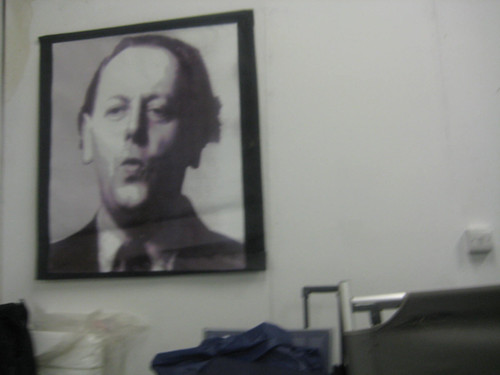
artist as farmers, and artists’ cultivation projects.
Residency and conference at The Elterwater Merz Barn by foundation Littoral, UK.
The Groeneveld forum
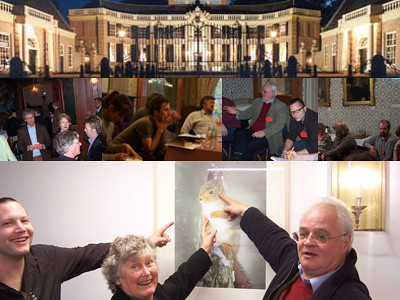
Linking Culture and agriculture as a strategy for a meaningful countryside.
Kasteel Groeneveld
Chickenhouse
Building a chickencoop with students at Öland folkhögskola
Harvestfeast 2008
Sentimentala kärl, post peak oil production
Malin Lindmark Vrijman Ett experiment att framställa brukskärl genom odling. Genom frön, mylla, sol, vatten och tid kan kärl tillverkas till mycket låg energi kostnad. För att återknyta till historien och göra kärlen välbekanta och tillgängliga för alla, formas frukterna i gamla plastdunkar, som i sin välkända form minner oss om en svunnen tid, då allt enkelt kunde framställas av petroleum produkter. Projektet genomförs med stöd av![]()
Mobile Chickencoop
Rapeseed oil press
Collection of the Verbeke Foundation
Right to farm the land

Right to farm the land
Cooperation between Plan3/Octava, Kultivator and Public globality gardens, with land from Råbelövs gods. In Swedish language, the expression ”farm the land” can be read both as the right to actually farm, thus grow crops in the soil, and as the right to use, or make use, of the land meaning a country, or national state.
During the project ”Right to farm the land”, the three groups Octava/plan3, Kultivator and Public globality gardens cooperated with Råbelövs gods, a big landowner in the south of Sweden, who was willing to provide one hectar of farm land for artistic purposes. (For a large industrial farm as his, 10 000 m² laying like this piece isolated in a forest, is too small to work in a profitable way.)
Close to this piece of land lies a suburb of the city Kristianstad, called Gamlegården (=old farm) that is home to a large community of people that migrated from rural areas in Somalia and the south of Iraq quite recently.
In this suburb we set up an office in an abandoned bankoffice in a small shoppingmall, and started interviewing people asking whether they had farming experience and interest in using a piece of land for growing food. During one week, the message was informally spread that for those who wanted, Rights to farm the land would be granted for at least one year and maybe longer. No costs, but also no help or support was connected to the Rights. The choice to hand over Rights rather than ”this piece of land”, was to avoid creating merely a set of allotment gardens, and imply that the right to make use of it could also apply outside the conventional structures of ownership.
The Rights to farm the land where handed out in spring 2008, and around 40 groups, individuals and families started to grow food. In spite of little Challenges like drought, wild animals and somewhat suspicious neighbours were conquered by the group’s own resources, with little coordination or external support, During Spring 2009, the group – with many fall outs and many newcomers – transformed itself into a formal collective that shares responsibility for water harvesting and working tools.
Law of conservation of energy
Film/Installation for the group exhibition ±Plus/Minus by SKART at our dear friends place “Yellow Box”.
We cut trees, chopped wood from our local forest and placed the wood in the living room of Yellow Box. Projecting at the same time a documentation of our work
Fire for friends
Making new friends
making new friends is a stategy for survival by enlarging kultivators group of friends
It was performed at “Supermarket” art fair in Stockholm, and culture week Nybro. Visitors could choose from a selection of vegetables seeds from the seedbank of Kultivators Ranchito. The seeds were planted in paper cups and marked with numbers. The new friends paid 100 swedish kr, and Kultivator promise to raise the plant and send images of how it developes, so that new friends can decide when to come by and harvest.
När Stureplan blev bonnigt

Open discussion:
How can culture, ecologi and economy meet
How to get the innercity of Stockholm sustainable
Mossutställningar, Birger Jarlsgatan 18A 4tr.
Moderatorer: Malin Lindmark Vrijman och Mathieu Vrijman, Kultivator.
Panel: Eva Helmenius, Vice VD, Kraft&Kultur, Elin Rydström, Lovö Prästgård Drottningholm, Stella d´Ailly, Mossutställningar, Mohamed El abed, Sprong kommunikation.
Arrangörer: Mossutställningar, Sprong
kommunikation.
Med stöd av LRF, Stiftelsen framtidens kultur, Brakspear Oxford Gold Organic.
Tower of power
Tower of Power` Marlene Lindmark and Malin L. Vrijman.
From the exhibition Between Reality and Fairytales in Högsby,
Sweden 2007, a collaboration between Kalmar Art Museum and Högsby.
Supermodel
Exhibition in W139, Amsterdam
‘Das Bild muß die funktion der Kartoffel übernehmen ‘Jörg Immendorf
On December 2005 my family and I moved from Haarlem to a newly-built estate in the country to the north of Nijmegen. Five days later W139 called to ask if I was interested in applying for the post of director. I spent a couple of sleepless nights trying to let the strange concurrence of events sink in, and considered the transition from artist to curator. I realised that the change of roles would mean I d have to take a stance on the social role of the visual arts. And one of the things that popped into my mind in the middle of the night was that a meeting of the minds between artists and farmers could be more important than the present one-sided flirtation of art and philosophy. This inspiration was born out of a healthy aversion to the wish-washy talk about the post-agrarian and post-industrial society . The ideology of the knowledge economy is tacitly based on a geographic distribution between lords and servants. Because the knowledge worker still needs to feed, clothe and warm himself with agrarian and industrial products. In the meantime, in the visual arts, the post-productional artist has emerged and, while his roots are in left-wing philosophy rather than neoliberal thinking, his disparagement of material production is the same. Critical faculties have become more important than creative ones.
KULTIVATOR is a collective of artists and farmers. On the island Öland just off the south coast of Sweden, the three Lindmark sisters and their spouses and children cultivate organic food, and host a residency programme and an international artists practice. In their first major retrospective in W139, potatoes and linseed oil, paintings and sculptures, sheepskins and films will be on show and on sale. The children of KULTIVATOR will live in a village of polyester igloos in the rear space of W139 and offer to trade their toys, comics and computer games.
El Parche was invited to build an installation for the exhibition. The artists collective El Parche creates meeting places were they address political and cultural issues. Graphic designer Floor Wesseling, who designed the wonderful KULTIVATOR logo, will make a paste-up about the agrarian history of the Bijlmer.
SUPERMODEL on Friday 12 October 9 p.m. will be opened by SUPERMACHINE; a procession of agricultural vehicles through the heart of Amsterdam.
Gijs Frieling. Members of Kultivator: Malin Lindmark Vrijman, Kalle Runeson, Mathieu Vrijman, Marlene Lindmark, Henric Stigeborn en Mia Lindmark
El Parche is a group of artists which includes: Herman Mbamba, Olga Robayo, Marius Wang
Thanks to: City of Amsterdam, Ministry of OCW, VSBfonds, SolarOil systems, Agripom, Loonbedrijf K.J. Tromp, Office for Contemporary Art Norway
During the exhibition there will be shown a Molkwerum-cabinet from the collectiion of the Zuiderzeemuseum in Enkhuizen.
Urgent secret
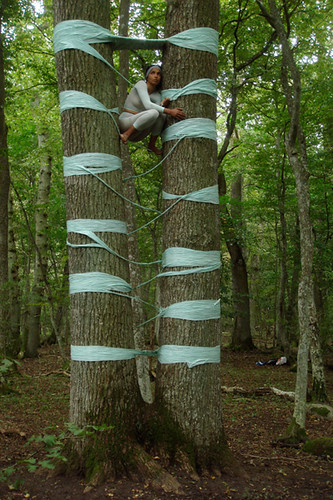
This video-performance has been realised in the forest of Dyestad (Sweden) during a residency in the Guest Atelier of Kultivator.
In terms of this new collaboration, Keity Anjoure wishes to question the intimacy between voice and identity, materialism and freedom, using the first and second degree of language and image
Production: ICILATER, Film maker: Francois Terrie Dance: Keity Anjoure, Visual editing: Stephanie Arrow, Sound editing: Stephanie Arrow and Jean-Pierre Royer, Translation: Ellen Charbonnel, Voices: Malin, Mia, Moa, Ivar, Gerard, Mimi, Nina, Oscar.
Earthworks 2007

Earthworks 2007 Environmental arts and agriculture experiment on site Site – specific – locally produced?
We consider this direction within contemporary artpractice to be the far most relevant at the moment, and we recognize that its resting on long traditions. One predecessor is legendary Robert Smithson, which can be seen as the one establishing the term “site specific” art. His Earthworks were sited “in the physical, raw reality” and related visually and tactile with the surrounding landscape. For Earthworks 2007, we have selected a varied group of emerging Nordic visual artists that will develop and explore the meanings of site specific works today. The artists we have selected to take part work in various contemporary disciplines, such as web based, graffiti/streetart, performance and social interventions, and will naturally work within their known techniques also here. Sited works in our understanding of the word would be works that are located in a specific place within a system and functions within that system. In the premises of Kultivator, which includes a dairy farm, vegetable fields and sheep and chicken breeding, many small scale systems for production can be found, and new ones are constantly invented. The invited artists will during a week long direct physical work go into these systems and create works that challenge (or confirm) the statements of our predecessors. Long term aim/purpose: With globalized society logic, production as ineffective as in our climate, can hardly be defended except from out esthetical or sentimental view. With strong visual statements from young Nordic artists, in contemporary media, we want to offer images of our agricultural landscape that are not sentimental, but heading forward toward new futures. Re- thinking the globalized trade logic into one that sees things in context, or, if you like, as part of a sustainable system.
Participants
Oscar Guermouche, El Parche, Bengt Olof Johansson, Marlene Lindmark, Benn Sena, Helena Wikestam, Lishar Eshkoly, Randy Albright, Kalle Runesson, Sara Sena da Silva
Ölands souvenir 2007
– for memory) is an object a traveler brings home for the memories associated with it. Souvenirs include clothing such as T-shirts or hats, and household items such as mugs and bowls, ashtrays, egg timers, spoons and notepads. They may be marked to indicate their origin: “A Souvenir from Clacton-on-Sea”.
In Japan, souvenirs are known as meibutsu (products associated with a particular region); and omiyage, candies or other edibles to be shared with co-workers. Omiyage sales are big business at Japanese tourist sites.
(Wikipedia)
On the island Öland, where Kultivator is situated, lives approximately 20.000 people all year round, and over one million tourists visits the island in the summer.
The tourist industry is crucial for the economy of the island. One important income for year round Ölanders is the purchase of inexpensive, small thing for tourists to buy; what we call souvenirs. In the exhibition/contest Ölands souvenir 2007, we made an open call for items that would make good souvenirs. People could send in totally new concepts for souvenirs, or just send in a product they already had for sale.
In the exhibition, we are also showing background stories from the maker for each piece, like selling arguments, but here often more personal and/or informastive.
In the regular case, you would choose your favourite souvenir by selecting what to buy. In this exhibition you can vote for the best one by putting a note in a box.
In the autumn, at the harvestfeast of the island, which is the last big tourist attraction before the island ”closes” for winter, we will count the votes and a winner will be named.
Roadkill
Installation/film at local food market, Kalmar.
About the travel of our daily food.
Fluid
Installation at Gallery Stenhallen, Borgholm
Juice 9

Food systems: the design agenda
DOORS OF PERCEPTION 9 ON “JUICE”: FOOD, FUEL, DESIGN.
NEW DELHI, INDIA, 2, 3 MARCH 2007.
A unique gathering of global design experts meets in New Delhi, India, on 2, 3 March to consider solutions to the growing crisis concerning food and energy.

